- Sell Online
- Help / Contact

Towing a Caravan: Everything You Need to Know Before Hitting the Road
- February 13, 2024
- caravan safety , caravanning
Section 1: Understanding Your Vehicle's Towing Capacity
Before you set off on your caravan adventure, it’s crucial to ensure that your vehicle is capable of safely towing the weight of your caravan. Familiarise yourself with the manufacturer’s guidelines regarding towing capacity, tongue weight, and load distribution. Exceeding these limits can compromise the safety of your journey, vehicle performance, and even void your warranty and insurance.
Towing Weight Calculator
Section 2: performing pre-trips checks.
Regularly inspecting your caravan and vehicle before every journey is essential for a smooth and safe trip. Take the time to check the tyres, brakes, lights, wheel bearings, suspension, and coupling to ensure they are in proper working condition. Additionally, verify that the weight distribution and load within the caravan are well-balanced to maintain stability on the road.
Section 3: Master Turning and Reversing
Towing a caravan can be challenging, especially when it comes to maneuvering and reversing. To avoid any mishaps, it’s advisable to practice these skills in an open space before hitting the road. This will help you develop a better understanding of how your vehicle and caravan respond to different steering inputs, making it easier to navigate tight spots and parking areas.
Section 4: Drive Smooth and Maintain Safe Speeds
When towing a caravan, driving smoothly and maintaining a safe and steady speed is crucial. Sudden acceleration, braking, and sharp turns can increase the risk of swaying or jackknifing. To minimize these risks, drive with caution and be mindful of your speed. Remember, it’s better to take your time and arrive safely at your destination than to rush and compromise your safety.
Setion 5: Maintain Safe Distances
Towing a caravan adds extra weight to your vehicle, which affects your braking distance. It’s important to increase the following distance between your vehicle and the one ahead to account for the added weight and potential longer braking distances. This will give you more time to react and stop safely, reducing the risk of accidents.
Section 6: Wind Conditions
Strong crosswinds can impact the stability of your caravan on the road. Pay close attention to weather forecasts and take precautions when traveling in windy conditions. Reduce your speed and grip the steering wheel firmly to maintain control of your vehicle and caravan. By being aware of wind conditions, you can ensure a safer and more comfortable journey.
Section 7: Rest Breaks
Long drives can be tiring, so it’s important to schedule regular breaks to rest and rejuvenate. Fatigue can impair your driving abilities and decision-making skills, increasing the risk of accidents. Make sure to plan your journey with sufficient rest stops, allowing yourself time to stretch your legs, have a snack, and recharge before continuing your adventure.
Section 8: Plan in Advance
In Australia, popular campgrounds can fill up quickly, especially during peak seasons. To avoid disappointment and unnecessary stress, it’s advisable to plan your route in advance and make reservations at your desired campsites. By doing so, you can ensure a hassle-free experience when you reach your destinations, allowing you to relax and enjoy your time in nature.
Section 9: Weight Distribution Hitches
Invest in a weight distribution hitch, it’s a valuable gadget to have when towing a caravan. This device helps distribute the weight evenly between your vehicle and the caravan, improving stability and control on the road. It also reduces the likelihood of trailer sway, which can be dangerous. If necessary, have your vehicle and caravan weighed to determine if a weight distribution hitch is required. By investing in this essential equipment, you can enhance the safety and performance of your towing experience.
Section 10: Extended Mirrors
Visibility is crucial when towing a wide caravan. Invest in extended towing mirrors that provide a clear view of the rear and sides of the caravan. This enhances your situational awareness, allowing you to safely change lanes or maneuver when necessary. It’s important to note that extended mirrors are not only beneficial for your safety but also a legal requirement.
Section 11: Packing Essentials
When packing for your caravan adventure, make sure to include essential tools, spare parts, and safety equipment specific to caravanning. It’s also important to secure loose items within the caravan to prevent shifting or falling during transit. By properly packing and securing your belongings, you can maintain stability on the road and avoid damage to both your vehicle and the caravan.
Section 12: Be Prepared for Road Conditions
Australia boasts diverse landscapes, which means you may encounter varying road conditions during your caravan journey. It’s essential to research your route and be aware of any challenging terrains or gravel roads. Adjust your driving technique accordingly to ensure a safe and smooth journey. By being prepared for changing road conditions, you can navigate any obstacles with confidence and minimise potential risks.
Section 13: Using Technology
Take advantage of technology to enhance your towing experience. GPS devices, smartphone apps, and online resources can provide real-time information on fuel stops, rest areas, weather conditions, and caravan-friendly routes. By utilising these tools, you can stay informed and make informed decisions that contribute to a more enjoyable and stress-free journey.
Section 14: Make Caravanning Friends
Caravanning is a popular activity in Australia, and you’ll often encounter fellow travellers on the road. Embrace the community and engage with other caravaners. Share tips, advice, and recommendations to enhance your experience. Fellow travellers may offer valuable insights about road conditions, hidden gems, or must-visit destinations. Consider investing in a UHF radio for improved communication and safety on the road.
Section 15: Keep Up-To-Date with Regulations
To ensure compliance and safe travel, familiarise yourself with the rules and regulations governing caravanning in Australia. Stay updated on towing speed limits, specific state requirements, and road signage. By staying informed, you can avoid potential fines and penalties while enjoying a worry-free caravan adventure.
Towing Regulations Per State / Territory
There are rules and standards for towing vehicles, parts and tools, including towbars and safety chains.
The towing vehicle
Vehicles must be suited to the trailer. Vehicle manufacturers usually indicate in the owner’s manual the maximum weight and other features of trailers appropriate for the vehicle. These limits should not be exceeded.
In terms of registration and compliance:
- all vehicles must comply with all relevant standards for registration and be roadworthy at all times
- rear number plates and lights must not be obscured by the towbar when there is no trailer connected.
Towing vehicles must be properly equipped with:
- towbars and couplings of a suitable type and capacity
- electrical sockets for lighting
- brake connections if the trailer is fitted with power or electric brakes.
Additionally:
- extra mirrors may be needed for the towing vehicle if towing a large trailer
- for vehicles with automatic transmission, an extra transmission oil cooler may be needed
- some vehicles need structural reinforcement and/or special suspension and transmission options and load-distributing devices to be able to tow heavier trailers.
A properly designed and fitted towbar is essential for towing. The rated capacity of the towbar and coupling should not be exceeded.
The towbar should be clearly and permanently marked with its:
- maximum rated capacity
- make and model of the vehicle it is intended for, or the manufacturer’s part number
- manufacturer’s name or trade mark.
This is compulsory for vehicles built after 1 January 1992. The exception is where the towbar is a permanent part of the vehicle.
Towbars must not protrude dangerously when there is no trailer connected.
Load equalisers
Load equalisers can be used when towing large caravans. Load equalisers:
- Help the vehicle retain normal suspension height and effective steering control
- Transfer some of the weight from the towbar to the front and rear suspension of the vehicle.
As load equalisers may overload the towbar and its components, check with the towbar manufacturer for advice before use.
The trailer
Trailers must be a suitable size and type for their intended tasks. They must be built to meet the standards for registration. If a trailer is required to be registered it must be fitted with a rear number plate.
Towing ratio requirement
The loaded mass of the trailer must not exceed the lesser of:
- rated capacity of the towbar and tow coupling
- maximum towing capacity of the vehicle
- maximum carrying capacity of the trailer
- maximum rated carrying capacity of the tyres.
If the vehicle manufacturer has not specified the maximum towing mass, the maximum towing mass is:
- one and a half times the unladen mass of the towing vehicle, provided that the trailer is fitted with brakes which are connected and in working order, or
- the unladen mass of the towing vehicle if the trailer does not require brakes.
Vehicles with a manufacturer’s GCM more than 4.5 tonne may tow in accordance with the above requirements. The GCM is the gross combination mass of the car and loaded trailer.
Braking system
The minimum braking system for a trailer depends on the type of trailer, its weight and the weight of the vehicle:
- 0 – 750 kg Aggregate Trailer Mass (ATM) – no brakes required (If brakes are fitted, they must comply).
- 751 – 2000 kg ATM – an efficient braking system on both wheels on at least one axle.
- 2001– 4500 kg ATM – an efficient braking system on all wheels.
Note: each trailer with a Gross Trailer Mass (GTM exceeding 2.0 tonnes must be equipped with an automatic breakaway system in case the trailer becomes detached from the vehicle.
Brakes must be operable from the driver’s seating position.
Towing coupling
All couplings:
- must be strong enough to take the weight of a fully loaded trailer
- should be marked with the manufacturer’s name or trade mark, and rated capacity
- must be equipped with a positive locking mechanism. The locking mechanism must be able to be released regardless of the angle of the trailer to the towing vehicle.
Safety chains
- Safety chains must comply with Australian Standards.
- Trailers less than 2500 kg when loaded must be fitted with at least one safety chain.
- Trailers over 2500 kg when loaded must be fitted with two safety chains.
To prevent the front end of the drawbar from hitting the ground if the coupling is disconnected, safety chains must be:
- as short as practicable and connected to the towing vehicle
- crossed over if two chains are fitted.
Towing vehicles and trailers
Towing a trailer requires additional driving skills and safety precautions. The trailer may be a caravan or camper trailer, boat trailer, horse float or special-purpose trailer.
The driver of the vehicle is legally responsible for being safe when towing a trailer, and ensuring the towing vehicle, trailer and tow couplings meet the minimum standards and loaded mass limits.
They will also find the drive more enjoyable if the combination is well designed and set up, and not overloaded.
Using a suitable vehicle
Safe towing starts with ensuring the tow vehicle is suitable to tow the trailer. You can select the right trailer or caravan to match your tow vehicle or buy a tow vehicle to suit your trailer type and towing needs.
While modern vehicles are lighter and provide better service for normal motoring, some don’t have the necessary characteristics for towing.
The owner’s manual usually indicates the maximum weight and other trailer features that are appropriate for the vehicle. You should not exceed these limits.
Towing will affect your vehicle in several ways, including:
- decreased acceleration and braking performance
- reduced vehicle control and manoeuvrability
- increased fuel consumption.
Therefore, when assessing the load, consider the weight of the tow vehicle and trailer, including:
- the number of passengers you intend to carry
- the equipment in the tow vehicle, such as tools and camping gear
- modifications to the tow vehicle, such as bull bars, long-range fuel tanks, supplementary batteries and roof racks
- caravan – may include water tanks, gas bottles, food and drink, clothing, toys
- boat trailer – may include fishing gear, safety equipment, boat motor and fuel
While driving
When towing a trailer (including caravans), remember to:
- allow for the extra length and width of the trailer when entering traffic
- allow for its tendency to ‘cut in’ on corners and curves
- accelerate, brake and steer smoothly and gently to avoid swaying
- allow for the effects of cross-winds, passing traffic and uneven road surfaces
- leave a longer stopping distance between you and the vehicle ahead; increase the gap for longer, heavier trailers and allow even more distance in poor driving conditions
- use a lower gear in both manual and automatic vehicles when travelling downhill to make your car easier to control and reduce the strain on your brakes
- allow more time and distance to overtake and avoid ‘cutting off’ the vehicle you are overtaking when returning to the left lane
- fit a reversing camera or get someone to watch the rear of the trailer when you reverse—reversing is difficult and takes practice
- not hold up traffic—pull off the road where it is safe to do so, and where it won’t create a build-up of traffic unable to overtake
- be aware that your vehicle and trailer will have a tendency to sway when a heavy vehicle overtakes you.
Towing equipment
Your vehicle needs to be equipped appropriately for the trailer’s type and size, including:
- tow bars and couplings of a suitable type and capacity
- suitable brake connections if required
- extra mirrors for towing large trailers if required
- optional rear-view camera—these help to see traffic behind you but do not replace the need for mirrors.
Towing a trailer
- The capacity of the towing vehicle must be suitable for the trailer to be towed.
- Towing vehicles must be registered in the correct registration category to tow a trailer that has an ATM over 4.5 tonnes.
Contact MVR for further registration information.
Generally, truck manufacturers show the designed towing capacity – which is called the gross combination mass (GCM) limit. This information may also be on the compliance plate or build plate attached to the vehicle.
The laden mass of the trailer in a vehicle combination (not being a road train) comprised of a rigid motor vehicle and a trailer must not exceed the laden mass of the rigid motor vehicle.
The towing attachment must also be suitably rated to meet towing requirements.
Towing with an A-frame
You can tow a vehicle (up to 4.5 tonnes gross vehicle mass) that is connected to the tow bar of another vehicle in the Northern Territory (NT) using a triangular shaped frame commonly known as an A-frame.
You should also check with your vehicle’s manufacturer to determine whether the towed vehicle is suitable for A-frame towing – eg: read the advice in the ‘Owner’s Manual’.
Your A-frame must be designed and marked as being suitable to tow the make and model of the vehicle being towed.
If it isn’t designed or marked, the A-frame and its connections will need engineering certification before you can use it.
General rules for towing another vehicle
The driver of a vehicle must not tow another motor vehicle unless it meets all of the following:
- the driver can control the movement of the towed vehicle
- the brakes, steering and rear lights including indicators of the towed vehicle are in working order
- the person who is licensed to drive the towed vehicle is in the driver’s seat and is in control of its brakes and steering
- it is safe to tow the vehicle
- the towed vehicle must be registered or have a current temporary licence.
here are a number of regulations that relate to how trailers are loaded and towed by light vehicles – gross vehicle mass (GVM) 4.5 tonnes or less. These regulations ensure that trailers are used effectively and safely, with minimised potential to harm individuals and other road users.
Towing trailers with a load
Before towing a trailer, make sure that all safety measures and towing regulations have been met.
The following information covers the key requirements relating to the towing of trailers. Detailed information is contained in the Road Traffic Act and Regulations, 1961 and Vehicle Standards Bulletin (VSB) 1 .
Towing mass limits
The maximum mass that can be towed by a vehicle is dependent upon a number of criteria. The loaded mass of a trailer or caravan must not exceed:
- The rated capacity of both the tow bar and tow coupling.
- The towing mass specified by the vehicle manufacturer, or the gross combination mass (GCM) specified on the vehicle’s registration certificate.
Note: The manufacturer of the towing vehicle may specify two different towing limits or the towing vehicle, depending on whether the trailer is fitted with brakes or not. They may also set requirements when towing, such as maximum speed and tow ball vertical loading.
No manufacturer’s specifications
If the motor vehicle manufacturer has not specified a maximum towing mass and a GCM is not specified on the vehicle’s registration certificate, the rules below apply. These vary according to the trailer’s braking system:
- For a trailer fitted with brakes directly operated by the driver, the mass of the trailer must not exceed 1.5 times the unloaded mass of the towing vehicle.
- For a trailer fitted with override or over-run brakes, the mass of the trailer must not exceed the unloaded mass of the towing vehicle.
- For a trailer not fitted with brakes, the mass of the trailer must not exceed the unloaded mass of the towing vehicle or a gross trailer mass (GTM) of 750 kg, whichever is the lesser.
If a trailer has no manufacturer’s specifications, it is still the owner’s responsibility to make sure the trailer must be safe and fit for purpose.
Trailer braking regulations
- Trailers must be fitted with brakes if the GTM exceeds 750 kg.
- For trailers built to VSB1 and Australian Design Rules (ADRs), override or over-run brakes are acceptable up to a GTM of 2 tonnes.
- For trailers built to UN ECE 13 (acceptable standard under ADR38/05), O2 category (GTM not exceeding 3.5 tonnes) override or over-run brakes are acceptable if fitted with a breakaway system and the trailer is a centre axle trailer.
- Where the GTM exceeds 2 tonnes the braking system must be fitted with a breakaway system that causes the brakes to be applied if the trailer becomes disconnected from the towing vehicle.
Trailer load projections and dimension limits
There are limits to how far loads can project from the back and sides of a trailer.
Side projection
A load must not project more than 150 mm from the outermost part of either side of the trailer and must not be more than 2.5 metres in total width (refer to Figure 1).
Figure 1. Side projection limits
Length of vehicle and trailer
The overall length of the towing vehicle and trailer must not be more than 19.0 metres. The rear of a load on a vehicle must carry a warning signal if the load projects more than 1.2 metres or cannot be easily seen (refer to Figure 2). In the daytime, the warning signal must be a brightly coloured flag measuring at least 300mm x 300mm. At night, the warning signal must be a red light that can be seen for 200 metres.
Figure 2. Front and rear projection limits
Rear projection
Measured from the centre of the trailer axle, or axle group, a load must be:
- not more than 3.7 metres
- no longer than the length of the load in front of the axle, or axle group.
Figure 3. Rear projection
Trailer lighting and wiring
Lights on trailers must operate in unison with those of the towing vehicle – ie the indicator, brake, tail and reversing lights, where fitted, must go on when those of the towing vehicle goes on:
- Required trailer lighting, at the rear of the trailer.
- Number plate light – may be combined with the taillights.
- One pair of brake lights.
- A pair of tail lights – may also be used to delineate the number plate.
- One pair of direction indicator lights may also be used as hazard lights if necessary.
- One pair of red reflectors.
If the trailer is more than 2.2 metres wide, reflectors must be fitted symmetrically to the front of the trailer and within 400 mm of the sides of the trailer. All trailers are required to have an earth wire connected through the wiring back to the towing vehicle. All wiring must be secured at least every 600mm.
Towing rules
A trailer must be securely coupled to the vehicle towing it and must have a safety connection such as a chain or cable that will keep the trailer connected to the towing vehicle in the event of accidental disconnection.
- with a person in or on the trailer
- if the load is placed in a way that causes the combination of towing vehicle and trailer to be unstable.
- The load on a trailer must be safely secured or restrained before moving onto a road.
- If an item falls from the trailer onto the road, it is the driver’s responsibility to remove it from the road.
- Penalties apply if a load is not secured properly.
- A trailer must not be towed unless it meets all the mass, lighting, and braking requirements and is roadworthy.
- A light motor vehicle may tow no more than one vehicle.
There are specific road rules that apply to motorists towing caravans, camper trailers, horse floats, boats and more:
- The maximum legal speed limit for any vehicle towing a trailer or caravan is 100km/h.
- Vehicles towing a caravan or trailer must drive at least 60m behind heavy vehicles or other towing vehicles, unless overtaking. Drivers of road trains or B-doubles must maintain a following distance of at least 200m, unless overtaking.
- People are not permitted to ride in a trailer or caravan that is being towed.
- Failure to properly secure a load will attract a $150 infringement.
- If you are towing a load wider than your vehicle, you must have towing mirrors in place.
You must not drive a vehicle that is carrying a load:
- If the load makes the vehicle unstable or otherwise unsafe.
- If the load projects from the vehicle in a way that could injure a person, obstruct the path of other drivers or pedestrians, or damage a vehicle or anything else (including the road surface).
- Unless the load is restrained on the vehicle so that the load, or any portion of it is unlikely to fall or become dislodged from its restraints.
Be sure you know the legal load limit for your vehicle and make sure your load is well secured as incorrectly secured loads can cause rollovers. Add 200kg to the weight shown on the vehicle licence paper to allow for bedding, travelling gear, stores, and equipment. Be courteous in sharing the road with other users. Check your rear vision mirror regularly to see if traffic is building up behind you. If you are holding up traffic, pull over and stop when it is safe to do so. There are 1,648 Main Roads WA rest stops and amenities around WA to avoid fatigue. If you wish to drive on unsealed roads in remote areas, ensure that your caravan or camper trailer is built to handle these tough conditions (check with the manufacturer). Make sure it has four-wheel-drive tyres with a high clearance and upgraded suspension that can withstand corrugations and rough road surfaces.
In Conclusion...
In conclusion, towing a caravan in Australia can be an incredible adventure, allowing you to explore the country’s breathtaking landscapes. By following these top 15 tips, including understanding your vehicle’s towing capacity, practising safe driving techniques, and staying prepared, you’ll be well-equipped for a smooth and enjoyable journey. Remember, responsible towing practices, regular maintenance, and attention to safety guidelines are essential to make your caravanning experience both memorable and safe. So, get ready to hit the road and create unforgettable memories on your caravan adventure in Australia!
Ready For The Next Great Adventure?
Please share this post..., you might also be interested in..., top 10 caravan destinations for spring in australia, queensland roads: a state of hesitant drivers, despite the surge in recreational road travel, hybrid caravans – the lowdown.
Buying and selling made simple.
Explore Listings
Help and support.
- Dealer Page
- Banner Advertising
Caravan Chronicles
~ not just another caravan blog.

Understanding the dynamics of towing
This article is designed to give you an insight into what’s going on when you are towing a caravan. No matter if it is your first time or you are seasoned veterans, I hope that there will be something here that expands your knowledge and helps you understand what’s actually happening when towing.
I won’t go into what the maximum weight your vehicle can tow, there are lots of guides available on the Internet for this and how to understand the match between tow vehicle and caravan. There are also guides that tell you what you can legally tow with your driving license.
This guide has been written in response to some of the questions that have been asked on various forums and has been updated several times since it first appeared as an article on one of the UK forums.
Under acceleration or braking, if the caravan is in line with the vehicle, the forces acting will always be in a straight line, however, if the caravan and towing vehicle are not aligned the forces under breaking conditions will have a different effect.
Caravans have two types of braking systems – “over-run” and electronic. Electronic brakes are more common on continental and American caravans and not often found in the UK. The most common system in the UK is the “over-run” type brakes. There is also a hybrid of this, one of the well-known caravan chassis and hitch manufacturers offer a stability system. This is a device to electronically operate the caravan over-run brakes in the event of the caravan becoming unstable whilst being towed. We will concentrate on the most common type, over-run brakes, but the effects are almost the same no matter what braking system you have.

However, there are limits, if a caravan is overloaded for example, the tension device may not be able to resist the mass of the caravan pushing into the rear of the towing vehicle and the force acting on the brakes may be more than the designer allowed for and lead to the caravan wheels locking up completely. Tyres also have an affect, if they are badly maintained (under or over inflated, worn tread etc) the grip on the road surface will differ to the manufacturers original calculations and will affect the efficiency of the braking system.

Another effect on braking efficiency is the forces acting in a vertical axis. If the caravan and towing vehicle are correctly matched, the hitch height (see “ Understanding all about tow ball height…” ) will be in line on both units. Therefore any forces transmitted during braking will be in line, but we will see shortly why this might not be the best position.

In practice it is unlikely that the hitch hight will be high enough for this to be an issue but it is worth mentioning so you can appreciate that there are numerous things, however small that can affect the overall stability of the tow vehicle and trailer combination.
The centre of gravity of a caravan is designed to be as low as possible to make it tow as safely as possible. Good advice is always to load heavy items on the floor – awnings etc and keep the overhead lockers free from heavy items. Due to the way the caravan is constructed and if correctly loaded the centre of gravity is always in front of the axle and above it. However, because of the distance between the centre of gravity and the hitch, the effect of braking (or accelerating) means in practice there is a limited change in the nose weight. This can be demonstrated quite easily, if you put a 20Kg weight directly over the axle and measure the nose weight, then move the 20Kg forward by 500mm the actual increase in nose weight is only a few Kg’s. Under braking the whole mass of the caravan moved forward slightly but because of the lever arm distance from the pivot point (the axle) to the hitch, the actual weight transferred to the hitch is not excessive. The height of the centre of gravity above the axle will affect the transfer of weight, the higher the centre of gravity the more weight will be transferred. The height of the centre of gravity above the axle is also important for lateral (side to side) stability.
It is a good idea then that we tow with the caravan slightly “nose down” and here’s why.

However we also have to consider something else. Vehicles always have larger brakes at the front than at the rear and there is a good reason for it. The designers take into account the ‘weight shift’ under heavy or emergency braking and know that they can put much more braking effort into the front axle than the rear. So if the caravan imparts too much nose weight under braking, although the rear brakes on the vehicle are assisted by extra load pushing down, the braking ability of the front axle is reduced as the centre of gravity change (weight shift) in the braking action is reduced.
This is one of the reasons there are nose weight limits on the tow hitch of the towing vehicle. It’s not the strength of the tow bar or tow ball, but the manufacturer has determined what the maximum load can be for all sorts of reasons including what effect it will have on the braking efficiency and performance of the vehicle.
It’s all a balancing act, so don’t exceed the vehicle or caravan nose weight limits, or load the caravan above its MTPLM and keep all your heavy items in under seat lockers.
Understanding a twin axle

Assume the distance between the wheel hubs is 1000 mm and in balance, the centre of mass is 500 mm, directly between the wheels. This will be our datum, so in balance it will equal zero.

It can be seen that by moving the total mass of the caravan forwards by 31.25 mm, the loading on the front axle increases by 50 Kg and on the rear reduces by 50 Kg. Moving the total mass of the caravan forward by 62.5 mm will increase the load on the front axle to 900Kg and reduce the rear to 700Kg.

It can now be seen that moving the 200Kg load forward by 250 mm has the effect of increasing the load on the front axle to 850Kg and reducing the rear axle load to 750 Kg. Move the load forward by 1000 mm and the load on the front axle is now 1000 Kg and on the rear axle it has dropped to 600 Kg. The front axle is now on our maximum tyre loading of 500Kg! Obviously this is in an uncoupled trailer, as it’s easier to calculate. Once coupled to a tow vehicle some of the forward loading will be taken up by the tow vehicle hitch.
One additional factor to consider is the brakes on a twin axle caravan. On early twin axle caravans some brakes only affect one axle, usually the front one. We have to take into account that some pitching (the caravan rocking front and rear) when towing due to undulations in the road, potholes etc, so manufacturers often specify a minimum nose weight (please check with the manufacturer of your caravan for more information) to ensure that even in a pitching motion, there is sufficient load on the braked axle for the brakes to work efficiently as the manufacturer intended.
However since October 1982 all wheels must be braked on a twin axle caravan or trailer that has a weight rating above 750Kg.
Nose Weight.
It does not matter if you have a single axle or twin axle caravan, there are four things that need to be checked:-
• The manufacturer of your vehicle will have specified a maximum nose weight that can be applied to any towing hitch installed on the vehicle.
• The manufacturer of the towing hitch will have specified a maximum nose weight that can be applied to the tow bar.
• The manufacturer of the hitch fitted to your caravan will have specified a maximum nose weight that can be applied through the hitch.
• The manufacturer of your caravan will have specified the maximum nose weight that can be applied.
For some vehicles, the recommended nose weight loading will be the same as the tow-bar loading as they are usually manufactured as “OEM” parts for the vehicle manufacturer. Sometimes though, the tow-bar might have been an after market fitting and will carry the relevant EU approval, BUT might have a different nose weight loading to the original equipment fitted tow-bar. It is essential therefore you check both. In most 4 x 4’s (Land Rovers for example) the maximum nose weight can be as high as 150Kg, but most of the popular hitch types the limit is 100Kg. Some caravan manufacturers recommend a maximum nose weight of 80Kg.

In this case, the maximum nose weight that can be used is 85 Kg. It is always the lowest weight in the table!

We can calculate where to put the load inside the caravan to obtain the correct nose weight, but in practice, it is easier to just simply weigh the caravan at the point of the hitch. There are special gauges to do this, but simply using a pair of bathroom scales and a short piece of wood placed between these and the tow-hitch can achieve the same results.

Next we want to measure the height between the top of the bathroom scales and the underside of the caravan tow hitch.
Measure from the scales to the underside of the hitch. If you intend using a section of broom handle so it fits inside the hitch, don’t forget to allow for this measurement.

Once the jockey wheel is clear of the ground, you can now simply check the nose weight by reading what is on the bathroom scales. If the reading is higher than you want, lower the jockey wheel, apply the handbrake and adjust the load in the caravan by moving something forward of the axle back a little towards the rear.
Now let’s think about that for a moment. What could happen, is to get the correct nose weight, you could have to move a lot of stuff to the rear, in fact too much stuff too far to the rear. What are the effects of this!

In order to reduce the dumbbell effect, it is essential to keep the mass towards the centre of the pivot point. It may mean just lying the awning on the floor directly above the axle, but in some cases, it might mean removing heavy items from the front locker and stowing them in the caravan or in the boot of the car. Moving any weight from the caravan to the towing vehicle is always a good idea. As a general rule, the heavier the towing vehicle and the lighter the caravan the easier it is to tow.
What nose weight should I use?
There isn’t a simple hard and fast answer to this. Nearly all the motoring organisations, caravanning clubs and towing associations recommend the following advice:
The Nose Weight should be between 5% and 7% of the loaded trailer weight.
Again, with some combinations of caravan and towing vehicle, the maximum nose weight specified by the vehicle could be less than the recommended 5% to 7% (This is usually with a light car and a heavy caravan, but be careful, there are some 4 x 4’s that have a surprisingly low nose weight limit)
As I said at the beginning, I won’t go into what the maximum weight your vehicle can tow, there are lots of guides available on the Internet for this and guides that also tell you what you can legally tow with your driving license.
Can I just load up to the maximum nose weight my car and caravan allow?
Yes you can… but hang on a minute, let’s think about this. Remember back at the start we went through some of the forces acting on the towing vehicle. In the braking example, we decided that towing slightly nose down was the best option, and we discovered that under braking forces, the caravan imparted a downward force on the rear of the vehicle, well this will increase the nose weight and if you are loaded to the maximum nose weight permitted for your combination, the act of braking will take your nose weight over this limit. Most of the components are engineered to take more than the specified limits, but to continually exceed this under braking will contribute to increased fatigue on all the components, in addition, the over-run system will be subject to increased lateral forces and may not work as efficiently or as smoothly as the manufacturer intended. So be careful if you are loading close to the nose weight limit.
Other Effects
“Dutch Roll” is a tendency for the caravan to not only pitch forward and backwards, but roll from side to side as well. This is usually most common on motorways where the inside lane has been worn down to two grooves by heavy goods vehicles. What happens is one side of the caravan will settle into a groove and the other side will ride on the edge of the adjacent groove. This will set up a rolling motion in the caravan, and will have the effect of trying to move the hitch from side to side. As the vehicle and caravan travel forward, the undulations will also set up a rocking backwards and forwards motion in the caravan, which has the effect of first lightening the load (nose weight) on the hitch, then increasing it. The combined effect of this is the caravan hitch will move in a circular motion first sideways then down, then sideways in the opposite direction and finally upwards again, repeating continuously. In some vehicles this can be felt more than in others ( see Pt 2 for the reason ) , and sometimes you can have a passenger that normally is OK, but when you are towing, might complain of feeling a little travel sick.
Usually, the effects of this can be minimised by changing your speed slightly. You might also notice a similar effect as a large vehicle overtakes you, it first draws you towards it as the flow of air round you and the vehicle cause a pressure drop between the vehicles, then a push away as the airflow changes and the new flow creates a pressure wave between the two vehicles.
Wind Loading and Nose Weight

We are in effect, towing a flat wall into the wind, the effect this has on the caravan is to try to pitch it backwards on its axle, which as we know from working out the nose weight, moves the effective centre of gravity rearwards and as a consequence, will reduce the nose weight on the hitch.
Drag increases with speed, in fact drag is proportional to the square of speed ( R ∝ v2 ) so, in simple terms, if you are doing 30 Mph and accelerate to 60 Mph, the drag at 60 Mph will be four times the drag that it was at 30 Mph.
Now the formula for calculating power required to overcome aerodynamic drag is:

What this means is if you double your speed the drag increases by a factor of 4, but as you are now doing the work twice as fast (you have doubled your speed) the power required increases by a factor of 8. Effectively you will need eight times as much power from your engine to overcome the drag at 60 Mph than you did at 30 Mph to maintain constant speed.

Effects of Inclines.

The centre of gravity on an incline is angled directly downwards when looking from the front, and if viewed from above slightly off to one side in the direction of the downwards slope. If you were to take the hand brake off, as the centre of gravity is in front of the axle (it has to be because of the nose weight) there will always be a tendency for the hitch to move down the slope.

Understanding the dynamics of towing – Pt 2
In Part 2 we look at the affects the wheel base length and tow bar length (rear axle to tow ball distance) has on towing your caravan or trailer.
Further Reading: A friend and noted fellow author of caravan books – Collyn Rivers has recently updated his article on “ Caravan Dynamics “. While primarily based on caravans for the Australian market it is an excellent article and well worth taking some time out to read it along with a companion article: “ Making Caravans Stable “.
Copyright © 2011 – 2020 Simon P Barlow – All rights reserved
Share this:
26 thoughts on “understanding the dynamics of towing”.
January 12, 2020 at 5:57 am
Very good info. I needed this, Thank you very much for your advice
May 26, 2019 at 12:25 pm
Hi Simon, I am well aware of the work done by Bath University and Bailey caravans . I have offered my van and the device free of charge to anyone who has the competence to market it and they would have nothing to lose if It does not do what I say. I have tested the concept on various caravan sites and had nothing but negative comments – I wanted to see if it was worth patenting. I think market forces are at work here,. engineers who asked where does your device get the energy to operate and how can it possibly sense the yaw to how do you apply a equal force a the centre of equilibrium – my word what is our country coming to. The energy is derived from the inertia of the moving vehicle, it is sensed from a simple rod connected to the tow vehicle, the latter question will remain my secret since this is what no one has been able to work out and this is what makes it Proactive and completely covers every aspect of uncontrolled sway. One of the main problems here in Europe that suppresses innovation is Type Approval that prevents existing modifications. I have been at pain to ensure that my device is completely overridden by the approved system on the caravan therefore it is classed as an accessory and can be retrofitted to any trailer with overridden brakes. On a test track it survived a 40 degree jackknife from 40mph which I was well pleased with, nothing on the market can do this and no electronic device can be regarded as proactive since they all require a number of oscillations before their systems can trigger by which time it would be to late.AlKO are very wrong when they say the forces at play cannot be mitigated – they need to stop thinking this way. My system is PROACTIVE and prevents a sway from starting long before it reaches a critical level.and it does not control speed – there are limits as my calculus workings have shown.
PS When a sway occurs the appropriate individual brake is applied this has more than enough energy to steer the van back inline,however, if nothing else was done the return would be to much to keep it inline so the system has to apply an equal amount of energy to the opposite side wheel brake to maintain the inline position, this happens in milliseconds and the amount of force is a mechanical loop in other words as soon as the brake is kissed the brake automatically backs off.
I’m sure you will need some time to think about what I have stated so be my guest.
May 25, 2019 at 8:42 pm
Very interesting and accurate but if I may add to this with something you may wish to consider. I am a qualified transport engineer and have been interested in vehicle stability for over 40 years and I became aware that no one had accurately described why a snake or uncontrolled sway occurs and this make it impossible to find a solution or cure. So I studied the problem and found from experiments and the use of high level maths (Calculus) that in all situations there are limits and these can be found by using the latter. I will try to be a brief as possible but hope you will be able to see for yourself my conclusions.
When the trailer begins to oscillate from a side force it will rotate around the trailer axle, in most situations the tow vehicle will hold it steady, assuming all the correct measures have been established, This is not a true simple harmonic motion since there are tyres in a midpoint that prevent this. Now this is perfectly normal, however, if the side force is very high then the trailer starts to swing about the tow ball and the tyres begin to steer through the slip angles. and the force on the tow ball vector begins to push the rear tow vehicle harder until at the extreme ends of the swing the force is so great it momentarily applies the overrun brakes and this releases the energy built up from the swing thus catapulting the whole trailer at high energy across to the other side yaw and thus you have a situation that cannot be stopped in seconds – on average in just three swings and the whole combination is lost.
I have developed a system I called “Differential Stability” that will prevent uncontrolled sway from ever starting. It does this by combining two control systems integrating each in a controlled sequence. The first is a powerful hydraulic sensing connection to stop small swings up to 3 degrees and then through an ingenious arrangement applies a braking force to an individual wheel on the trailer and because it activates at 3 degrees and above the trailer immediately responds and is checked and returned towards the inline position within a fraction of a second. This though would not be good enough because the trailer could swing back and go beyond the inline position. Therefore it applies a force equal and opposite to the swing at or on the centre of equilibrium to positively correct the sway. It does all of this without any electronics or motors involved in the operation. To date I have used this system on very harsh terrain and autoroutes across France and the pyrenees mountains for 18,000 miles where the continental heavy traffic is very high. It has never shown any sign of instability. Just to add to the mix I carry two electric cycles on the rear of the caravan and I can travel on the French Autoroutes at legal speeds of 80 mph but I usually cruise along at 70mph for economic reasons. My outfit is a 2007 Peugeot 407 HDi and the trailer van is a Bailey Pageant single axle all up weight is 3.2 tonnes. Nothing special but I do stiffen the rear tow vehicle with rubber to stabilize the hitch height, I would just add that my system does introduce a pitch suppression 5 times that of the ALKO friction hitch and I also have added dampers to the caravan suspension. No electronic offering can match the performance an security this offers – I always ensure loads are well placed and weighed but it will tolerate misjudgments and just complain but never loses control.
May 25, 2019 at 11:55 pm
Hi John I’ve been looking at this for a while, hence my original articles. There has been a tremendous amount of work done by Bristol University in conjunction with Bailey Caravans around the stability of trailers. It might be worth having a look at their work. There is a great thesis written by one researcher for his Phd that is available on line.
My good friend and colleague Collyn Rivers, who was an automotive design engineer involved in designing suspension systems for around 40 years in Australia has written extensively on the topic and recently published a new book covering the subject. (Why Caravans Roll Over and how to prevent it – http://rvbooks.com.au/ )
The situation is a little more complex than a single pendulum. It is intact a double pendulum ‘machine’. The first is pivoted on (or just behind dependant on two or four wheel drive) the centre point of the front axle and the second as you have described pivoted on the tow hitch. One key interaction is the phase change which is a cause for instability on the twin pendulum ‘machine’. Considerations for the first pendulum have to take into consideration the ratio between the distance between front and rear axles to the distance between the rear axle to hitch pivot point. Again consideration has also to be given to the choice of a solid beam rear axle with leaf springs or IRS setup with ‘coil over shocks’ (IRS does tend to behave less well when towing) as this has a marked effect not he the resultant effect of the second pendulum over the first. There are other factors too… slip angle of the tyres and roll centre height of the caravan and line of roll centre.
I’d be interested to hear more on how you mitigate trailer swing.
May 26, 2019 at 11:15 am
Hi Simon, I am in complete agreement with your reply,however,much has been written on the subject yet there is still no solution to the problem from any industry source. I am fully aware of the work done by Bath university and I have offered Bailey caravans the opportunity to view my innovative concept, even offering to give my caravan free of charge with the device fitted to allow them to see what it can do alas they and others have never taken up the offer. There must be market forces at play here and perhaps they hope it will go away. I tested the concept on various caravan sites to find out the reaction from users the purpose was to decide if it was worth Patenting, the reaction was very negative so I have held back. Most simply were trying to find out how I made it work. I found much anger because I would not divulge the most ingenious arrangement to do what it does and I can tell you it is so simple it would take the industry by storm and just maybe stop people migrating to Motorhomes across Europe.
When I first declared the concept here in the UK I was staggered by the response from so called engineers who asked where does your device get the energy to operate and how can it possibly sense the yaw to how do you apply a equal force a the centre of equilibrium – my word what is our country coming to. The energy is derived from the inertia of the moving vehicle, it is sensed from a simple rod connected to the tow vehicle, the latter question will remain my secret since this is what no one has been able to work out and this is what makes it Proactive and completely covers every aspect of uncontrolled sway. One of the main problems here in Europe that suppresses innovation is Type Approval that prevents existing modifications. I have been at pain to ensure that my device is completely overridden by the approved system on the caravan therefore it is classed as an accessory and can be retrofitted to any trailer with overridden brakes. On a test track it survived a 40 degree jackknife from 40mph which I was well pleased with, nothing on the market can do this and no electronic device can be regarded as proactive since they all require a number of oscillations before their systems can trigger by which time it would be to late. I’m sure you will need some time to think about what I have stated so be my guest.
May 26, 2019 at 11:35 am
A few years ago I looked round at a number of different systems for electronic braking on caravans and one system in particular caught my eye as I thought it was quite clever in its simplicity – InSync Brake Assist. A number of units were made and there was even some interest by one of the main clubs. The unit was taken to Holland and tested there on one of their caravan test tracks… and the performance was convincing. I did intend to fit one to our caravan but it seems that market forces were brought into play and the unit ‘disappeared’ so to speak.
Having driven trailers with electric brakes I’m convinced that it’s something that we should be working towards. I’m also convinced that some of the sway accidents might have been mitigated… it is human nature to apply the brakes if a sway is developing… even though you know not to the instinct is difficult to suppress. I know form my instrument pilot training that to suppress what your inner ear is telling your brain and holy rely on your eyes focused on the instruments is a skill you have to learn over many hours of practice.
I did look at the ‘kit of parts’ available from Al-KO and I think it would be possible to install their electric brake back plates with the overrun brake system therefore conforming to UK/EU regulations and being able to use a brake controller in the tow vehicle. However an initial approach to Al-KO to understand if this was technically possible was met with stony silence.
IKB must be spinning in his grave at the lack of engineering enterprise nowadays.
May 26, 2019 at 12:34 am
This snaking and often consequent rollover is sadly only too common in Australia (over 250 in 2018). It is mainly as a result of attempting to tow up to 3.5 tonne by a tow vehicles of 2.5 tonne. All trailers here over 2 tonne (and that’s most of them!) have power brakes activated by the tow vehicle.
Yaw build up finally causes the slip angle of the tow vehicle’s rear tyres to exceed the front – resulting in ultimate oversteer. This action has been well described by Bath University’s Prof Jos Darling. This can to some extent be counteracted by running the tow vehicle’s rear tyres at 50-70 kPa (7-10 psi) higher than the front. But the yaw forces created when a 3500 kg caravan starts to yaw at 100 km/h are so huge that rollovers are inevitable. Our caravan industry sadly has little technical knowledge re this.
The ‘correction mechanism’ you describe is virtually that of the US Tuson Dexter system that applies differential braking such as to cancel the yaw. The UK/EU’s AL-KO system (that applies braking in bursts to all braked caravan wheels) seeks mainly to reduce the speed below that at which (what in effect is ‘chaotic’) action is triggered.
Both makers, however, emphasise that the yaw forces are very strong and the no such mechanism can overcome the more basic laws of physics.
Speed is a major factor in Australia – where tow speed limits are mostly 100 to 110 km/h.
My relatively new book – ‘Why Caravans Rollover’ – and how to prevent them’ attempts to explain all in plain English – but includes a full theoretical explanation. I do also cover this issue on my website rvbooks.com.au.
In essence, the issue is the 180-degree phase shift introduced by the overhung hitch plus what in effect is a positive feedback loop fueled by a yawing rig’s momentum.
Collyn Rivers (rvbooks.com.au)
October 24, 2017 at 12:16 am
Hi Simon we are newbies at this caraning. Could you tell me what we are doing wrong. I. Find that the motion of the caravan (a sort of lurching motion) is really getting to me when pulling the caravan. We have checked the tyre pressures, and tried putting extra 40kg in the front, but no difference. We are pulling a 978kg with a Subaru Legacy. 2.5 litre. Would appreciate any help. Thank you
October 26, 2017 at 10:15 am
Hi Faye There is usually some pitching motion when you tow a caravan, but a few things to check…
Check the rear tyre pressures for the tow vehicle when towing in the vehicle handbook. Usually you have to increase the pressure in the rear tyres above the normal pressure.
You need to check the maximum nose weight your vehicle and tow bar are rated for (the nose weight is the weight of the fully laden caravan imparts on the tow ball) There is a maximum weight (in Kilograms) that the vehicle and tow bar are rated for. Do not exceed this weight!
You will now need to check the caravan and a simple way is using a pair of bathroom scales and a piece of wood about 100mm square and 350mm long. Place the scales and piece of wood under the caravan hitch and lower the caravan hitch down onto the block using the jockey wheel until all the weight if the hitch is on the wood. Read off the weight on the scales. From memory I think the maximum nose weight is 82Kg – please check this for your specific vehicle !
Adjust the load in the caravan to around 5 to 10 Kgs below the maximum nose weight. Don’t place heavy objects rear of the axle to reduce nose weight as this makes the caravan unstable.
Finally, it would be worth checking that the caravan is not overloaded. Have a look for a public weigh bridge in your area and take your caravan – fully loaded – and get it weighed.
October 26, 2017 at 11:01 pm
It is not uncommon to find that people increase the tow vehicle front tyre pressures when towing. This is counterproductive when they already have less weight on them. It is usually necessary to increase rear pressures by about 5 psi and reduce front pressures by 3 psi. The main thing is to have pressure difference.
Collyn Rivers Caravan and Motorhome Books Sydney – Oz.
Pingback: Why caravans roll over
October 18, 2016 at 7:58 pm
Wow what an article Simon, as a caravan newbie I have picked up so many hints and tips from this blog! Thank you. I’m sure I will find many more ideas and tips from your other articles!
Pingback: Weight distribution hitch tightness
Pingback: reducing caravan sway
Pingback: Do you need a Weight Distributing Hitch?
March 5, 2016 at 11:39 am
Anyone considering towing a caravan or large trailer with a car, suv or pickup should read this to fully understand what is happening and why. Excellent article
Pingback: Viano engine problem when towing - MBClub UK - Bringing together Mercedes Enthusiasts
Pingback: Caravan Dynamics | Caravan and Motorhome Books
Pingback: Making caravans stable - here's how
Pingback: Caravan Rollovers - Caravan and Motorhome Books
October 14, 2014 at 3:30 am
Great explanation Simon – I envy your writing style – accuracy plus easy reading. Collyn
October 6, 2014 at 7:18 am
thank you really appreciate your response
October 14, 2014 at 3:28 am
Tony Simon has advised you have attempted to contact me and that I have not replied. I can be contacted via my website caravanandmotorhomebooks.com .
October 6, 2014 at 3:20 am
thankyou for writing such a detailed article I have just purchased a new family van 2970kg with a ball weight of 295 the ball weight was measured when our van was packed which included 180lts of water I would guess fully loaded the van would weigh 3400kg I tow the van with landrover discovery 4 on our first trip the van was pushing the car all over the road the van didnt seem to sway however the car felt like it was on tram tracks and my whole family could feel the van pushing us around now everything is packed to the front of the van the van and car are riding level on off road independent suspension thanks to the airbag suspension the landrover factory hitches sit allot lower than most 4wds they loop up from under the bumper there is an after market hitch that comes out of the bumper could this make a difference do you have any suggestions cheers Tony
October 6, 2014 at 7:10 am
Hi Tony I guess from your email address you are based in Australia as I don’t know of any caravans in Europe that are that heavy.
The OEM Land Rover tow hitch is designed to be 350mm to 420mm from the ground when the vehicle is loaded (I think the Australian limits are the same as the European limits) and in Europe the maximum nose (tongue) weight for the Discovery 4 is 150Kg so if your 295 figure is correct you are exceeding Land Rovers limit.Additionally European Caravans are usually fitted with AL-KO AKS hitches which have a limit of 150Kg for the nose weight, but caravan manufacturers specify a 100Kg limit.
Australian caravans are designed differently than European caravans in the fact that they usually have the axle(s) further back and to help control the nose weight usually move the main mass of the caravan rearwards… kitchen in the back, spare wheels on the rear bumper and because of this are less stable than European caravans.
There is a website that you might find useful: http://www.caravancouncil.com.au/
As I have no experience of Australian caravans except through my email conversations with Collyn Rivers, probably the foremost authority on towing and caravan stability in Australia, it would be difficult for me to offer any advice. Collyn’s website is: http://caravanandmotorhomebooks.com/
It would be worth joining one of the Australian caravan forums: http://caravanersforum.com/ and asking you questions on there. I know Collyn is active on here from time to time.
Sorry I can’t be of much help, although my Land Rover knowledge is fairly good I would hesitate to offer advice setting up for a caravan I didn’t know.
Pingback: Noseweight Woes | I've got an idea
Leave a comment Cancel reply
- Already have a WordPress.com account? Log in now.
- Subscribe Subscribed
- Copy shortlink
- Report this content
- View post in Reader
- Manage subscriptions
- Collapse this bar
- REQUEST BROCHURE
- PARK VISITS
- Northumberland
- Touring Caravans
- HOLIDAY OFFERS

Towing A Caravan – The Complete Guide
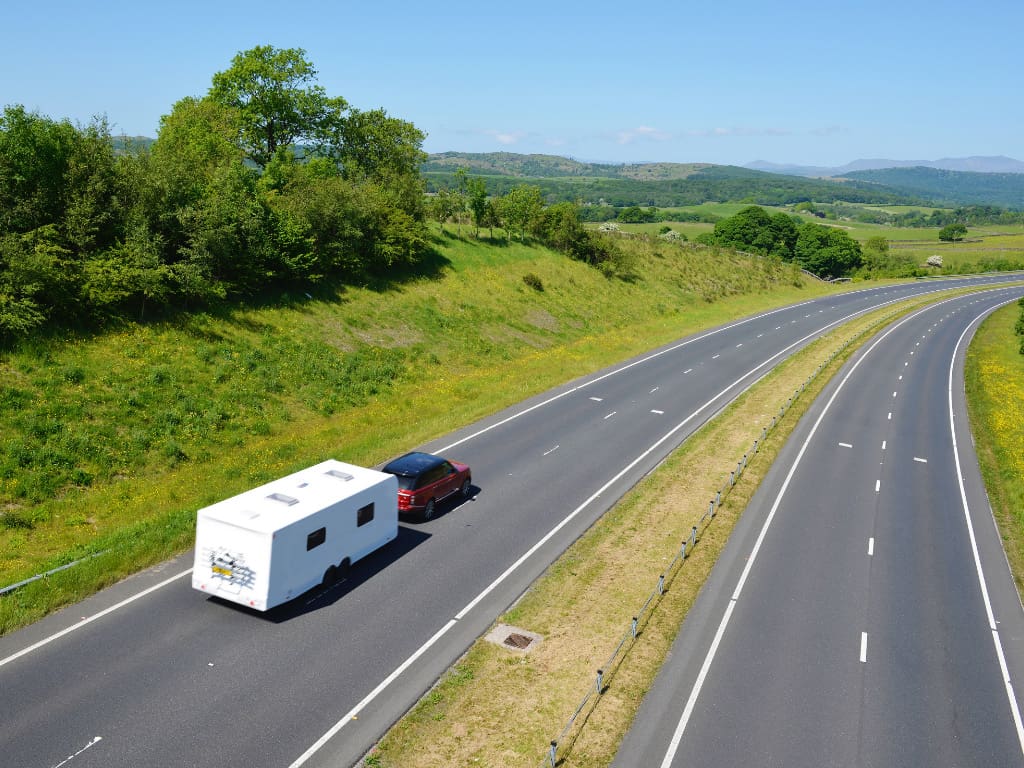
If you are thinking about buying a touring caravan it’s important to consider how you are going to tow it – and if you even can.
In this guide to towing a caravan, we will be covering some of the essentials.
Is It Easy To Tow A Caravan?
Towing a caravan is often thought to be difficult and stressful – and the idea of it can absolutely seem overwhelming.
But, with some knowledge and forward planning, towing a caravan doesn’t need to be hard work.
Go through the points in this guide and you’ll soon be raring to take your new tourer out on its first adventure!
In addition to the information that follows, also consider these tips for a calmer experience;
- Plan your route ahead of time – knowledge is power. Familiarise yourself with the directions and roads you will be going down. Consider any fuel and food stops.
- Time your journey – think about what time you will be travelling. Avoid the usual busy times if you can – eg. rush hours!
- Allow plenty of time – if you have to check in to a site by a certain time, or reach a ferry port for a specific sailing, allow enough time, and then some more, to get there. Remember the slower speed you will be going at (see details below for speed limits with a caravan).
- Car and caravan checks – before you travel go through your usual checks for your car (oil, battery, tyres etc) as well as your caravan (tow bar, lights etc).
Is Your Car Suitable For Towing?
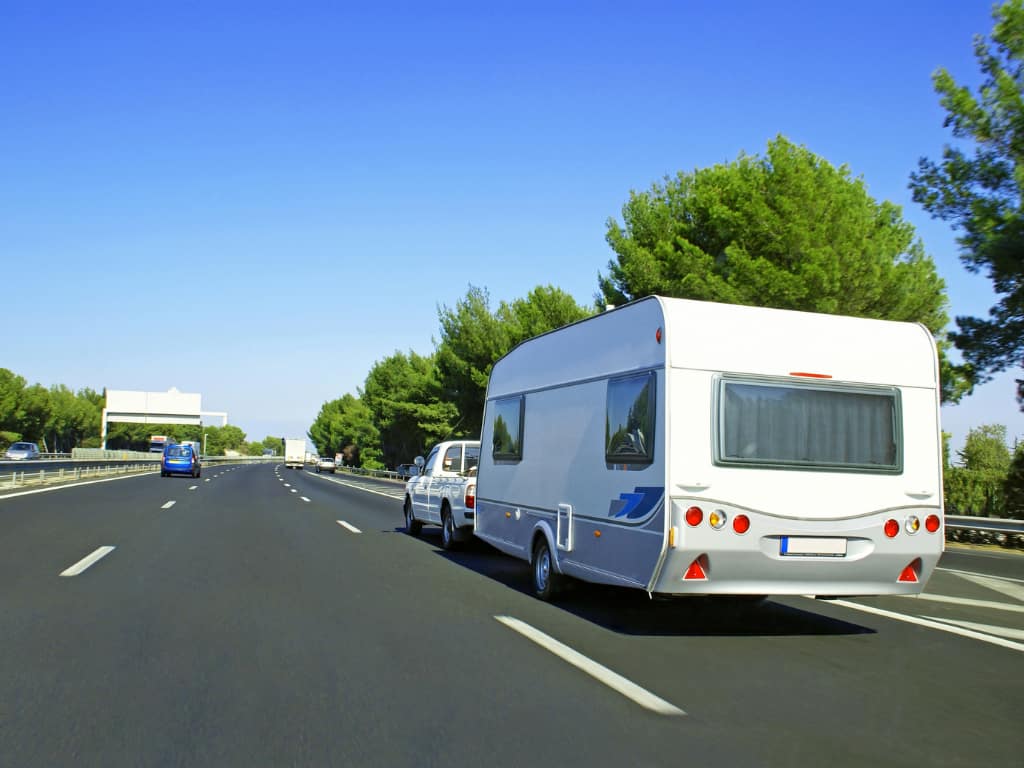
The rule here is that the caravan’s actual weight shouldn’t weigh more than the car you use for towing it. It’s logically much safer to go with the heavier the vehicle and the lighter the caravan combination.
These days cars come with a handbook that will state the maximum weight you can tow, making it much easier to work out. Always check before searching for your new caravan.
The standard recommendation is that the total weight of your caravan (including any contents) must not be more than 85% of your car’s unladen (kerb) weight – refer to manufacturer guidelines on this so you can ensure your outfit is safe for the road.
This is not official legislation; it is meant as a guide only, meaning it’s better not to maximise this weight recommendation really if possible.
When deciding which touring caravan to buy it’s important to think about whether you will need to also buy a new car to manage the weight, or, consider a caravan that is lighter.
What Tow Bar Should I Use?
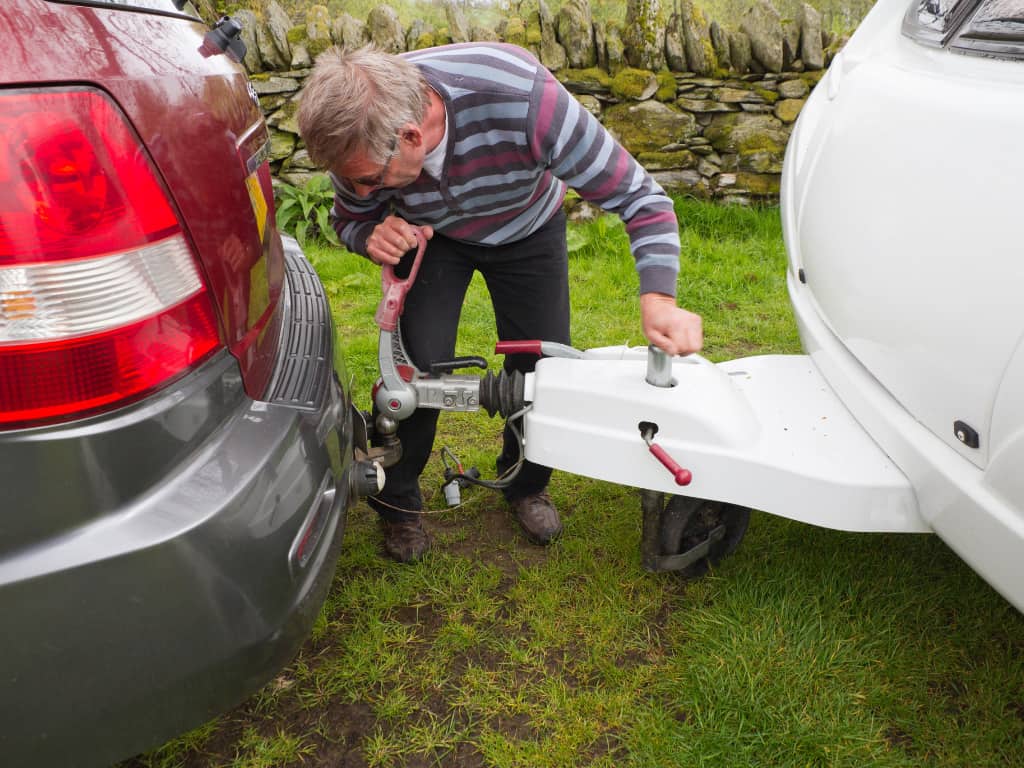
It’s important that you buy a tow bar that is ‘type approved’ – it is required that it meets EU regulations and is designed for your car. They will have a label with an approval number, the details of the vehicles it’s approved for.
The only exception to this is if your car was first used before 1 August 1998 – then it doesn’t need to be type-approved.
Before buying a tow bar check the latest rules on the Government website .
What Are The Rules For Towing A Caravan?
Aside from the recommended car and caravan combination, in the UK, there is the legal part to consider.
If you received your driving licence (Category B) after 1st January 1997, then this applies:
- You can drive a vehicle up to 3.5 tonnes or 3,500kg – MAM (Maximum Authorised Mass), and you will also be able to tow a trailer of up to 750kg MAM
- You can tow a trailer over 750kg MAM provided the combined weight of the trailer and towing vehicle is no more than 3,500kg.
However, the law states that if your licence was issued anytime before 1st January 1997 then:
- You can drive a vehicle or trailer combination of up to 7.5 tonnes.
Super Size Caravans
Some of the larger caravans often built overseas might be too big for UK size restrictions. Currently, the size limit in the UK is no bigger than 2.55 metres in width and no longer than 7 metres.
Always double-check the latest Government regulations .
What Is The Speed Limit For Towing A Caravan?
Speed limits are different when you are towing a caravan. At the time of writing they are;
- Built up areas – 30mph
- Single carriageways – 50mph
- Motorways and dual carriageways – 60mph
Can I Carry Any Passengers In The Caravan?
No, you are not allowed to carry any passengers in a caravan when it is being towed.
Are There Any Rules For Towing A Caravan On A Motorway?
Where there are three or more lanes available to use a car towing a caravan is not allowed to use the right-hand lane on a motorway.
Mirrors For Towing A Caravan
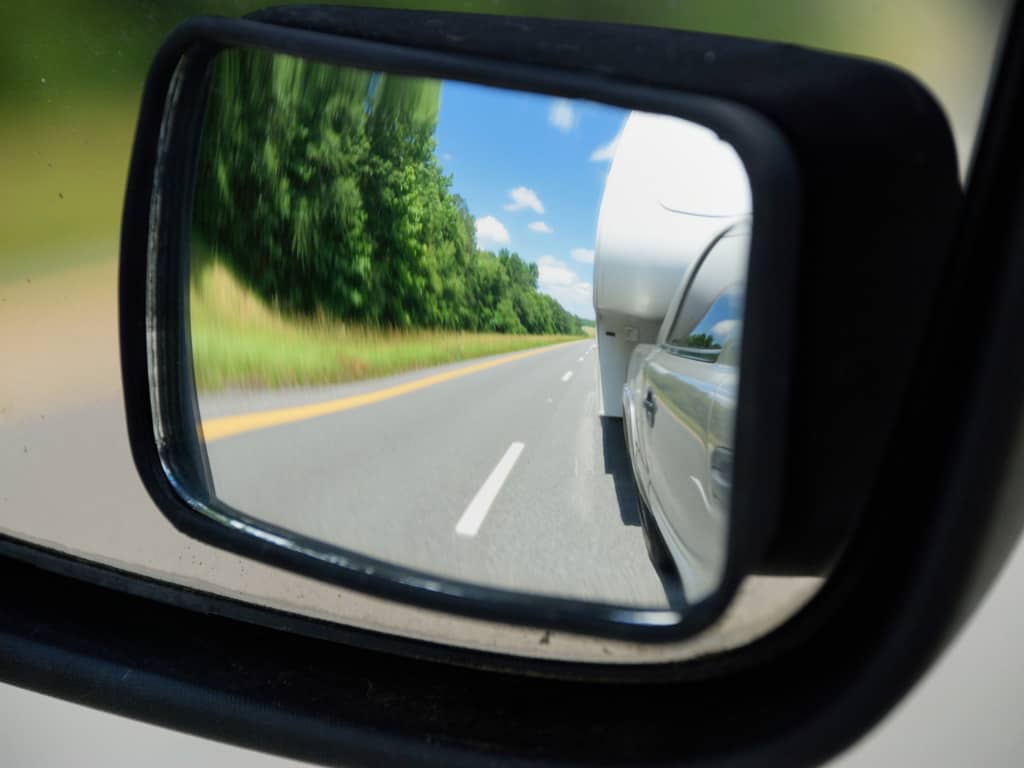
If your caravan is wider than the width of your car it is mandatory that you use suitable towing mirrors. Not only is it incredibly dangerous to tow a caravan without them, but you will also be liable for 3 points on your license and a £1,000 fine.
Do I Need A Number Plate For My Touring Caravan?
It is mandatory that you display the same car license plate on the back of the caravan when you are towing it.
Does My Caravan Need Breaks?
Yes. Any caravan you buy will and should be fitted with an over-run brake system. It’s essential that these are well maintained, preferably by a trusted caravan service centre.
Caravan Towing Course
Whereas it isn’t mandatory to go on a caravan towing course, taking one will provide you with some useful skills and improve your confidence when towing for the first time.
Both the Camping and Caravanning Club and Caravan and Motorhome Club offer courses in locations throughout the UK.
What Is The Best Car For Towing A Caravan?
As already covered above in our section about towing cars, it’s important to have a car that is up to the task of towing the weight of your caravan, together with the laden weight. What you should also consider is the space you need in your car to carry all your passengers and your luggage. There are of course many other factors to consider too such as fuel economy and your budget.
Caravan Towing Covers
Do you need one? It’s not mandatory, but it’s recommended to protect the front of your caravan when you are towing it. Not only from potential debris chipping the window, but also, dirt, grime and oil from the roads.
Compare listings
Reset Password
Please enter your username or email address. You will receive a link to create a new password via email.
Your browser is out-of-date!
Update your browser to view this website correctly. Update my browser now
Home › Advice › General Advice
A beginner’s guide to caravanning
There's a lot to learn when you first enter the world of touring – we're here to help with our beginner's guide to caravanning
By Nigel Hutson Published: March 5, 2024
There’s a lot to learn when you first enter the world of touring – we’re here to help with our beginner’s guide to caravanning
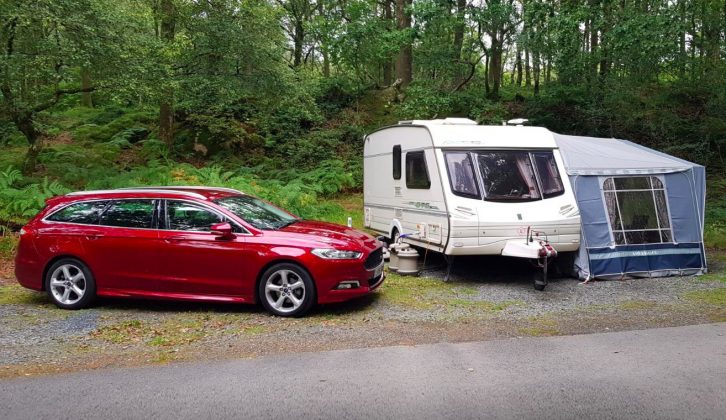
Entering the world of caravanning provides you with the freedom to set off and explore whenever you want. However, when you’re a newcomer to touring, there can be a lot to learn. That’s where our beginner’s guide to caravanning comes in, as we talk you through the various things you should be aware of, from the accessories to pack to how to hitch your tourer.
Start with the tow car
Before you think about buying a caravan , you need to know what your requirements will be for the best tow car – and no, it won’t necessarily be an SUV .
Of course, common sense will tell you that a city car isn’t going to be capable of safely towing a big twin-axle caravan , but if you have a reasonably sized family car, what will it comfortably tow?
There’s a lot to consider here, so check out our guide to how to choose the perfect tow car , where David Motton offers his top tips.
For a beginner, both of the UK’s big caravanning clubs (The Camping and Caravanning Club and the Caravan and Motorhome Club) recommend that the maximum weight of the caravan should not exceed 85% of the car’s kerbside weight.
Unless the car’s towing limit is less than the 85%, you can pretty much forget that. I’ve lost count of the number of times that I’ve heard a car’s towing limit quoted (which in many cases is heavier than the fully laden car!) or someone at a caravan dealership saying, “the car dealer says that my car will tow two tonnes”.
It may do, but that figure is derived from the testing that manufacturers carry out to evaluate the structural and mechanical durability of any vehicle, not what might be safe or sensible to tow on the road.
Good caravan dealers are switched on to this, and I have known one to refuse a sale to someone who was arguing that point.
Buying a caravan
There are many different types of caravans on the market, all providing their own pros and cons, as well as a variety of different shapes, sizes and weights. So, when you’re new to touring, how do you choose the best caravan ?
The good news is you don’t necessarily have to spend a fortune. While one of the latest releases on the market may be a tempting prospect, it will also be expensive. Opting for one of the best used caravans can still provide you with plenty of the comforts that a new one would offer but at a more budget-friendly price.
Apart from anything else, you never know – you may decide caravanning isn’t for you, or else you love it and would like to upgrade, perhaps to a luxury caravan .
That’s why we’d recommend starting at the more affordable end of the market – that way, you’ll be more likely to get most of your money back.
Picking the right model is the hard part though. You’re going to want a caravan layout that works for everyone, as well as a tourer that your car can safely and legally tow.
As a starting point for choosing the right caravan , how many of you will be touring together? If there are four of you, you’re going to need four berths (beds), for instance.
If you have two teenagers, two double beds are not going to be a popular option, but at the same time, many bunk beds not only have weight restrictions but are meant for young children.
Don’t go down the route of buying a two-berth and thinking that using one of the best caravan awnings will provide the extra bedroom either. It might do, but if you’re arriving at your campsite after a delayed journey and with the rain coming down sideways, putting up an awning will most likely be one of the last things you’d want to do.
Visit a few dealerships and have a look around their ‘used’ section to get an idea of what’s available. Get in the vans, think how you would live in that space to see if that floorplan will suit you.
Scour private adverts, too, as well as Practical Caravan ’s used caravans for sale pages .
When you think that you’ve found the right caravan for you, take an experienced caravanning friend with you to have a look and to give you a second opinion as you’ll no doubt be in holiday mode with the rose-coloured glasses on. We’ve all been there.
What caravan accessories do I need to buy?
There are different types of products here – you get the essential caravan accessories that are definitely worth taking on tour with you and also luxury caravan accessories that can elevate your touring experience but aren’t a requirement for an enjoyable stay.
Sometimes, if you’re lucky, you may find the seller includes the majority of the equipment you need, especially if it’s a private sale.
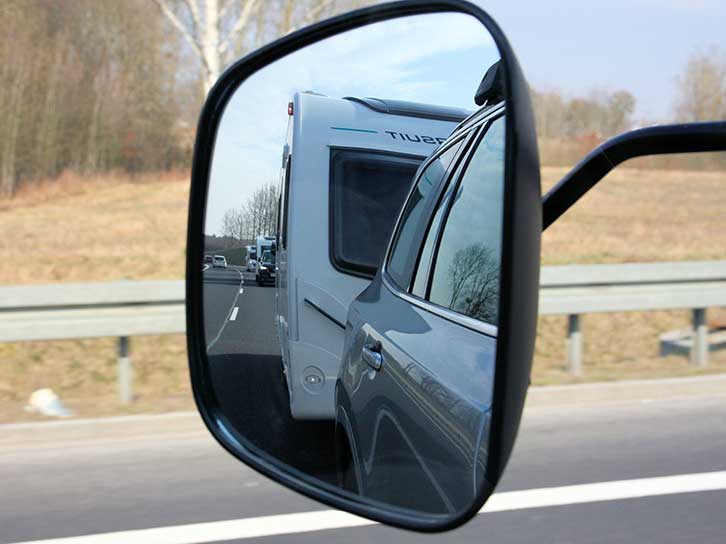
Dealers often supply a ‘starter kit’, too, which will have some of the essentials. However, you’ll probably need most of the following accessories for comfortable touring:
- Towing mirrors – if your car’s body (excluding the mirrors) is narrower than the caravan, you will not have the legally required ‘adequate’ view along the side of the caravan – our best towing mirrors guide will help you choose the right pair.
- Number plate to attach to the rear of the caravan.
- A spare wheel for the caravan – be sure there is one.
- 12V leisure battery – the best caravan leisure battery will allow you to keep your lower voltage gadgets powered up on tour.
- Mains hook-up lead.
- A gas cylinder (at least one) and associated connectors – seek advice from the dealership or a knowledgeable friend on this.
- Fresh water container (the type that roll are best as you might be sited quite a way from the nearest tap).
- Fresh water pump/pipe to connect the supply to the caravan.
- Waste water container (one with wheels).
- Waste water pipe(s).
- Corner steady winder.
- Levelling ramps – these will help you with levelling a caravan .
- Wooden blocks to place under the corner steadies in case you’re on soft ground, or sited on a slope and the steadies don’t quite reach the ground.
- Toilet fluids.
- Noseweight gauge (to ensure that you’re not overloading the hitch/tow bar).
- Crockery, cutlery, pots and pans (but be mindful of excess weight!).
- Wheel and hitch lock (often an insurance requirement).
- Spirit level.
Your first caravan holiday
Whatever you do, don’t be too ambitious on your first trip.
Towing takes some getting used to and at first can be quite tiring, so restrict yourself to a drive about an hour from home – it also means you don’t have far to come back if something goes wrong.
If possible, before you venture out, familiarise yourself with the caravan’s various systems. Most things are explained in the handbook, but if not, do a search online. Don’t rely on luck when you arrive on-site in the dark!
When you’re ready to choose a location, our guide to the best caravan sites is sure to help you find the ideal destination to head to.
How to hitch and unhitch your caravan
We’ll begin with unhitching because when you collect your caravan you’re likely to have had help with the hitching, but now you’re on your own.
The main thing to remember is the breakaway cable, which is the red plastic covered cable that’s attached to the car.
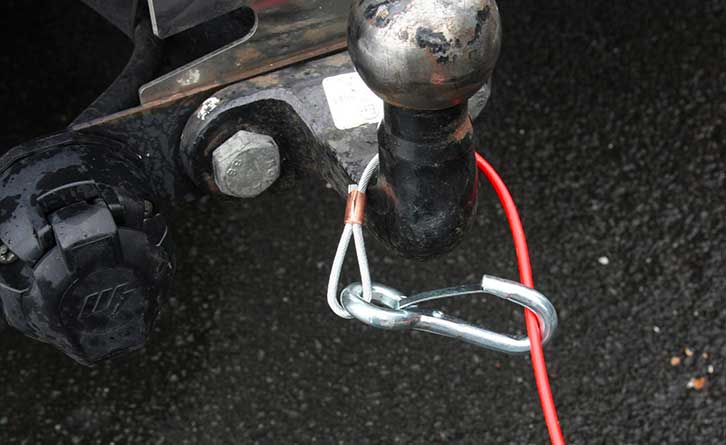
When hitching, this should be the first thing that’s attached and, when unhitching, the last thing to be detached. It’s a safety device, after all. So, what’s next when unhitching?
- Apply the caravan handbrake.
- Disconnect the electrics. If it’s a 13-pin connection, twist the plug through 90 degrees anti-clockwise and it should come out.
- Release the jockey-wheel clamp and lower the jockey wheel until it’s a few inches from the ground, then unwind it so that the wheel is on the ground. If you simply lower it to the ground, the wheel will not pivot as the arms will remain in the locating slots, plus you might need the leeway if you’re parked on a slope so that you can get the caravan level.
- If you have a hitch stabiliser fitted, lift the handle as vertically as it will go.
- Then, whilst raising the hitch handle as high as it will go, wind the jockey wheel until the hitch detaches from the car’s tow ball.
- Finally, detach the breakaway cable.
Hitching up a caravan is basically a reversal of the above. When attaching the caravan to the car, raise the hitch handle, and it should remain up until the hitch is lowered onto the tow ball of the car, when it will click down.
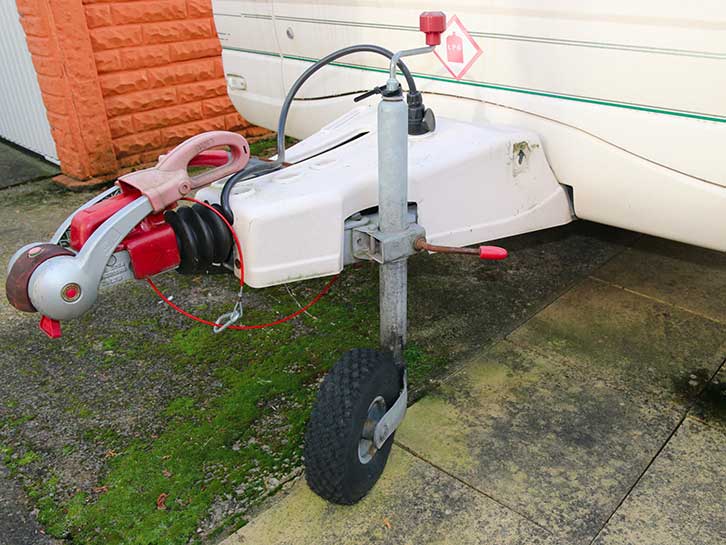
With this done, wind the jockey wheel back up so that the caravan hitch lifts the back of the car. If it does, you know that it’s been coupled properly.
You’ll need an assistant to check the caravan road lights for you, and then to help you set up the towing mirrors correctly. For the latter, you need the outfit to be straight.
Just the beginning…
There are so many things that we haven’t been able to cover in the space available here, this is just a brief introduction. And remember, caravanners are generally friendly folk so if you have any questions, don’t be afraid to ask.
You can also find plenty of advice on our website, ranging from caravan towing tips to guidance on how to reverse a caravan .
We’ve all had to start somewhere and there’s no such thing as a stupid question. Above all, take your time and enjoy your new freedom.
Oh, and one last piece of advice – remember to wind the corner steadies up before you tow!
And if you have any more questions, you can always head to our friendly forum .
Happy touring!
If you’ve enjoyed reading this article, why not get the latest news, reviews and features delivered direct to your door or inbox every month. Take advantage of our brilliant Practical Caravan magazine SUBSCRIBERS’ OFFER and SIGN UP TO OUR NEWSLETTER for regular weekly updates on all things caravan related.
Before you venture out, familiarise yourself with the caravan’s systems
NigelHutson
Nigel is a freelance journalist who is a lifelong caravanner and writes on all aspects of his hobby including travel, caravan reviews and technical articles. Together with his wife Kay, they caravan both here in the UK and on the Continent. Nigel became involved with Practical Caravan several years before retiring from the Police after serving for 30 years, mainly on Traffic and Forensic Collision Investigation. To date, Nigel has been an ever-present driving judge at the annual Tow Car Awards and also took part in Bailey Caravans Arctic Adventure. He has a passion for organ music too.
Related News
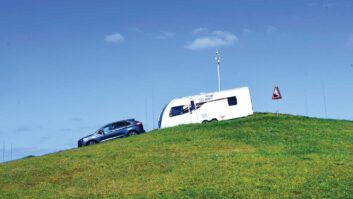
Caravan towing tips for staying safe on the road

Reversing a caravan: everything you need to know
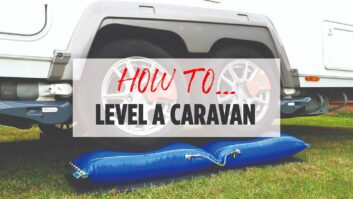
Levelling a caravan: how to get your tourer flat on its pitch
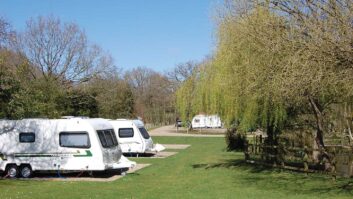
39% of Brits pick caravanning as most cost-effective way to travel this summer
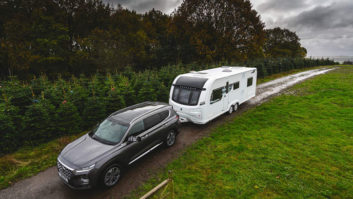
Narrow country roads prove stressful for drivers

Caravanners urged to watch out for power lines
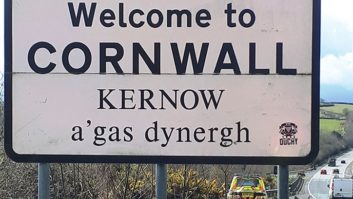
Highway officers deployed to keep A30 traffic moving
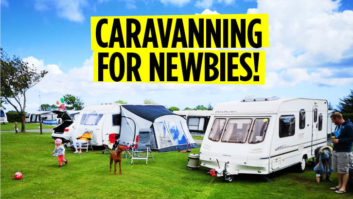
Caravanning for beginners – here’s everything you need to know!
Campsites and Booking:
- Find a campsite
- All UK Campsites
- Late Availability
- Latest Offers
Other Types of Camping:
- Member-only Campsites
- Social Camping
Other Accommodation:
- Self Catering
- Holiday Homes
Inspiration:
- Holiday Ideas
- Camping with Kids
- Camping with Dogs
- Camping near the Coast
Camping Insurance
- Caravan Insurance
- Motorhome Insurance
- Campervan Insurance
- Tent Insurance
- Trailer Tent Insurance
On the Road
- Arrival Breakdown Cover
- Car Insurance
Other Cover
- Home Insurance
- Caravan Holiday Home Insurance
- Confident Caravan Towing
Towing a caravan for the first time may seem a scary prospect, but it needn’t be. Read up on all you need to know below or attend one of our Club Courses .
If the thought of towing is preventing you from buying a caravan, there are places where you can have a go before you buy a unit.
Some of the larger caravan shows have opportunities to try towing a caravan, under the watchful eye of a professional instructor.
Your local caravan dealer may also be prepared to let you take a caravan on the road – especially if it helps secure a sale.
Before you tow: getting the right driving licence
The standard driving licence issued to a driver passing the test in Great Britain (not Northern Ireland) includes his or her test today covers categories B, B1 and now BE. This means you can drive a vehicle up to 3,500kg (B) and tow a trailer up to 3500kg behind it (E). When you reach your 70th birthday slightly different rules apply if you’d like to keep towing, see our driving licence guide for more information.
On the road
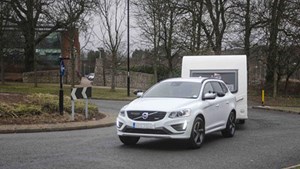
The extra length of your outfit means you will need to take corners more widely than normal so the caravan wheels don't clip the kerb or cut the corner.
Remember the legal speed limits are often lower when you’re towing. Don’t exceed 50mph on single carriageways or 60mph on dual carriageways.
You may not tow in the furthest right (‘outside’) lane of a three-or-more lane motorway unless instructed to do so.
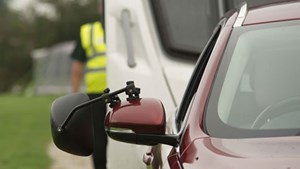
Never carry passengers in the caravan when you’re towing it. It’s theoretically legal to transport animals inside a caravan, but it’s definitely not recommended.
The number plate on the back of your caravan must show your car’s registration number, conform to the relevant British Standard and be illuminated at night. This means no felt-pen on cardboard!
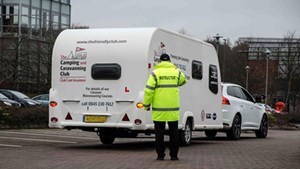
If you find traffic is building up behind you, pull over at a layby or other suitable place when safe to do so and let the other vehicles pass.
Park carefully where you won’t cause an obstruction. Caravans must not be parked in parking meter bays.
Snaking and pitching
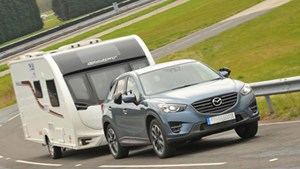
Snaking is when the lateral swaying movement (technically known as the ‘yaw’) of the caravan behind a car becomes excessive. In extreme cases, the caravan swings ever more violently from side to side, eventually dragging the back of the car with it so the driver loses control.
‘Pitching’ describes vertical instability – when the caravan’s front end moves up and down, pulling the rear of the car around like a seesaw.
The best way to avoid snaking and pitching is to have a well-matched car and caravan and to load your unit carefully.
Electronic and friction stabilisers are fitted to many caravans, which can reduce these problems in a well-matched outfit, but will not rectify an inherently unstable combination.
But even with all these precautions, you might find the back of your car being pulled by your caravan because of the air turbulence caused by a passing lorry, coach or a crosswind.
If the caravan does start yawing or pitching, take both feet off the pedals to bring down your speed using your car’s engine braking. Avoid the instinct to brake, but keep steering in a straight line. Trying to steer out of the sway can make the problem worse.
Learning to tow your caravan

They will take you through all the basic information you need from hitching up your caravan and car to reversing. We’ll add some important advice on safe caravanning too.
You’ll be taught at the wheel of your own familiar car but towing a special Club caravan, and have the instruction of professional tutors in small groups.
See our video on caravan reversing for some tips.
Find out more about Manoeuvring Courses offered by the Club.
Towing a Caravan 101
The thought of towing a caravan can be daunting if you don't have previous experience. but don’t worry - our beginner's guide to towing a caravan will have you confident in no time.
- Understanding the towing capacity of your vehicle.
- Preparing the caravan for towing.
- Hitching and unhitching the caravan.
- A checklist before towing the caravan.
- Tips for towing, manoeuvring, reversing and parking the caravan.
- Hiring a caravan.
Guide to towing a caravan
1. ensure that your car is capable of towing the caravan.

2. Prepare your vehicle and caravan for towing

3. How to hitch and unhitch the caravan

- Wind the jockey wheel up as high as it will go so that the coupling hitch sits high off the ground.
- Reverse the car up to the caravan so that the tow ball sits underneath the coupling head. It’s helpful to have someone guide you whilst reversing.
- Lower the jockey wheel so that the coupling head latches on to the tow ball.
- Lock the coupling head onto the tow ball by engaging the coupling latch.
- Attach the safety chain or breakaway cable between the car and the caravan.
- Connect the caravan trailer pin plug to the socket on the back of the car. Ensure that the brake lights and indicators on the caravan are working correctly.
- Remove or raise the jockey wheel so that it is in a travelling position.
- Disengage the caravan handbrake.
4. Checklist before towing the caravan

- Closed all the roof hatches and windows.
- Closed all the cupboards and drawers.
- Switched the refrigerator to DC power.
- The step is up.
- The awning is secured away.
- The entrance door is shut and locked.
- The gas bottles are turned off.
- The tyre pressures are correct.
- The hitch is properly attached.
- The safety chain is connected.
- The caravan handbrake is off.
- The jockey wheel is up.
5. Tips for towing a caravan

Hire a caravan in Australia

Why Camplify?
- Comprehensive hire insurance
- NRMA roadside assistance
- 24/7 customer support
- All members are verified
Related stories
Deals galore in the big48-hour sale, van life in australia - ultimate guide 2022, 25 of earth's best caravan & campervan cakes.

Stay updated
Popular destinations.
- Sunshine coast
- Coffs Harbour
- New South Wales
- South Australia
- Western Australia
- Premium Membership
- Managed Services
- Camplify Commercial
- Owner damage cover
- GPS tracker
- Hirer damage cover
Help & Support
- Call 02 4075 2000
Supported Payments
Download the app.
Stay up to date
How to tow a trailer or caravan safely
Whether you're towing a trailer or a caravan, here are some of the basics you need to remember to travel safely on the road..
Whether you’re towing a trailer or a caravan , there are a number of safety considerations to remember before you get hitched.
Our brief guide to towing a trailer or caravan outlines the basics you need to know, from what you can and cannot tow, weight limits, coupling, and the safety checks to carry out before making a move.
Get it wrong, and you risk causing an accident and being banned from driving. It goes without saying that you should ensure the towing vehicle is safe and legal, so this advice is geared towards towing and towing equipment.
More advice on Motoring Research
Because this guide is designed to be a broad overview, you should consult the National Trailer & Towing Association’s (NTTA) detailed guide for more information.
What you can tow
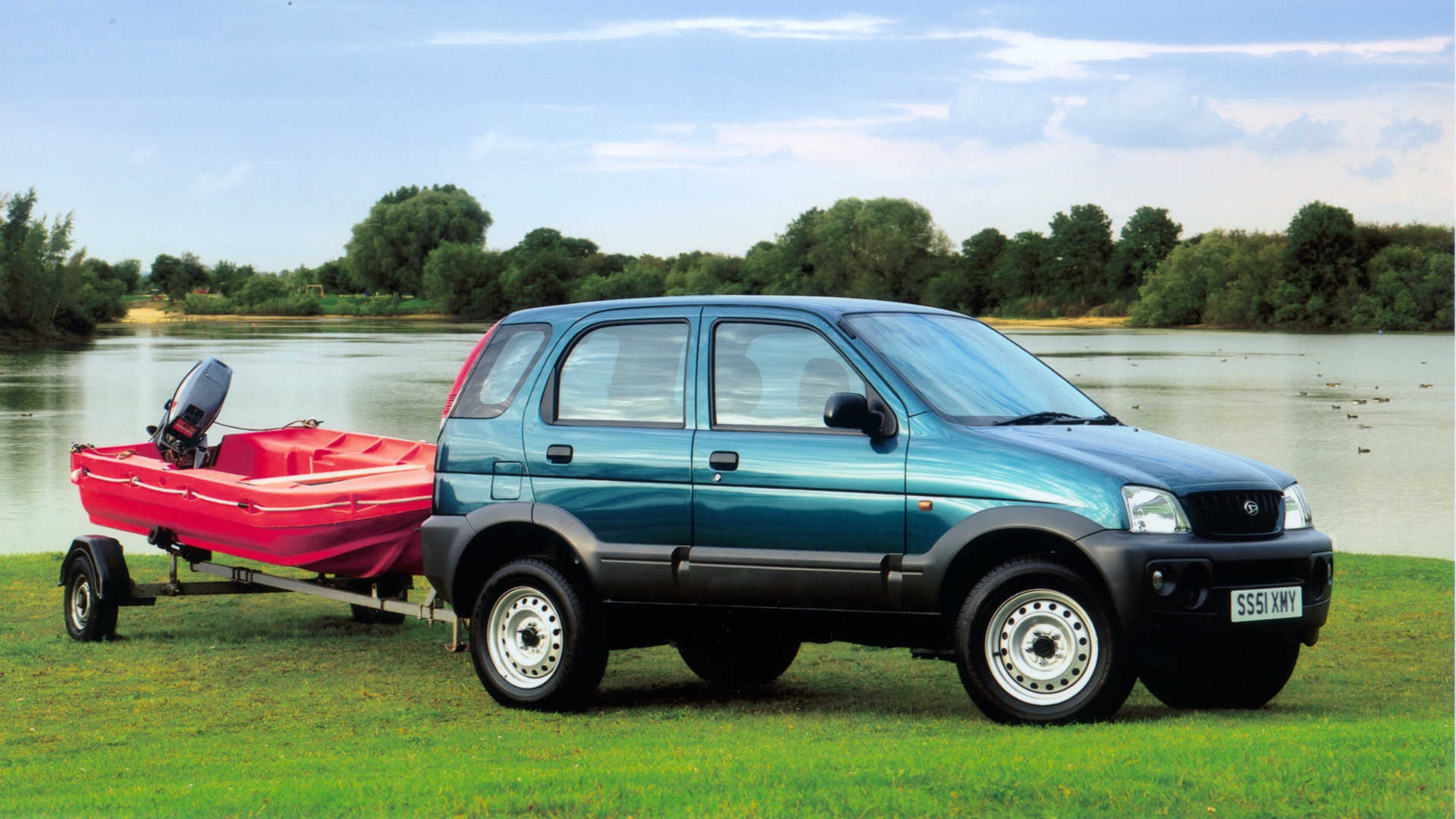
If you passed your driving test on or after 1 January 1997, you can:
- Drive a car or van up to 3,500kg maximum authorised mass (MAM) towing a trailer up to 750kg MAM Tow a trailer over 750kg MAM as long as the combined MAM of the trailer and towing vehicle is no more than 3,500kg
Maximum authorised mass (MAM) – also known as the gross vehicle weight (GVW) – is the weight of a vehicle or trailer including the maximum load that can be carried safely on the road. It should be listed in the owner’s manual and on a plate or sticker attached to the vehicle.
If your driving licence was issued before 1 January 1997, you can drive a vehicle and trailer combination up to 8,250kg MAM. Click here to check your driving licence and which vehicles you can drive .
We also outline here in more detail how to check what you can legally tow .
Know your limits
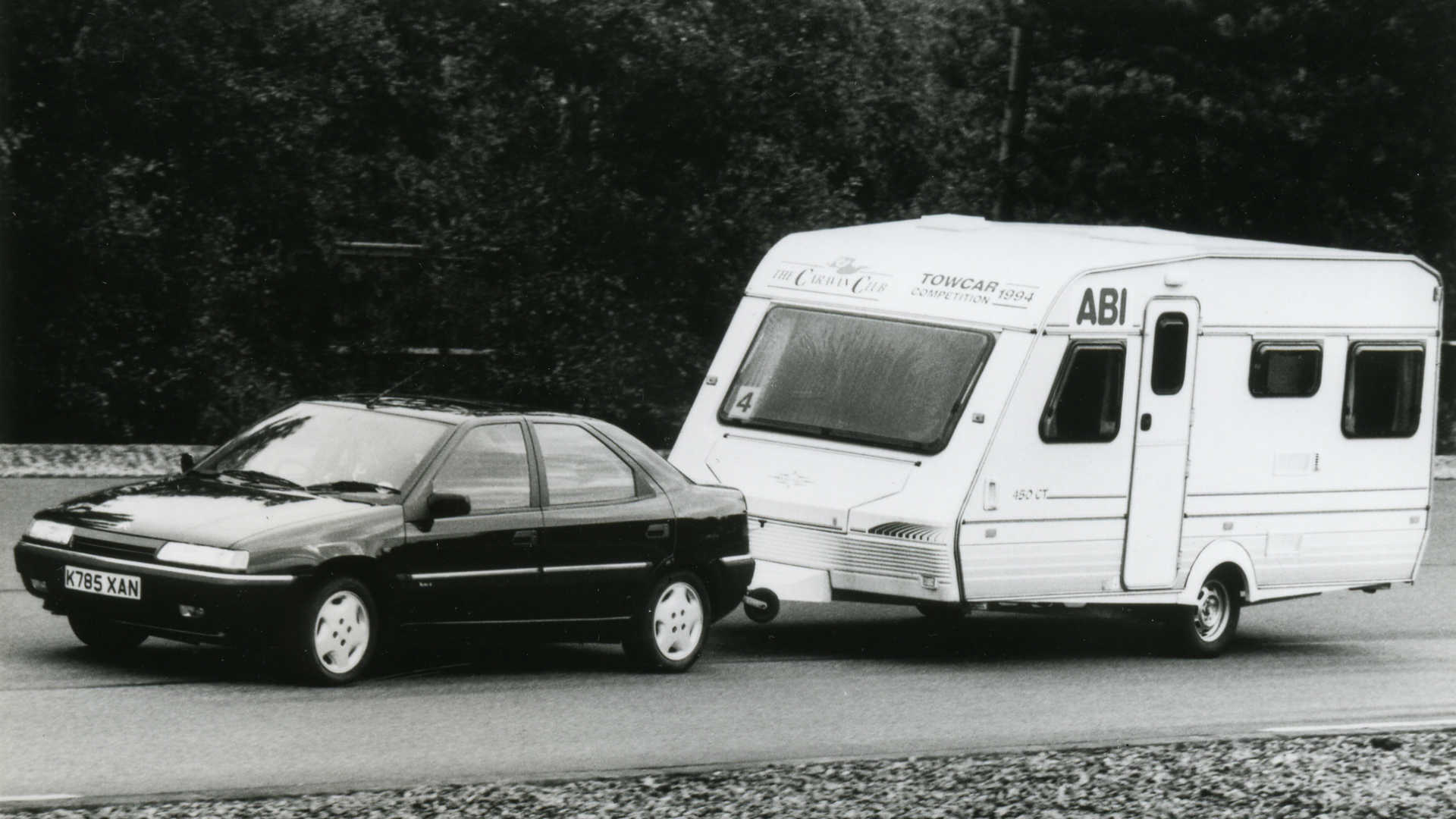
Most cars have a maximum weight they can tow, which is usually listed in the handbook or specification sheet. If in doubt, search online or contact your local dealer.
Many industry experts, including the Camping and Caravanning Club recommends that you only tow a caravan or trailer that weighs 85 percent or less of the car’s kerb weight. Experienced drivers may go up to 100 percent, but you should never exceed the towing limit of the vehicle that’s doing the towing.
Check the unladen weight of your trailer or caravan BEFORE it is loaded with passengers, goods or animals. Consult the manufacturer’s specification sheet or visit a public weighbridge if there are any doubts.
The maximum trailer width for any towing vehicle is 2.55 metres, while the maximum length for a trailer towing a vehicle up to 3,500kg is 7 metres.
For trailers with no braking system, the loaded trailer must not weigh more than 750kg or 50 percent of the car’s weight. For trailers with brakes, the car and loaded trailer must not weigh more than the maximum weight of the car and trailer combined.
Towbar: the laws
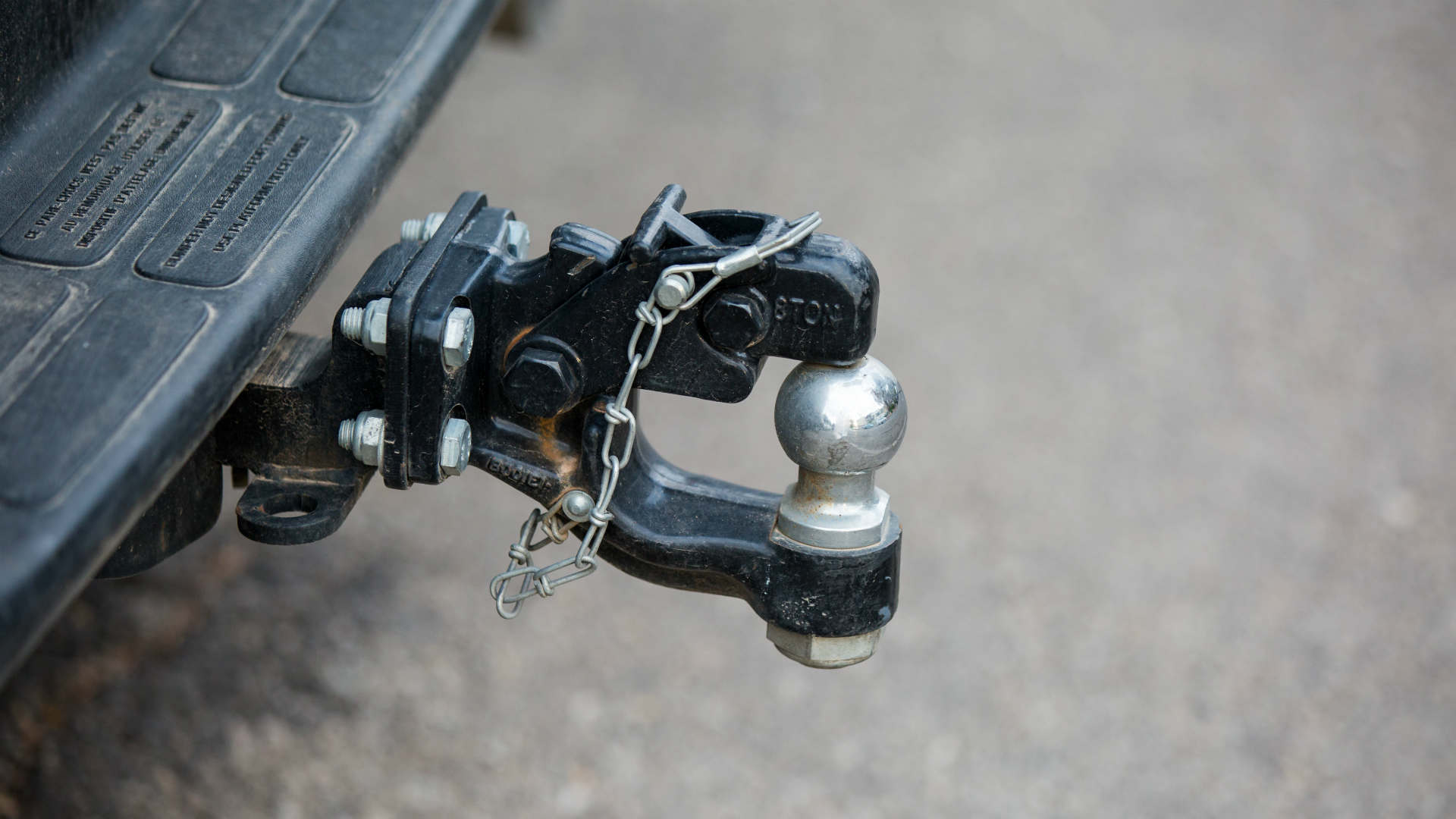
The towing equipment you use must meet certain safety standards and be used correctly. You could be fined up to £2,500, be banned from driving and get three penalty points for using a vehicle in a dangerous condition.
Towbars will be inspected during the MOT test for security, condition and inappropriate repairs or modifications. The tester will also check the electrical socket. But don’t wait until the annual MOT test to check your towbar – inspect it regularly, checking for serious rust or cracking.
If the towbar was first used after 1 August 1998, it needs to be ‘type approved’, which means it meets European regulations and is designed for your car.
Before you tow
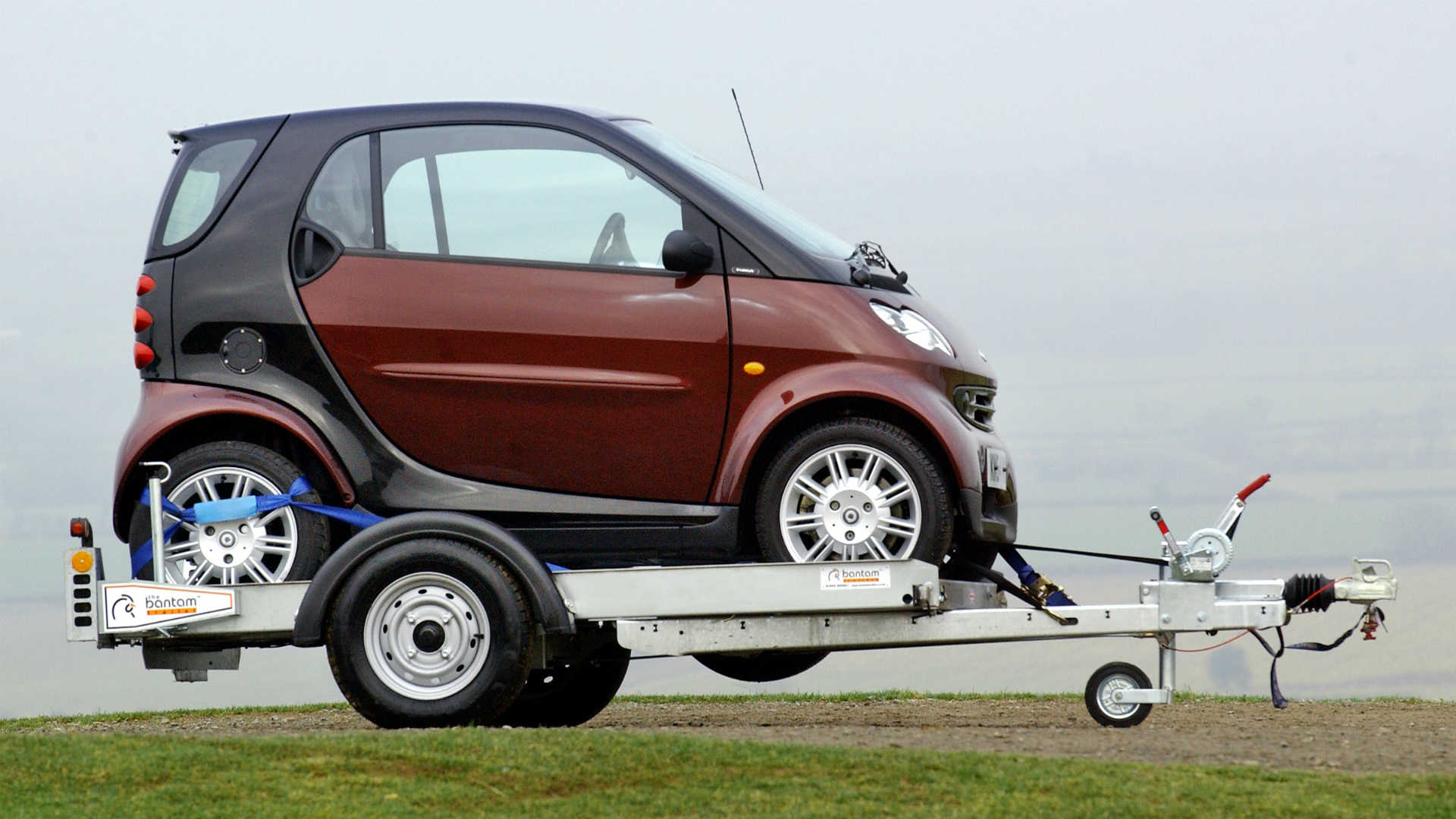
Before you tow, check that the trailer or caravan is correctly coupled to the towball or pin, and that the coupling height is correct. Also ensure that the electrical cable and socket aren’t damaged.
Caravans with brakes are legally required to have a breakaway cable fitted, which engages the trailer’s brakes and stops the trailer if it becomes detached from the towing vehicle.
Attach the cable to a dedicated mounting point on the towbar rather than around the towball, and make sure there is enough slack in the cable so that it doesn’t drag on the ground when driving and that the brakes are not applied when turning.
Attaching the trailer
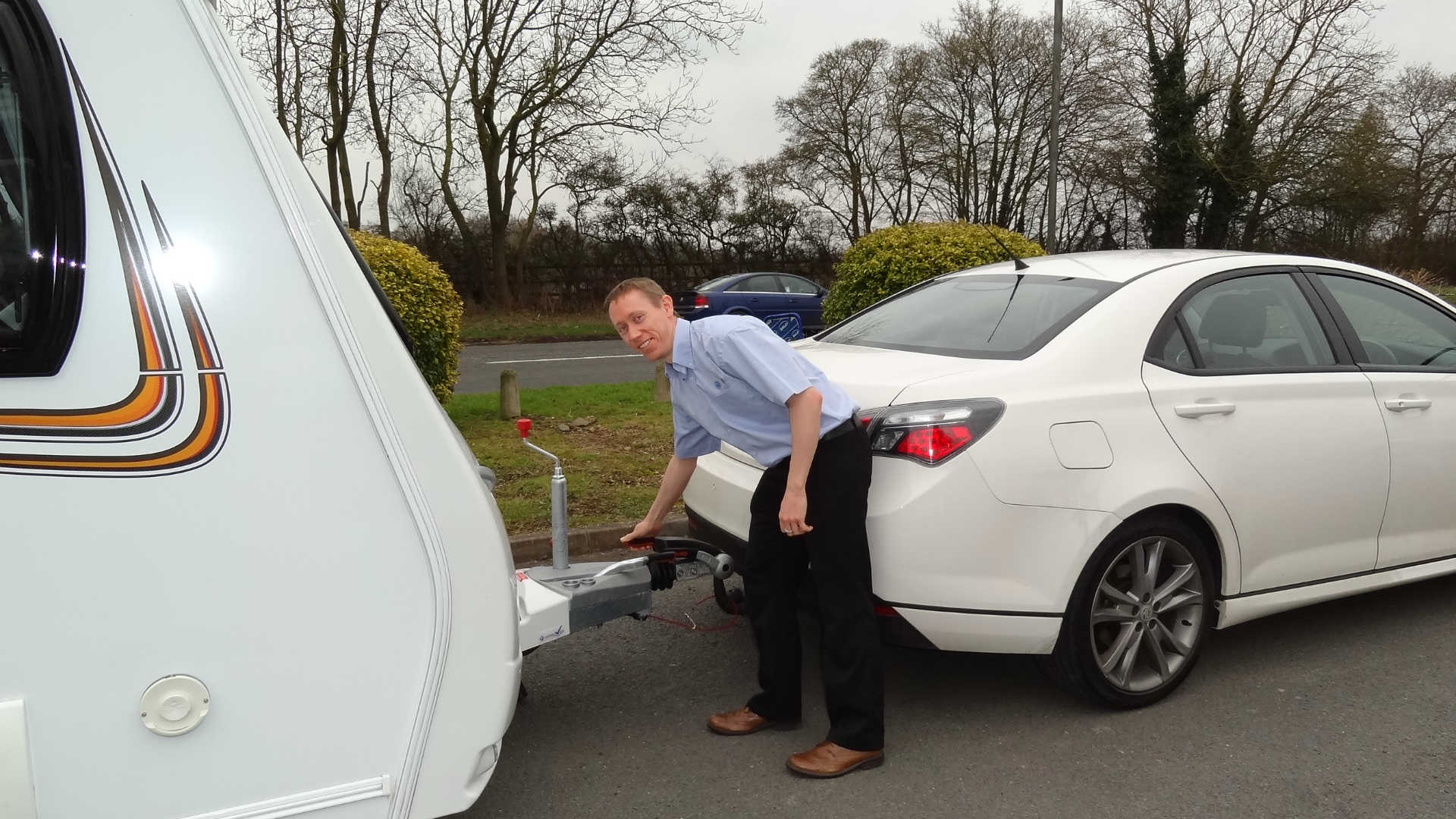
According to the NTTA, you should “become methodical about hitching up and unhitching”, so that it becomes second nature.
The not-for-profit organisation was founded in 1975 and sets the standards for the UK towing industry. Its 18-point guide to attaching a trailer includes the following key points. Click here for the full list of recommendations .
- Apply the trailer handbrake and remove any towball or electrical socket dust covers.
- Get a helper to stand with their hands showing you where the hitch is and reverse slowly back.
- Raise the front of the trailer using the jockey wheel assembly.
- Do not attempt to lift the front of the trailer – use the jockey wheel.
- When in position, wind the jockey wheel down to lower the coupling head onto the towball.
- Attach the breakaway cable(s) to the rear of the vehicle.
- Lift up and lock the jockey wheel assembly before completing the checks outlined in the next section.
Checks before each journey
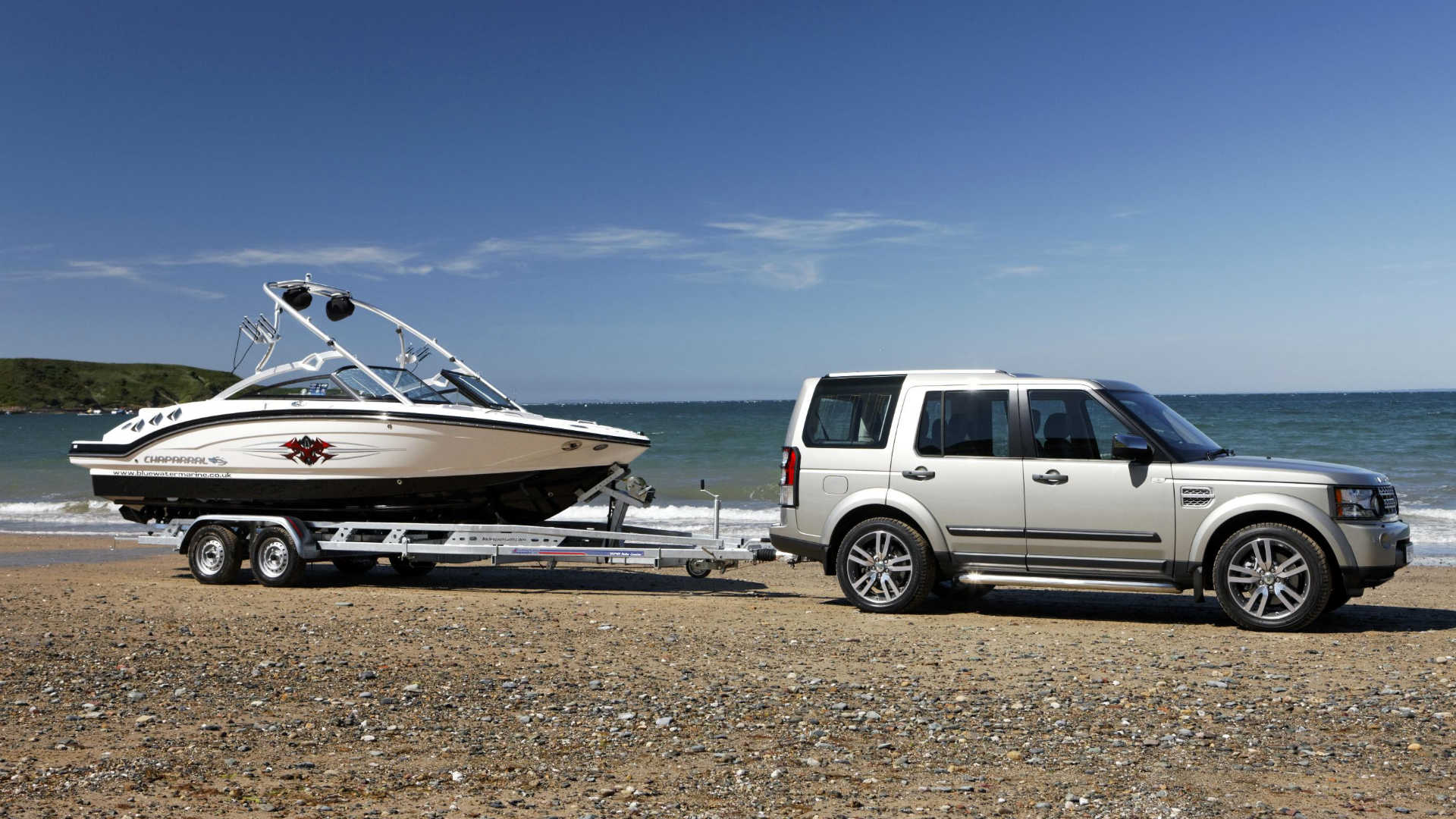
The NTTA recommends carrying out the following checks before each journey:
- Is the load correctly distributed? Place heavy items over the axle, medium items along the floor, and lighter items at the top.
- Is the load within the trailer’s official payload?
- Is the actual gross vehicle weight (GVW) being towed within the towing vehicle’s maximum towing limit?
- Is the load correctly secured? Ensure the load is tied down and, in the case of a caravan, safely locked away.
- Are all the lights undamaged and working correctly? Trailers must have two red sidelights, two red brake lights, an illuminated number plate, two triangular red reflectors, plus amber indicators designed to flash between 60 and 120 times per minute. Click here for a full list of trailer lighting requirements .
- Are the 7/13 core cable and plug undamaged?
- Is the correct number plate fitted?
- Is the breakaway cable or secondary coupling undamaged and correctly connected?
- Are the tyre pressures correct and are all tyres free from cuts, bulges and with adequate tread? The legal tread depth is 1.6mm, but we’d recommend changing your tyres when they reach 3.0mm.
- Are the wheel nuts/bolts tightened to the correct torque?
- Is the trailer correctly coupled to the towball or pin?
- Is the coupling height correct?
In addition to the safety checks, regular maintenance is essential to keep your trailer in good working order and to pinpoint any issues before you hit the road. Consult the trailer or caravan handbook for more information.

As well as checking the tread depth of the tyres, you should ensure that they are capable of carrying the maximum permitted weight of the trailer. Carry a spare wheel and a compact spare or tyre sealant kit.
Remember to check the tyre pressures of the towing vehicle, making adjustments in accordance with the figures outlined in the manual.
Towing mirrors
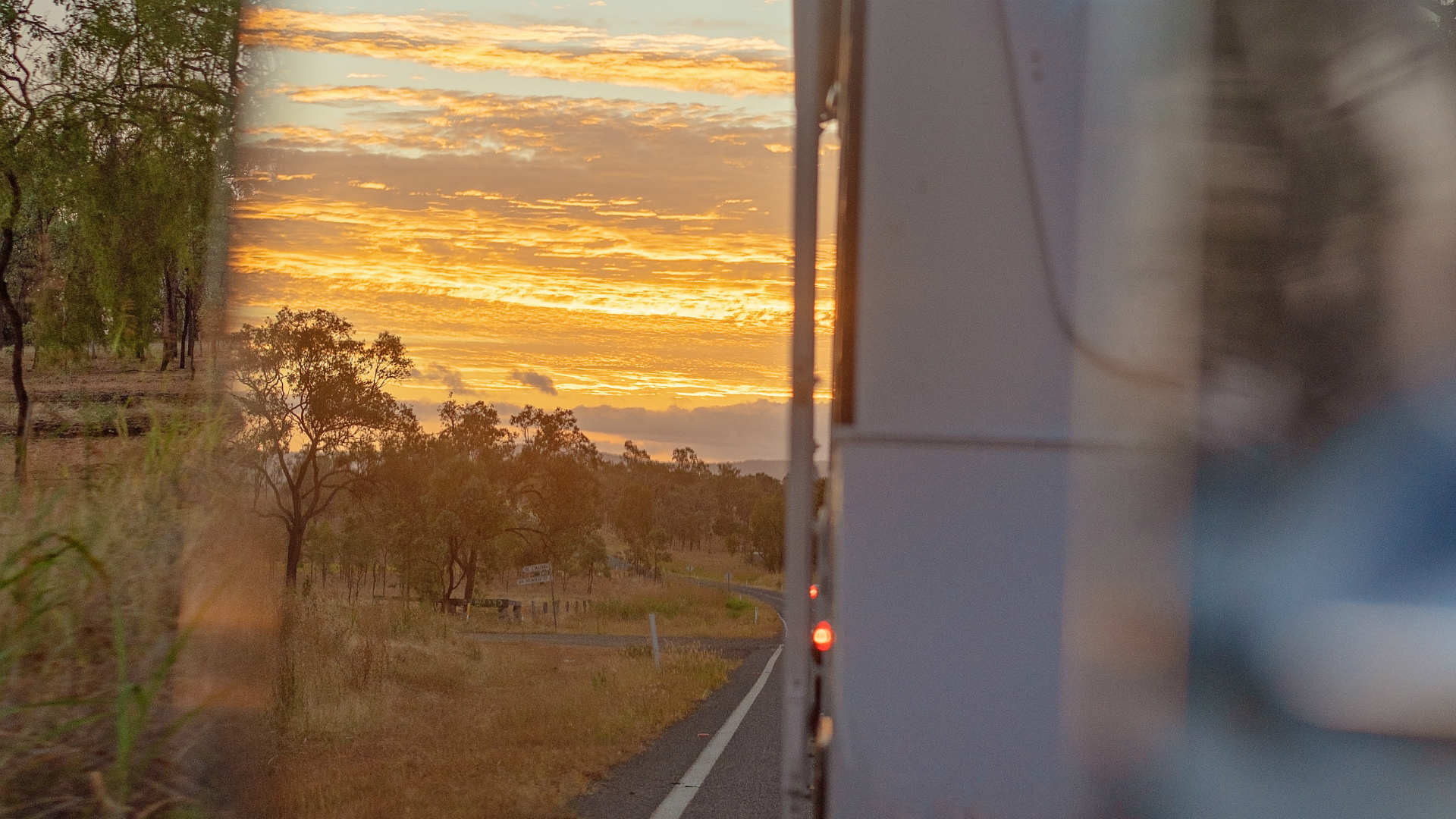
You must have an adequate view of the road behind you, and it’s a legal requirement to fit towing mirrors if your trailer or caravan is wider than the rear of your car.
The law states you must see an area that is four metres wide from the side of your caravan at a distance of 20 metres behind the driver. The mirrors should not project more than 200mm, or 250mm if they are E-marked to the latest standard.
The extended mirrors must be removed when not towing.
Driving with a trailer
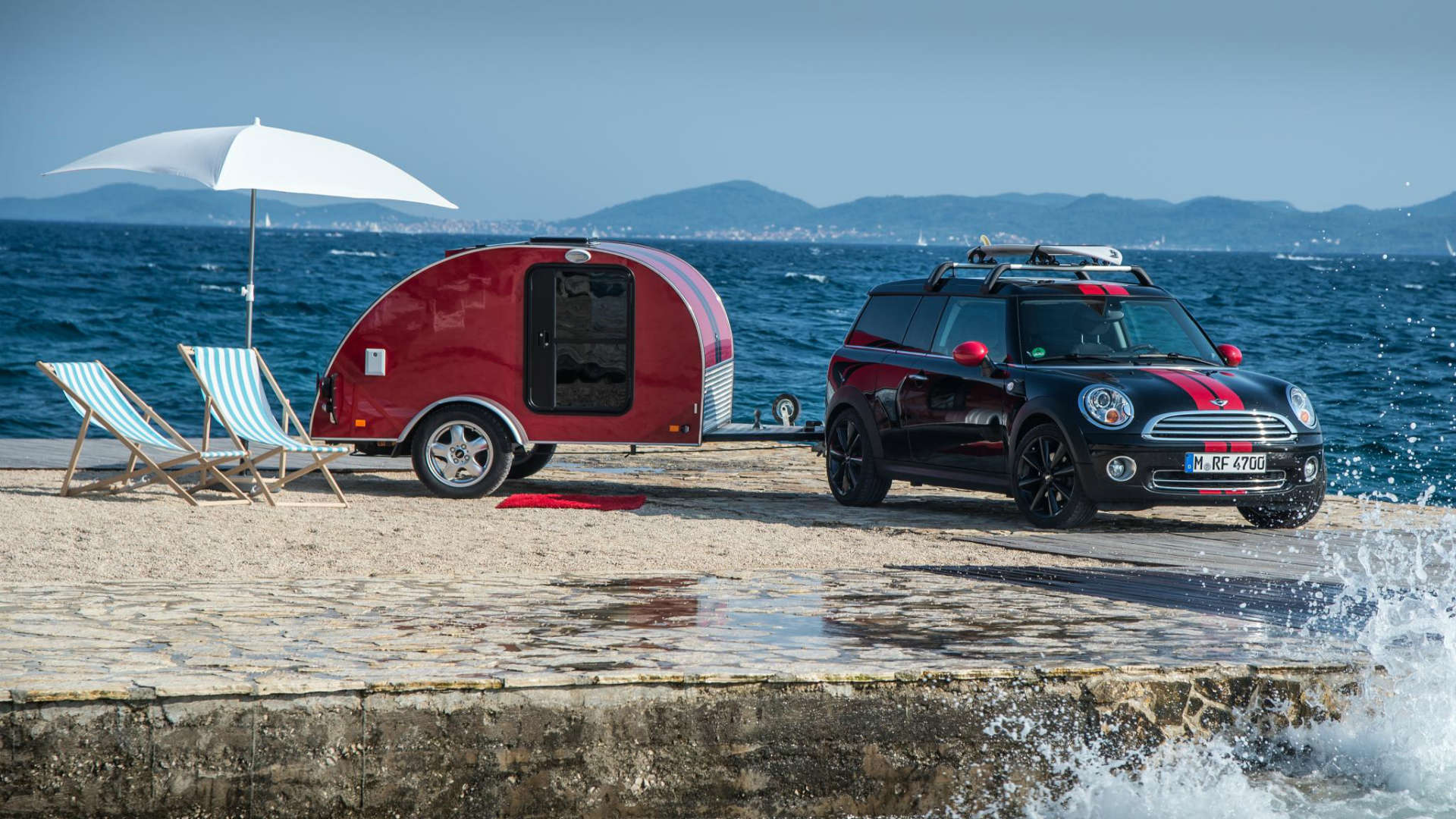
Once on the move, it’s important to remember that there are specific speed limits for cars towing a trailer or caravan.
A 30mph speed limit applies on all roads with street lighting (unless shown), with a 50mph limit on single carriageways, and a 60mph restriction on dual carriageways and motorways.
You must not drive in the right-hand lane of a motorway with three or more lanes if you are driving a vehicle towing a trailer.
As the Camping and Caravanning Club points out, ‘towing a caravan is no more difficult than driving solo’, but there are certain things to consider whenever you’re towing a trailer. These include:
- Acceleration : it will take longer to get up to speed, so allow yourself more time when overtaking or entering a motorway. Also consider your additional length before pulling away from a junction and into traffic. Braking : it will take you an average of 20 percent more distance to stop. Cornering : you will need to take a wider path on roundabouts and corners to enable the trailer to clear the kerb and other obstructions. Use your mirrors. Hill starts : you will need to use more throttle when doing a hill start, along with careful clutch control. Instability : snaking is a symptom of bad loading, inadequate noseweight*, excessive speed, incorrect tyre pressures or poor driving. Take special care when overtaking or being passed by lorries or coaches, as the air turbulence will unsettle your trailer or caravan.
* Noseweight is the downward force of the coupling head on the towball, which decreases as you accelerate. The Caravan and Motorhome Club recommends a noseweight of five to seven percent of the caravan or trailer’s actual laden weight.
Reversing with a trailer
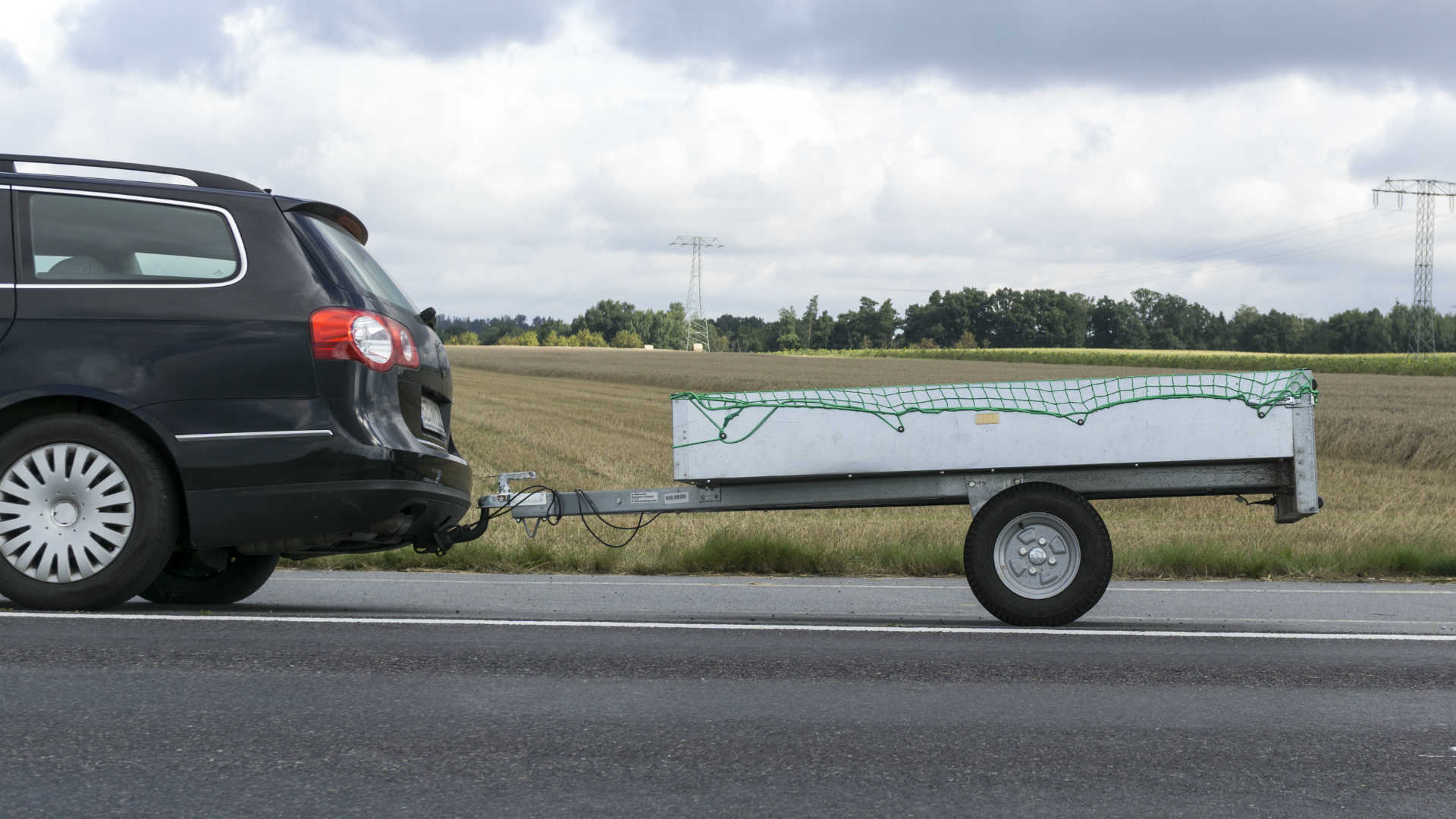
Reversing is arguably the most daunting prospect for those with little experience of towing, but it’s not as difficult as it first appears. With some practice, you could soon find that it’s as easy as riding a bike.
Size matters, so while it might be tricky to reverse with a small trailer – they turn quickly and you can’t see them in your mirrors – the manoeuvre is actually easier with a larger trailer or caravan.
Even the Camping and Caravanning Club admits that it can be “almost impossible” to reverse small trailers around corners, so it might be easier to unhitch and manhandle the trailer into position.
Regardless, it’s always preferable to ask a helper to guide you back, using predetermined hand signals. Check out this handy step-by-step visual guide to reversing with a trailer.
Final thoughts

If in doubt, contact one of the camping, caravanning or towing organisations, or consult the literature that came with your caravan or trailer. Most handbooks can be downloaded via the internet in PDF form.
Also consider attending a caravan or trailer manoeuvring training course. The Caravan and Motorhome Club offers towing courses at 16 locations across the country, with prices starting from £150 per person.
Sources and resources

- Government guide to towing a trailer with a car
- National Trailer and Towing Association guide to safe and legal towing
- The Caravanning and Camping Club’s guide to safe towing
- Caravan and Motorhome Club
- Related Topics
Related Articles
What is the margin of error for speed cameras in..., can you be fined for parking your car with the..., what are clean air zones and what are classes a,..., leave a reply cancel reply.
Save my name, email, and website in this browser for the next time I comment.
This site uses Akismet to reduce spam. Learn how your comment data is processed .
Lando Norris laps Silverstone in a McLaren P1 made of LEGO
What is the margin of error for speed cameras in the UK?
Hennessey Venom F5-M is the world’s most powerful manual car
New Bentley Flying Spur Speed debuts with 782hp hybrid V8
Drifting for beginners: we go sideways in a Caterham Seven
The full Monte: An amazing Porsche 911 road-trip
The fastest cars at the Nurburgring 2023: quickest lap times ranked
Best luxury SUVs to buy in 2024
Best family hatchbacks to buy in 2024
Best luxury cars to buy in 2024
Can you be fined for parking your car with the engine idling?
What are Clean Air Zones and what are classes A, B, C and D?

How To Tow A Caravan – Full Guide & Reversing

Due to our hard standing fully serviced pitches here at Horton Common, we get quite a lot of first time caravaning beginners who are ‘learning the ropes’ as it were. When it comes to caravanning, learning how to properly tow a caravan is obviously very important. There are lots of variables to consider and the best practice to follow. For instance, does your car and caravan outfit match and is it actually legal for you to tow it? Have you loaded your caravan properly before setting off and have you done your pre-trip checks? Finally, do you feel competent when it comes to reversing the caravan? There is a lot to learn, but hopefully, this post will help you to understand and consider the most important aspects of how to tow a caravan.
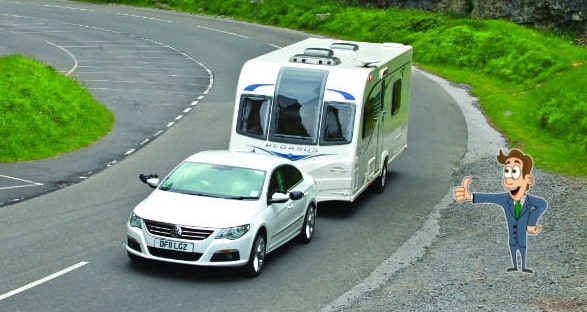
When it comes to reversing a caravan, I know from discussing it with our caravan beginner guests its the thing they dread the most.
That’s why when they arrive at Horton Common with our road and hardstanding pitches, I encourage them to test out and practice their reversing skills.
This is quite a long post with various subsections dedicated to the different aspects of how to tow a caravan. I would encourage you to read this whole post.
However, if you are just looking for information on a specific aspect of towing a caravan you can use the Table of Contents below. Enjoy 🙂
Disclaimer: Hey! By the way… any links on this page that lead to products on Amazon or Caravan Guard are affiliate links, and I earn a commission if you make a purchase, with no additional cost to you 🙂

- Dissolves waste and removes odours naturally and has delightful mild fragrance
Want To Visit Horton Common? – Book Here
Table of Contents
Introduction To How To Tow a Caravan
So I’m going to write this post from the perspective of caravanning beginners . Furthermore, hopefully, you are reading this post before you have purchased your caravan .
The reason being first and most important aspect of how to tow a caravan is the car and caravan outfit match up.
Not only does the tow car have to be capable of towing the caravan, but it also needs to be able to tow the caravan safely.
For instance, many cars have maxium towing limits far above the weight of a caravan you would sensibly want to tow.
Furthermore, depending on when you passed your test, certain car and caravan combination may be illegal under your current licence .
There is a lot to cover in this post on how to tow a caravan. Therefore I’m going to write this post with the assistance of the ‘towing masterclass’ series of videos produced by Practical Caravan.
They are currently the most compressive set of videos out there on how to safely and legally tow a caravan.
Just a quick word of warning on these videos . While they clearly appear to be sponsored by Mitsubishi, its never formally referenced.
While all of the tow vehicles are Mitsuibishies which doesn’t distract from the quality of the content, there is something which gets quite annoying.
The presenter will frequently state ‘your Mitsubishi’ instead of your tow car. But don’t let that put you off, the content of the video on how to properly tow a caravan is solid.

Part 1 – Is Your Car & Caravan A Good Outfit Match?
What Can Your Tow Car Actually Tow?
When it comes to working out a suitable car and caravan towing match up some people start with their car. Others start with a caravan they want and then purchase a tow car to suit.
For this post, let’s presume you already have a tow car in mind or you already own the car.
There are some important details to find out to understand what the vehicle can tow and what size of caravan you can sensibly tow.
As referenced in the video, the TowSafe website is also a good resource to use.
Tow Vehicle Kerb Weight – What’s That Mean?
Typically, the kerb weight of a car is calculated as the car with all fluids (oils and coolants) a full tank of fuel and a driver at 75kg.
This is generally the case, but not always so. To find out the kerb weight of your vehicle, there are a couple of places to check.
The metal VIN plate which should be fixed to the bulkhead in the engine bay, the owners manual, or you can check online. Be careful though when checking for vehicle kerb weights online .
Only use the original source, hence the manufacturer’s website. I’ve seen third-party websites (Wikipedia is a typical example) state incorrect vehicle kerb weights.
The MTPLM Of The Caravan – What’s That Mean?
I’ve previously written a post on caravan weights , but for quick reference, the MTPLM is the Maximum Technically Permissible Laden Mass.
In other words, the caravan MTPLM is its total maxium legal weight, including your belongings.
Not surprisingly, smaller single-axle caravans have lower MTPLM figures than large twin-axle caravans . The MTPLM includes the caravan user payload , hence how much stuff you can take.
Car Tow Weight & Noseweight Limits
So every car (if its legal to tow) will have a tow weight limit. This is the absolute legal maxium that the car is able to tow based on its engine, chassis and suspension setup .
Its generally very different from the weight of a caravan you should sensibly consider towing.
For instance, a towing goods trailer which is barely a meter above the ground is very different from towing a caravan of the same weight.
Weight distribution, stability and crosswinds produce a completely different towing experience. Hence the recommended 85% rule, more on that below.
Each car also has its own noseweight limit . Hence, the maxium weight the tow hitch of the caravan can place upon the car.
These vary significantly depending on the type of car and its size. For instance, in the future more of us will be using electric tow cars .
Well, let’s consider the Mitsubishi Outlander PHEV, as seen in the video above. The Outlander PHEV has a noseweight limit of 75kg compared to the Diesels 100kg .
I won’t get into the reasons why in this post, but the point is, you need to check your car’s noseweight limit and your caravan’s noseweight to find a good match.
I’ve also written a post on how to check caravan noseweights to make sure you are under your car’s maxium noseweight limit.
The 85% Towing ‘Rule’
As stated in the video, you may hear from some sources that there is an 85% towing rule when comparing the kerb weight of your tow car and the MTLM of your caravan.
Well, its not a rule strictly in terms of the law .
The only legal limitations are the car’s maxium towing limit and your own licence restrictions, more on that below.
But even for experienced caravaners, its not recommended to tow a caravan over 100% of the cars kerb weight. No matter what the towing capacity of the tow car actually is.
However, for first-time caravanners learning how to tow a caravan, I would personally advise keeping to the 85% towing relationship between your car and caravan .
Your caravan stabiliser can only do so much to avoid caravan sway, also known as snaking.
Hence, using a tow car which is at least 15% heavier than the MTLM of your caravan will make it easier to tow.
That additional weight of the tow vehicle means its more likely during patches of instability, after say, hitting a pothole, that the car will dictate the movement of the caravan.
In other words, you don’t want the tail (caravan) wagging the dog (your tow car).
Part 2 – Its Very Important To Properly Load Your Caravan
You Want To Avoid The Pendulum Effect
Over the years of running Horton Common, I’ve got to hear many different stories about how my guests journey to our site went.
If too much weight is placed towards the rear or front of the caravan this can create a pendulum effect, also known as ‘bobbing’.
For instance, let’s say you are towing the caravan down the road and you go over a speed bump . Well, a caravan which has too much weight at the front or back will tend to bob up and down as the pendulum effect takes hold.
Now that’s annoying at low speed but consider a second example, hitting a pothole at high speed. Then the pendulum effect becomes much more serious.
Hence you want to load your caravan properly with the heaviest items low down over the centre axle.
Hitching Up The Caravan
As shown in the video, before you lift the caravan corner steadies you want to make sure the handbrake is properly engaged.
When winding up the corner steadies if you feel its taking more effort than it probably should you may want to consider servicing the corner steadies when possible.
Checking the nose weight as previously referenced is very important. Both your caravan and car have maxium noseweight limits.
Therefore you want to make sure the caravans noseweight is not only below its own rated limit, but the cars rated limit.
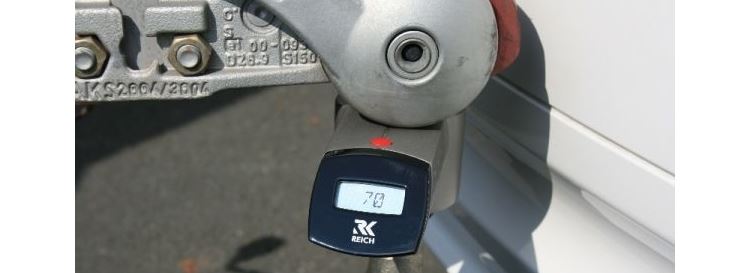
Reversing Up To The Caravan Hitch
The next stage is to wind up the jockey wheel so you can comfortably reverse the car and tow ball underneath the caravans hitch.
The point being, make sure you are a good few inches higher than the tow ball.
Thinking you have raised the caravan jockey wheel just enough may lead to you catching and damaging the caravan hitch while reversing. If you have a reversing camera on your car that should come in handy.
And there are also aftermarket reversing cameras you can order. However, if you’re with a second person politely ask them to spot you to guide the car up to the caravan hitch.
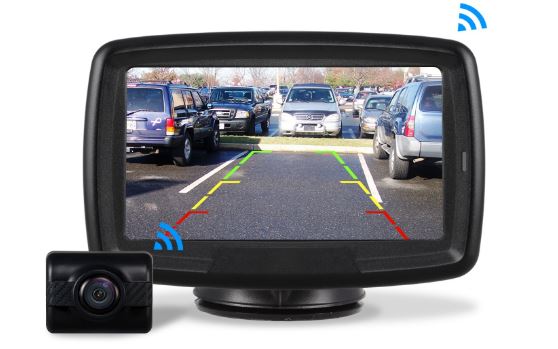
Lowering The Caravan Hitch Onto The Car
When you lower the jockey wheel and hitch onto the car do so while also lifting the hitch handle.
When the caravan hitch is properly engaged with the tow ball on the car the plastic indicator should pop up and you will see a green band.
This indicates the cars tow ball is properly engaged with the hitch socket. You then lower down the stabiliser handle then lift and tightly secure the jockey wheel.
However, if you have purchased an older second-hand caravan it may not have a stabiliser handle as seen the video.
But the same basic procedure applies for properly hitching up the caravan before towing.
You’ll then want to hook up the towing electrics and get your partner to check the lights on the caravan are working before you set off.
Attaching The Caravan Brakeaway Cable Properly
Typically, many caravanners will loop the breakaway cable around the tow ball. Some as stated in the video will “ clip it through the steel ring on the tow bar if there is one “.
The problem is, both the above methods can be both right and wrong depending on the type of tow bar fitted .
Furthermore, new best practice has been made on the type of caravan breakaway cable you should be using.
I would advise after reading this post for you to read my post on caravan breakaway cables so you know the proper procedure to follow.

New best practice states caravans should only use a carabiner type breakaway cable (pictured) opposed to the old spring clip cable: Image – Amazon.co.uk
Towing Mirrors Are Essential
With your standard car mirrors, you will not be able to see behind your caravan while towing.
Hence, when you are on the motorway without towing mirrors you will not know when someone is overtaking you, or when its safe for you to leave your lane.
I’ve heard a couple of towing mirror stories over the years from our guests. For instance, I would avoid stuck on suction cup towing mirrors. I actually think they should be banned.
I’ve written a post on the various caravan towing mirrors you can get and how you can choose the right type of mirror for your tow car.
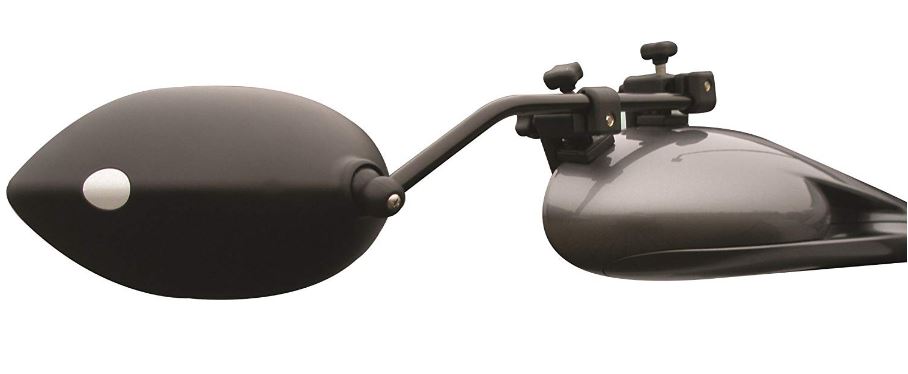
Before you set off you will want someone to help you check the lights on the caravan. You obviously want to make sure the brake lights, indicators and sidelights are all working correctly.
Finally, you can then release the handbrake on the caravan and go on your way.
Whether you choose to follow a caravan sat nav is up to you, but don’t follow any sat-nav directions blindly. I discuss the process above in more in my post how to hitch up a caravan .
Part 3 – Safe Towing On The Road
When you are driving your car without towing your caravan you obviously need to be vigilant at all times and make manoeuvres with care.
However, with a caravan on the back of your car, there are simply more variables to deal with. You are now driving a longer and heavier outfit with a wider turning circle.
So certain manoeuvres which you would commonly do with just your car require a bit of extra forethought and preparation when towing your caravan.
Overtaking While Towing A Caravan
As stated in the video you really need to be confident you have enough time and space to not only pull out safely, but also rejoin the lane.
The first time you ever overtake while towing your caravan give your self far more space than you think you need .
The reason being you won’t know how quickly your car will be able to accelerate with the additional weight of the caravan on the back. If you have a manual gearbox you can obviously drop down a gear.
With an automatic, the car may take longer than you think before it provides the power needed to overtake.
In the future with electric tow cars and their significant torque benefit, overtaking manoeuvres will be a lot easier and hence safer.
Braking While Towing A Caravan
While you have to factor in the additional weight of your caravan while accelerating you also have to do the same while braking.
When towing your caravan start to brake earlier than you normally would when purely driving your car .
The caravan brakes just like your car brakes do require servicing. I’m aware some of our guest service their caravans brakes themselves.
However, I would encourage every new caravanner to get their caravan serviced at a service centre annually where they will fully service the brakes.
Snaking – How To Regain Control Of The Caravan
Caravan snaking (also referred to as sway) is where the caravan starts to move side to side. Hitting a large pothole at speed or a rapidly overtaking a lorry may cause snaking.
However, as stated in the video with a correctly matched car and caravan which is loaded properly its a pretty rare occurrence.
If your caravan does start to snake don’t try and accelerate out of it. Accelerating during snaking for a while did appear to be what may be cited as the solution.
However, the best and safest method to resolve sway is to let off the accelerator, but don’t brake.
Just hold the steering lightly and true in the centre and as you let off the accelerator the caravan should start to settle down and straighten up.
Your caravan may be fitted with the AL-KO ATC system which should also help to correct sway even more quickly.
Part 4 – How To Reverse A Caravan
I know many of our caravanning beginner guests fear to reverse their caravan.
Even our most experienced guests often unhook their caravan on our road and use their motor mover to position the caravan on to their pitch.
Generally reversing a caravan is the most dreaded part of learning to tow a caravan.
That’s why when I get caravan beginners visiting Horton Common I encourage them to test out their caravan reversing skills on our safe private road and pitches .
There are times on the public highway where you simply must be able to reverse the caravan.
Therefore its vital that you understand the principle of whats going on when reversing your caravan. As this is the trickiest still to learn I’ve actually written a separate post on how to reverse a caravan .
Left Is Right & Right Is Left – What?!
Yes, when it comes to reversing your caravan you have to remember to do the opposite of what you would normally think to do.
The reason being your car and caravan are connected via a pivot point. So as your car applies force going backwards your caravan will be forced in the opposite direction.
When it comes to reversing straight back just turn the wheel at the side mirror you see the caravan getting larger in .
If the caravan is not getting larger in either of the mirrors you are going straight back with the caravan inline with the car.
Its important to remember you usually will not be able to see directly behind the caravan when reversing in a straight line.
So either fit a reversing camera to the back of your caravan or ask a second person to spot you.
Reversing A Caravan Around A Corner
You are typically going to have to learn to reverse around a corner to get onto your pitch. That is of course unless you choose to uncouple the car and caravan and use a motormover.
The same basic principles apply when reversing around a corner as stated above.
However, there is something important to note, and that’s your starting position. On our site, guests will enter and drive past the pitches on their left.
To make sure the front of the car while reversing does not come off the road onto the potentially soft grass on the right-hand side you need a good starting position.
Therefore, the car and caravan should start on the left-hand side of the road to account for the front wheels on the tow car swinging around to the right.
Conclusions On How To Tow A Caravan
Learning how to tow a caravan safely all starts with a good (and legal) car and caravan matchup.
If you are at a caravan dealership browsing various caravans and you still need to purchase a new tow car asked the dealer what they would recommend for that size of caravan.
However, obviously check the figures (kerb weight, noseweight etc) your self on what would be a suitable matchup.
I believe most people new to caravanning start with their tow car and choose a caravan to suit. Therefore, I would also encourage you to read my post on what I think are the best cars for towing a caravan .
I would encourage to watch the videos above multiple times. Safe caravanning is as much about good preparation as it is about having all the bells and whistle of towing accessories.
As stated previously, if you do decide to come and visit us here at Horton Common in the future I would encourage you to try out your reversing skills on-site even if you have a motor mover. Thanks for reading. 🙂
Chris - Site Manager
Hi, I’m Chris Scott , along with my father Robert we operate and maintain Horton Common Caravan Site . Located in the Staffordshire Moorlands, Horton Common Caravan Site benefits from expansive views over the Peak District National Park.
Recent Posts
Best Caravans With Rear Washrooms - For All Budgets
There are some people who only visit club sites with toilet/shower facilities and have little to no interest in using the facilities onboard their caravan. At the other end of the spectrum, there are...
Best Caravans Under 1,500KG MTPLM - For Each Layout
I've previously written about the best teardrops and the best small caravans, essentially caravan's with a weight under 1,000 kg. What I wanted to do with this article is discuss the best caravans...

Hooking up and what to expect when towing a caravan for the first time Towing a caravan for the first time? In this ultimate guide to towing series, we discuss hooking up and what to expect on your first tow.
In this ultimate guide to towing series , Robert Pepper discusses how to remember the steps to hooking up your caravan and what to expect when towing a caravan for the first time, including turning, climbing hills, braking, visibility and more.
Towing a heavy caravan or trailer is difficult, potentially dangerous and nobody is born with the skills, despite what OldMate58 might opine on the Facebook forums. You wouldn’t expect someone who has never driven to just get in a car and drive, and nor should we expect someone who has never towed to just hook up and hope.
So let’s talk through your very first tow – and that starts with hooking up. The connection of towcar to trailer is more a practical, show-me sort of thing, so I won’t go over it in great detail here but just offer some pointers. Like learning to drive, it’s best to start towing your caravan for the first time somewhere quiet at a quiet time. Maybe an industrial suburb with big roads you can cut a few laps around, certainly not busy suburban streets with impatient drivers.
First, the preparation prior to towing your caravan. You’ve read our article on weights and loading , so I’ll assume your car is able to and legal to tow the trailer. I’ll also assume your weights are within limits, you’ve fitted towing mirrors if necessary, your caravan insurance is up-to-date , and so on. And now you’re all ready for the hookup!

Remember …. PECJABS-P
There will be quite a few things to connect the caravan to the towcar so you can tow, and it’ll depend a bit on the caravan. We’re dealing with travel trailers here though, not simple garden-shed like 6x4s. Here’s an easy acronym to remember – PECJABS-P.
P is for Pin, which is the pin that secures the hitch itself, which may be a standard 50mm towbar or an offroad hitch, the main connection between towcar and caravan that takes all the force and weight when towing. I’ve made it Pin as that’s the last thing you do with a hitch as there’s always some sort of final securing mechanism. Not all hitches have pins, some have latches, so you can make this the last step needed to secure your hitch.
E is for Electrics. Those are the basics of brakelights, indicators and the like, either a round 7 or flat 12 or 7 pin plug.
C is for Chains. One for trailers under 2,000kg GTM, two for above, and if so, cross them. Secure with something legal – see our Yellow Hooks article for that.

J is for Jockey Wheel. Raise/remove and stow.
A is for Auxiliaries. This is usually just an Anderson plug.
B is for Breakaway, the emergency brake system that activates when the caravan disconnects from the towcar when towing. It’s required for trailers above 2,000kg GTM.
S is for Security – is everything locked, doors shut, awning away, things tied down?
P is Park Brake – finally, take it off and you’re good to go!
You can modify this to suit your own needs, but it’s worth having a caravan towing checklist. Every experienced trailer driver has, at some point, driven away and forgotten to connect something, so mitigate that risk.

It’s time to actually tow your caravan
Okay, so you’ve prepped the car, and connected the caravan…time to actually tow! Here’s some differences between driving with a caravan, and without.
Slower acceleration
Into Drive and away you go. You’ll notice immediately the car is slower to pull away when towing a caravan. This is not surprising as the engine probably has close to double the weight to pull. Just be patient. Now try to brake –it takes longer, even with your brake controller set correctly. See our Brakes and Braking article for a how-to.
Visibility to the rear
You’ve got a big block behind you now, so if you were used to looking through the rear window or using your interior mirror…forget it, it’s side mirrors from now on, and they may be smaller than before. There’s also no longer part of a car in the mirrors, it’s a caravan, and that may entirely block your rear vision when you’re towing as your corner.
Cut-in on corners
One of the things you need to learn when towing a caravan for the first time is cut-in. Essentially, when the rig turns a corner, the back wheels of the towcar will describe a shorter, tighter arc than the front wheels, and the trailer wheels will turn tighter again – which is cut-in. This needs to be accounted for by swinging out wider when you’re turning. Cut-in gets worse the longer the turn, so you find more on a 180-degree turn than a 90-degree turn, and the tighter the turn, the worse it is. On a freeway at speed, it’s no worry at all, turning down a suburban street, and it becomes a problem. Watch the big trucks on small streets – see how they swing out? That’s what you need to do too. Best practice in a carpark with some traffic cones.
Lane changing
You’re more than doubled the length of your car, so that means you can’t just swap lanes like you used to! It can take a while to get used to the extra length when towing a caravan, and planning ahead makes all the difference.
Even if your brakes are set up correctly, the rig will take longer to stop, so guess what…plan ahead!
These days we’re used to cars not slowing even on the steepest hills at the highest speeds. But when you’re towing a caravan, that may well change, back to the days of having to accept a slow-down on hills. This means you’ll need to keep left and let faster traffic pass.
Descending is also a problem. Your towcar brakes are designed for normal driving, which is relatively gentle stops, infrequently, with the capacity for a full-on emergency stop when needed. They are not designed for towing, which is why heavier trailers have brakes. Nor are the towcar brakes designed for long descents, with or without a trailer. Combine the two and you have a very real risk of overheating your brakes to the point where they are dangerous.
The solution – dial up the trailer braking a bit so the trailer does more work, and manually select lower gears so engine braking helps slow the car, relieving the pressure on the brakes. That often means using third and second on the towcar. The engine revs a bit higher, but it’s much safer.
Manoeuvring
When you’re not towing a caravan, you can pretty much launch into any small space like a carpark, caravan park or the like. You will always be able turn around or back out, and everything is made to be car-sized.
With a trailer all that changes. You will need to assess things before you go anywhere near a confined space as it’s entirely possible to end up in a situation you can’t get yourself out of unless the trailer is unhitched, and even before that time you need a LOT more space to manoeuvre.
There’s now maybe 150kg to 350kg pressing down on a lever about 1.5m behind the rear axle. In other words, there’s a big heavy thing trying to boss the car around. This may well lead to more bouncing than you’re used to. A good tip is to drive roads you’re familiar with and see the difference when towing your caravan. Take a lap or two first without the trailer, then with. A bouncy ride means less grip, and less grip means greater stopping distances, so slow down. A bit of bounce is normal, but too much and that’s a sign something is amiss, possibly suspension softness or too low a tyre pressure on the rear.
The towcar isn’t going to go around corners the way it used to when towing a caravan, so you’ll need to slow down and be smooth. There’s simply more mass to deal with, and the trailer will be trying to go straight on, relying on the towcar to pull it around. The suspension has to work harder too, and that may also potentially reduce grip. In short, you can’t drive 5 or 6 tonnes of trailer and car like you just would the car.
Towing a caravan – what’s the best way to learn?
Take a training course! Towing a caravan is not simple and despite what some may say, it’s not just “common sense”, whatever that means. A towing course will answer your questions and give you some confidence to start learning, and I strongly recommend one for all new towers.

Here’s the good news and bad news
The bad news is that towing a caravan or trailer is not easy and you definitely need to learn new skills which, despite what some say, nobody is born with or ‘just knows because it’s common sense’. The good news is if you have learned to drive you can learn to tow – it’s less of a jump from driving to towing than it is from not driving to driving, so don’t be put off!

Sign up for our free weekly newsletter
Get all the latest news, reviews and how-to's delivered straight to your inbox..
Towing a caravan for the first time? In this ultimate guide to towing series, we discuss hooking up and what to expect on your first tow.

Leave a Reply Cancel reply
Your email address will not be published. Required fields are marked *
Save my name, email, and website in this browser for the next time I comment.
LATEST DEALS:
- Best 0% APR finance
- Best deposit contributions
- Cheapest cash offers
- Cheapest PCP offers
Back to top
What speed limits apply when towing a caravan or trailer?
To find out the speed limit you just read the signs, right not if you're towing a caravan or trailer, but our guide has everything you need to know....

Mercedes CLE
Bentley continental gt, volkswagen taigo.
When towing a caravan or trailer, you will often need to abide by different speed limits to those which apply in normal, everyday driving. And confusingly, the speed limits for cars which are towing and cars which aren't are the same on some roads but different on others.
For anyone towing a caravan, trailer, or horsebox, it's important to learn what the limits are. There's no secondary sign to remind you if you need to tow at a speed that's lower than the signposted limit, so if you want to avoid being pulled over and potentially adding points to your licence it pays to know the law.
With some help from our Tow Car Awards colleagues, here's our guide to the speed limits which apply while towing.
On the motorway
Everyone knows the speed limit on the motorway is 70mph, right? Well, it is when you're driving a car without a trailer and there are no roadworks or temporary speed restrictions, but you'll need to travel more slowly when towing a caravan or trailer.
Petrol, diesel or hybrid: which should I choose for towing? >
The fastest you are permitted to go is 60mph. It might seem irritating to chug along 10mph more slowly than all the other law-abiding drivers, but this lower maximum speed helps keep a car and caravan stable and safe.
As well as sticking to the limit, there's another rule towing drivers should be aware of: if the motorway has three lanes or more, you're not allowed in the outside lane. It can be frustrating if one lorry is overtaking another with barely any difference in speed between them, but the rule is there to ease the flow of traffic and make sure the outside lane isn't clogged with slow-moving vehicles.
On a two-lane stretch of motorway, it's fine to use the outside lane to overtake while towing, so long as you return to the inside lane once the manoeuvre has been completed, just as you should when driving without a caravan or trailer.

On a dual-carriageway
Here it's the same story as it is on the motorway. Or at least it is when the limit is 70mph – you have to drive 10mph slower when towing.
If there's a lower limit, however, that also applies to you. So, if the posted limit on a dual-carriageway is 60mph or less, you don't need to keep driving 10mph below the speed of other traffic
On a single-carriageway
On single-carriageway roads where cars are permitted to travel at 60mph, the limit for a car towing a caravan or trailer is 50mph.
This can be frustrating if you feel you could tow your caravan at 60mph and avoid holding up traffic behind you, but to stay the right side of the law you do need to stick to 50mph.
If you see a queue forming in your mirrors while towing, it's good manners to pull over and let traffic past when it's safe to do so. In fact, it's not just a question of manners – it's in the Highway Code. Rule 169 states: 'Do not hold up a long queue of traffic, especially if you are driving a large or slow-moving vehicle. Check your mirrors frequently, and if necessary, pull in where it is safe and let traffic pass.'
How to reverse a caravan or trailer >
Where the limit is 50mph, 40mph, 30mph, or 20mph.
If a lower limit applies to car traffic, then it applies to a car towing a caravan, too. If the posted limit is 50mph, 40mph, 30mph, or 20mph, then that's how fast you're allowed to drive when towing a caravan.
Remember, in the words of driving instructors everywhere, these speeds are limits, not targets. Driving at a speed that's appropriate to the conditions is especially important when towing a caravan or trailer, as stopping distances will increase and stability in strong winds or when cornering is compromised compared with driving a car without a caravan behind it.
On a motorway or dual-carriageway where the limit for a car is 70mph, then drive at 60mph to stay the right side of the law while towing. On a single-carriageway with a 60mph maximum for cars, you should tow at no more than 50mph to stay legal. On roads with lower speed limits, the maximum for cars towing a caravan or trailer is the same as it is for other cars.
Read more: Best cars for towing >
For all the latest reviews, advice and new car deals, sign up to the What Car? newsletter here

Best luxury SUVs 2024 – and the ones to avoid
The best luxury SUVs are as practical as they are classy and as desirable as they are relaxing to drive. Here we count down the top 10 – and reveal the one to avoid

Volkswagen T-Roc long-term test
Is this former What Car? Small SUV of the Year the perfect companion for our senior videographer? That's what we'll find out as we put our long-term T-Roc to the test

New Mini Countryman and new Volkswagen Tiguan vs Volvo XC40
Mini and Volkswagen have conjured up new models to take on Volvo’s family SUV stalwart, the XC40. Let’s see if this spells a changing of the guard

Top 20 cheapest cars to insure in 2024

London Congestion Charge: everything you need to know

Real MPG: most economical small SUVs

Deal of the Day: Save more than £3000 on a new BMW X1

Used test: Volkswagen Golf vs Volkswagen T-Cross

Best hot hatches 2024 – the most fun, and the one to avoid
Also consider.

Audi Q6 e-tron deals

Mini Cooper Electric deals

Polestar 4 deals

Rolls-Royce Spectre deals
Quick search.
- All car reviews
- All new car deals
- Used cars for sale
- All used makes
- Vans and commercial vehicles
- New car awards
- Used car awards
- Classic & Sports Car
- Move Electric
Tools & services
- Car finance
- Car warranty
- Gap insurance
- Sell your car
- Car Leasing
- Car Valuation
- Company car tax calculator
- Van tax calculator
- Terms & conditions
- Cookie policy
- Privacy policy
Information
- About What Car?
- Contact What Car?
- Subscribe to our newsletter
- Subscribe to What Car? magazine

What Car? is part of Haymarket Automotive , a division of Haymarket Media Group © Haymarket Media Group 2024


Big Outdoor Adventure

When Is It Too Windy To Tow A Caravan?
Some of the links below are affiliate links. As an Amazon Associate, I earn from qualifying purchases. This means that, at zero cost to you, I will earn an affiliate commission if you click through the link and finalize a purchase.
Towing a caravan can be hard as you have to keep your speed steady and watch for adverse weather conditions. All these elements can cause your caravan to bounce, snake and even tip.
Knowing when it is too windy to tow a caravan can be based solely on the wind speeds. Speeds between 25-30 miles per hour are harder to drive through and only advised for confident drivers. Any winds over 31 miles per hour should be avoided as these are the most dangerous.
With this in mind we have put together this helpful article to help you know when it is safe to tow a caravan in windy conditions, how best to prepare both your tow vehicle and caravan along with what you should do if you cannot tow your caravan due to high winds.
How To Check The Wind Prior To Your Trip
Checking the wind before hitching up your caravan will ensure you know what you are about to drive into. Being informed will give you peace of mind and make your trip run much smoother, safer, and more efficiently. You should first check your local weather report using a reliable online service. You will want to find the most technical service you can, to check wind speed, gust, and wind direction.
I personally use a handy application called windfinder. You will find this on your phone’s app store. I love this app because you can access wind maps, charts, and predictions for several days ahead.
As well as checking your local weather you will need to check the conditions on the route you will be taking. If you are heading on a tour or driving to a campsite that is many miles away, conditions can vary drastically. This is another reason I enjoy the windfinder app because not only can I check my route before I leave, but I can also check it while sipping coffee at a service stop mid-journey.
How To Ensure Your Caravan Is Safely Hitched
Making sure your caravan is correctly hitched before any trip is extremely important to caravanning safely. An incorrectly hitched caravan can lead to disaster in perfect weather conditions, so you can only imagine what a catastrophe it could cause in poor conditions. Hitching (or coupling) your caravan to your tow vehicle is simple and easy as long as you follow a straightforward procedure.
Using this same routine every time you hitch your caravan up to your vehicle will ensure you never make any mistakes.
Follow the 6 simple steps below to make sure you are hitching up perfectly every time and remember to double-check everything even if your certain everything is fine.
- First, you need to position both your vehicle and caravan. Crank your caravan up on the jockey wheel and make sure there is enough room to back the tow ball underneath. Back your car up as close and as accurately as you can, don’t worry if you are a little bit off, you can always move the caravan by hand. If you need to reposition the caravan, make sure you can either manage by yourself on flat ground, have someone to help, or are using a motor mover.
- Once you are all lined up you need to drop the jockey wheel, so the hitch falls over the tow ball. At this stage, if your caravan has a break-away cable you should connect it. Make sure there is enough slack in this cable even under tight maneuver when driving.
- Once you have connected the break-away cable (if applicable) you will need to connect the coupling to the tow ball. How you do this can vary depending on the age and make of your caravan but generally, you will have a lever that is pulled as the coupling is lowered over the tow ball. Once in place, the lever is released, and the lock is engaged. You should hear a click when the coupling is locked however with some older trailers you may not hear this.
- Double-check your coupling! Make sure levers/ handles are in their locked position and the coupling is securely connected to your vehicle’s tow ball.
- Stow away your jockey wheel so it is completely clear of the ground. Fully wind the wheel up and then loosen the clamp on the A-frame to lift the stem and wheel as high as possible off the ground. Make sure the clamp is fully tightened.
- Finally, connect up all of your electrics and check that they are working. Ask someone to check your rear brake, indicator, and stoplights to ensure they are working before hitting the road. Double-check everything again and then you are ready to go!
Does The Wind Affect Whether Or Not You Should Tow?
The wind is a huge factor that will ultimately determine whether it is safe to tow your caravan or not. Heading out in strong winds can be fatal because your caravan has the potential to pull you off the road in a strong side wind. If you are ever concerned about the wind and do not feel comfortable driving in the conditions you are met with, it is probably best to stay put! Of course, sometimes it is difficult to stay put if you are due to leave your campsite and have no choice to tow.
If the winds are gale force, then the campsite owner will probably advise you not to tow anyway but if they are particularly high but not seen as gale force, then you may have to leave. If this is the case, you must prepare yourself, your car, and your caravan for the journey. Although in this situation you are probably heading toward home, you should fill up your clean and grey water tanks.
This may sound stupid at first but the extra weight so low down in the caravan gives your trailer a lower center of gravity, making it much more stable and resistant to rolling on the road. You should also place any large or heavy items on the floor of your caravan to help further.
Make sure your towing vehicle is fully fuelled up and ready to drive the distance ahead of you. Keep high-vis jackets and provisions in the car just in case you have to stop because it is too dangerous to continue. Make sure you keep your speed down and err on the side of caution as you are driving.
If a strong side wind does hit your caravan while on the road, make sure you do not overcompensate with steering or sharp braking as this could encourage snaking or worse, toppling. During a side wind slowly ease off the gas and continue straight with both hands firmly on the wheel, if it is too much, pull over to the side of the road with your hazard lights on.
So, how much wind is too much wind? Generally speaking, winds of under 24 miles per hour are completely safe to tow your caravan through normally. Winds of 25 – 30 miles per hour can be driven in if you are confident with towing however you should drop your speed and be cautious on your travels. Winds of over 31 miles per hour should be completely avoided as driving in these conditions is a safety risk to you and the other road users around you.
It is not uncommon for sudden gale-force gusts to put commercial moving vans and even lorries on their sides, so it is extremely important that you do not risk driving in winds that are too strong or wind that you are not confident in. If a lorry can’t stay upright, then your 4 berth tourer has no chance!
When Should You Not Tow A Caravan?
There are a few conditions where towing a caravan is far too risky. It is important to be able to identify these conditions and realize when you should leave the caravan parked up or stop towing if you are already on the road.
As mentioned throughout this article, the wind is one of the most dangerous conditions to drive in with your caravan in tow. Knowing whether it is too windy to tow or not is vital to your safety and the safety of other road users, so be responsible and assess the situation to act accordingly. Whether the conditions are too windy to tow ultimately comes down to the individual that is towing and the caravan itself.
However, most caravans are not particularly aerodynamic and no matter what you are towing with, you can get caught out by a side wind hitting the large flat “sails” that are the sidewalls of your home on wheels.
As mentioned earlier, you should be cautious and reduce your speed during winds of 25 – 30 miles per hour and avoid towing at all costs during winds of over 31 miles per hour. It is not only the wind that you should avoid towing in either. Although we won’t be going into huge amounts of detail about other dangerous towing conditions there is one that is worth mentioning.
Depending on where you live in the world, the winters can bring some incredibly troublesome weather to caravaners. The snow and ice are the biggest safety concern during the winter, and it is a threat to normal cars let alone cars in tow. Unless you are kitted out with winter tires on both tow vehicle and caravan and have snow chains for particularly bad roads, you should not attempt to drive in the snow.
It doesn’t take much for you to lose control of a vehicle in severe winter conditions especially if you are towing a single axle caravan. If you find yourself trapped in a snowstorm unprepared, your best bet is to leave your caravan on your pitch and drive home or stay put. This isn’t to say you can’t use your caravan during the winter, but you have to be responsible and kit your rig out ready for the conditions.
What Should You Do If It Becomes Too Windy During Your Drive With Your Caravan?
If you find yourself fighting the wind while out on the road, then you will have to make an important decision. This decision is whether to stop and wait for the wind to calm down or carry on your journey if it is safe enough to do so. You should assess the factors at hand and if you feel like it is unsafe to continue driving you should find somewhere to pull over and rest until the wind dies down and it is safe to continue on.
If you find yourself getting blown around by dangerous winds, slow down gently and continue on the road you are on at a much slower pace. Find somewhere to park up on your GPS, this may be on the same road or off on a side road somewhere. Only pull over onto the side of a main road if it is an absolute emergency. Once you have found a place to stop for a while you should check your wind application or local weather to find out if and when it is safe to move on.
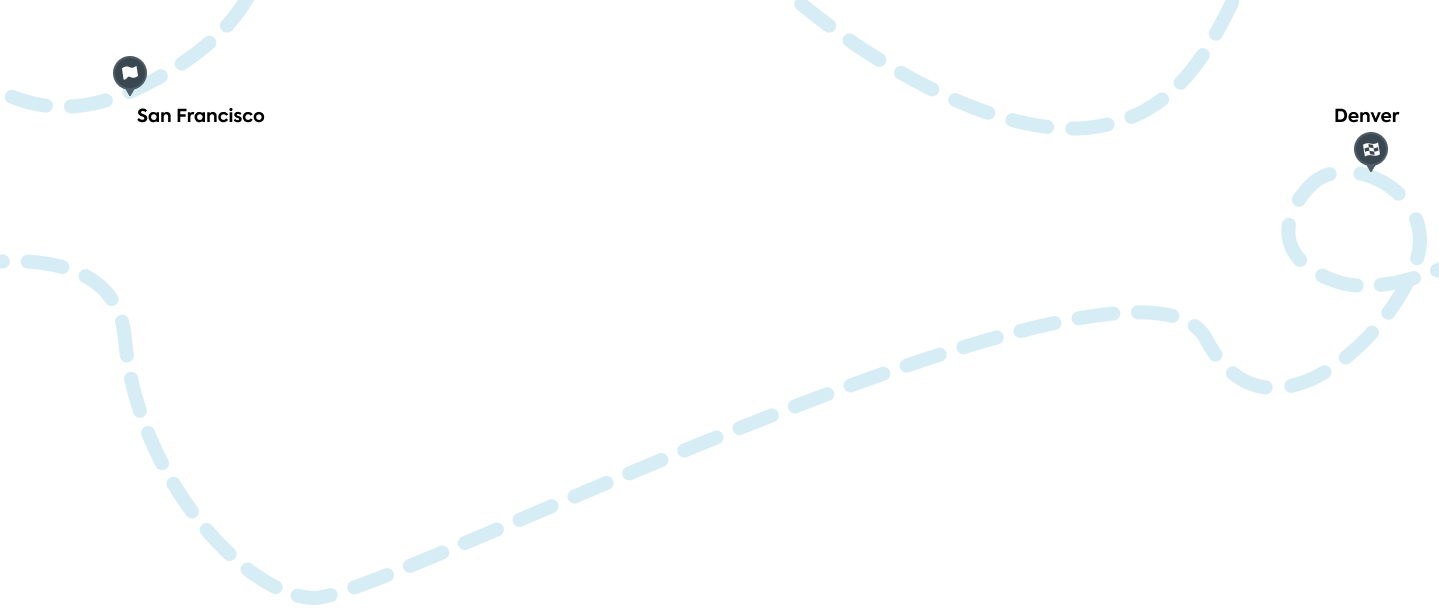
Discover a smarter way to RV
Powered by AI and what we’ve learned from 38 million trips, Roadtrippers Autopilot™ plans your trip for you.

Premium members enjoy the ability to add more stops, explore alternative routes, and discover hidden gems along the way.
Stay ahead of the curve with real-time traffic updates, and wildfire smoke maps support to ensure a smooth and worry-free journey.
From secluded spots to full hookup campsites, easily find and book the perfect campground.
Tailor your route with precision, knowing that every turn is calculated with your RV's size in mind.
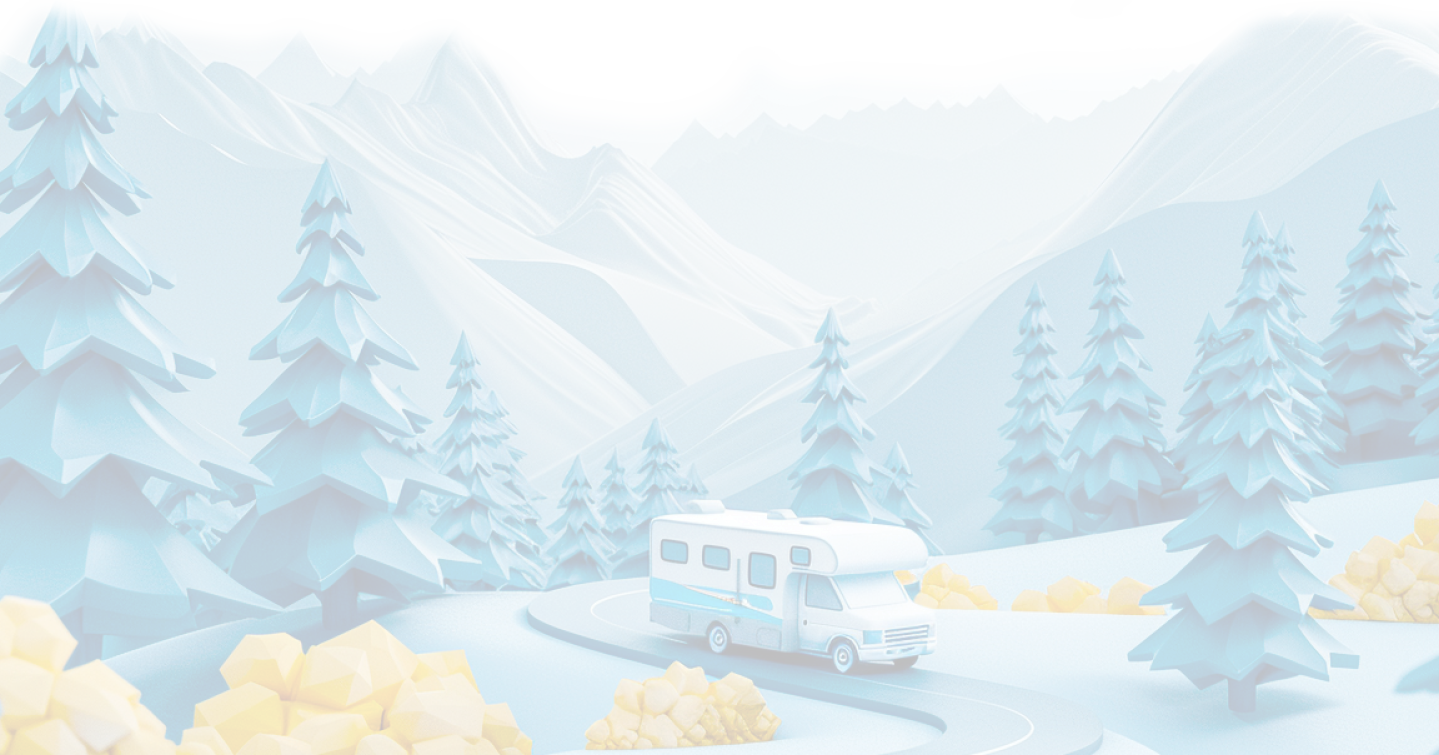
Exclusive Access To Autopilot
Let us do the planning for you! Enter in a few key details and we’ll craft a custom tailored trip just for you.
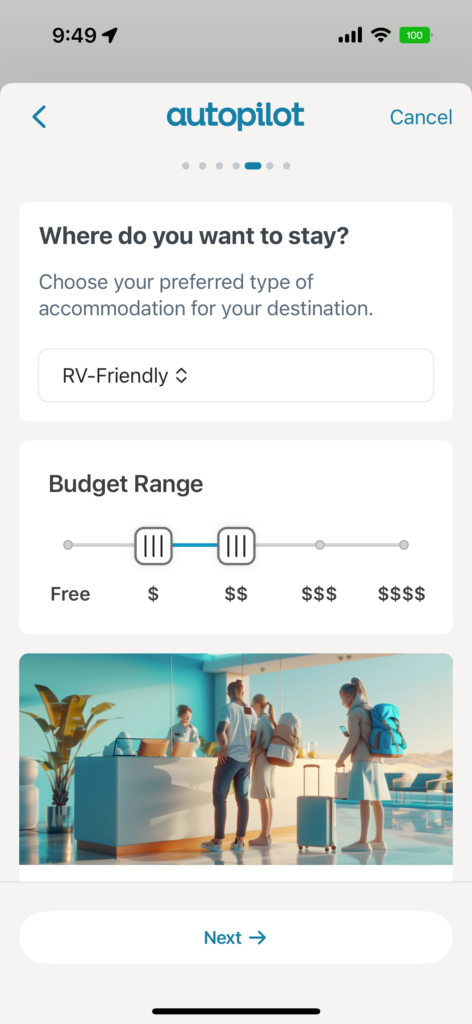
Your All-In-One RV App

Get There Safely
Get turn-by-turn navigation customized for your RV. Hit the road with confidence.
Find over 16,000 free places to park your RV on your way to your destination.
Find the Best Spots
With more than 50,000 campgrounds, Roadtrippers is the go-to resource for millions of RVer just like you.

Choose the right plan for you—and try it free for 7 days
Premium planning.

RV-Friendly Tools

Overnight RV Parking

Start free for 7 days
Then $35.99 (that's only $2.99/month), then $49.99 (that's only $4.17/month), then $59.99 (that's only $4.99/month).
† RV-Friendly routing features (including routing warnings for vehicle hazards and propane restrictions) are available in the U.S. only.
Sign Up for a Free Trial
Test drive the best features of Roadtrippers Premium for free! Eligible users will get exclusive access to all the tools needed to plan the perfect road trip.
Create a Roadtrippers account to start your 7-day free trial.
Already have a Roadtrippers account?
We need your email address
Before we can sign you up for Roadtrippers, we need your email address. Click the button below to go to your profile.
Plan your next adventure with Roadtrippers
Due after 7-day free trial
Thank you for signing up for a Roadtrippers Subscription
Get started planning your next trip now!

Good news...you already have Roadtrippers!
Thanks for being one of our most dedicated users.
- Sign up Log in Sign out
- Log in Sign out
Plan your journey, find amazing places, and take fascinating detours with our app.
If you used to sign in with Roadpass, you should now use the same username and password to log in directly with Roadtrippers above.
We couldn't find an existing Roadtrippers account using that service. Please try signing in with another option.
We need your email address to send you trip itineraries and other updates.
How do you want to plan your trip?
With just a few questions, our newest Premium feature, Autopilot, will plan your next adventure.

💦 Towing a Caravan With Full Water Tanks (Pros & Cons)
A huge discussion, which caravanners can be quite emphatic about, is whether or not you should tow a caravan with full water tanks or leave them empty.
There’s no doubt about it, towing a caravan with full water tanks gives you better stability, eliminates water slosh and keeps you well prepared. However, towing with empty water tanks can give you better fuel economy and allow you more payload for other items.
So, which is better?
A few additional factors are at play when deciding whether you should tow with full or empty water tanks.
- How far away is your next destination?
- Are you able to fill up your water tanks when you get there?
- Are you going to be travelling in windy conditions?
- Are you trying to save money on the fuel budget?
- Do you have enough payload to travel with full water tanks?
There are solid arguments for both sides of the fence, so let’s have a look at the pros and cons of each scenario – towing with full water tanks and towing with empty water tanks.
We are a participant in affiliate advertising programs designed to provide a means for us to earn fees by linking to ebay.com and other affiliated sites. We may earn a commission from your purchases at no extra cost to you. For more information, see our disclosures here .
Towing with FULL Water Tanks
Full water tanks can help with load distribution.
Technically, all caravans should be built to tow safely, irrespective of whether the water tanks are full or not. But, there are many factors that can greatly affect the handling, such as how the caravan has been loaded and if it’s being towed with a correctly set up vehicle.
Most caravan water tanks are positioned over the axle group or just in front of the axle.
The greatest portion of the weight should be over the axles, with some weight at the front and a little less at the back. With that in mind, filling up the water tanks will put the majority of your weight over the axles, which is perfect.
Working out the weight of your water is very simple:
1 litre = 1 kilogram
Have a look at the picture below for a quick visual on how to load a caravan correctly.

Regardless of whether you’re towing a caravan with full water tanks, you still need to make sure your load is evenly distributed for those times when you do travel with them empty.
Below is a great little video showing just how easily you can swerve out of control simply by having the weight unevenly distributed throughout the caravan.
▶️ VIDEO: Caravan Weight Distribution Explained
Full Water Tanks Provide Extra Stability
Filling up your water tanks for towing puts a lot of extra weight down low in your caravan. This effectively lowers the centre of gravity, which increases the caravan’s stability.
If you can imagine a car driving along with the roof fully loaded, but nothing packed inside of the car – the centre of gravity is up high, making the whole vehicle less stable and more likely to roll or crash in the case of an accident. You want that extra weight as close to the ground as you can.

When travelling on a windy day, you’ll be much more aware of how stable (or unstable) your load feels, especially when a crosswind hits your set-up. Crosswinds can be particularly common down the East Coast of Australia and in the Outback regions where the land is open and flat.
Full Water Tanks Can Increase Tow Ball Weight
Tow Ball Download Weight or Tow Ball Loading is the maximum weight that can be put onto the tow ball without lifting the tow vehicle’s front wheels – affecting it’s ability to steer and brake.
The acceptable tow ball weight in Australia recommends that about 10% (give or take a little) of the caravan’s fully-loaded weight should be on the tow ball. Filling your water tanks can increase that tow ball weight, which is why it’s so important to know your weights with and without water.
A properly loaded and well set-up car and caravan should remain stable on flat roads, as well as corrugations.
When you’re driving along a bumpy surface, the weight of the van comes off the ball and makes the van ‘tail heavy’ for a brief moment. It’s at that moment that a heavy side wind or bow wave of air from a large overtaking vehicle, can throw your stability off balance and cause the van to sway.
The reason why the tow ball weight recommendations are different across Australia, Europe and the USA all comes down to general road speeds. A higher tow ball weight is necessary when travelling at higher speeds, to reduce the risk of ‘sway.’
How to work out your Tow Ball Weight
There are three common methods people use to work out their caravan tow ball weight:
- With Ball Weight Scales
- Using Household Scales
- or at a Public Weighbride
Have a read of the full article below, which will take you through the step-by-step processes.
Hands down, the easiest way to find out the exact ball weight of your caravan is to grab yourself a set of Ball Weight Scales.
You’ll be able to see exactly what your ball weight is when the caravan is fully loaded. Then you can check to see the difference when the water tanks are full versus empty.
You may find that you need to distribute your load a bit differently to get the correct tow ball weight for your set up.

Don’t forget about the Grey Water Tank
Consider where your Grey Water Tank is positioned. They are generally installed wherever there’s spare room under the van, which can often be under the rear. If you’ve got waste in the Grey Water Tank, then travelling with full water tanks may be necessary to help evenly distribute the weight and get some more weight over the tow ball.
Full Water Tanks Eliminate Water Slosh & Caravan Sway
Towing a caravan with half-full water tanks creates ‘water slosh’ and instability, causing your van to sway with the water movement.
As you’re travelling along, any leftover water in your tanks is going to swish backwards and forwards and side-to-side with every movement. Think about the amount of momentum that waves of water can pick up as you brake, turn a corner or hit a bump in the road.

Say you’ve still got 40 Litres of water (or 40 fluid kilograms) swooshing your caravan around. Handling a big trailer at speed, with winds, potholes and overtaking trucks is enough to handle at the best of times. Don’t add any extra, unnecessary complications to the situation.
Other factors that can influence trailer sway:
- Driver skill
- Vehicle weight
- Caravan weight
- Caravan load distribution & centre of gravity
- Number of trailer axles
- Aerodynamics
- Air turbulence
- Weather conditions
- Road conditions
- Condition of wheel bearings and brakes
- Suspension set-up for tow vehicle and trailer
- Tow ball and coupling clearances
Full Water Tanks Keep You Prepared
Towing a caravan with full water tanks keeps you well prepared. It saves you from having to search around for water during your journey before hitting the next camp.
Another benefit of travelling with water onboard is the ability to pull up camp anywhere, knowing that you’ve got all of your supplies on hand.

There is also the unfortunate possibility of the car breaking down along the way before you were able to fill up your water tanks. What if you find yourself stuck on the side of the road in the middle of no man’s land without water? Not only is that situation less than ideal, it could even become life threatening if help isn’t within reach.
If you know you’re just heading straight to another caravan park where water will be available, you may want to reconsider if you really need to be carrying all of the extra water weight unnecessarily. But… once you get into more regional and Outback areas where phone reception is as scarce as the water, I wouldn’t travel without it.
Practical reasons to have water onboard:
- Can camp anywhere
- Plenty of water in case of emergency or break down
- Ensures you’ve got good quality water
- No need to rely on the next town or camp having water available
- Can pull over to use the caravan kitchen, toilet and tap while travelling
Full Water Tanks Ensure High Water Quality
The last point I’d like to make about travelling with full water tanks is with regard to water quality.
It’s fair to say that much of the potable water around Australia is of a high enough standard for human consumption. However, some people are more sensitive to mixing up their water sources than others.
If you know that you may end up with an upset stomach if the water quality isn’t the same as what you’re used to, you may prefer to travel with full water tanks. Filling them up with your local town water or from your own fresh water tank can give you peace of mind that you’ve got good quality drinking water on board.
If you’ve ever had to deal with water tanks not filling up properly, here are some water tank filling tips to try.

Towing with EMPTY Water Tanks
Empty water tanks can result in better fuel economy.
It seems logical that the more weight your vehicle is pulling, the quicker you’re going to go through the fuel. However, this seems to vary so much between vehicles. We didn’t see a huge fuel difference in the Patrol while towing the 23 ft Jayco Starcraft , between full and empty water tanks. For us, the benefit of always having water on hand far outweighed the minor additional fuel usage.
Having said that, when you’re on a budget and trying to stretch those travel days even further, every dollar really does count.
Each vehicle is different, so you’d have to do the test yourself with your own car to see what the fuel difference is when towing with full water tanks, versus towing with empty tanks.
Empty Water Tanks Reduce Wear & Tear
Towing a caravan with empty water tanks can reduce the wear and tear on your vehicle and van. Simply put, the more weight that your car is pulling, the harder it has to work.
Without a doubt, extra weight means that there will be extra pressure on your gear box and motor. You may find that you need to service the vehicle more often as a result.
Remember that using a vehicle at or above it’s towing capacity is going to naturally cause more wear and tear.
Carrying around that extra few hundred kilos in water will also add to the wear and tear of your caravan suspension. It won’t damage it in any way, after all the van is designed to have full water tanks, but you may find the life of the suspension is shortened if the water tanks are constantly full.
Empty Water Tanks Allow More Payload for Other Items
When it comes down to it, you’ve only got a certain amount of payload (load capacity) available for your caravan. That payload needs to cover everything from food, linen, clothing, generator, additional solar power, cooking items, water and everything else that you’ll need for your trip.
Remember, 1 Litre of water = 1 kilogram
Let’s say you’ve got 400 kg of payload weight available and you fill up your two 90 Litre water tanks. Straight away, you’ve already used up 180 kg of payload, leaving just 220 kg for everything else.
Working out your payload:
- Pack your caravan with everything you’ll need for your trip
- Fill up your water tanks
- Hitch up your caravan and take it to a Public Weighbridge
- Unhitch your caravan on the weighbridge scales
- Record the current caravan weight
- Hitch the caravan back up and head home
- Minus the current caravan weight from your ATM (ATM – current caravan weight = available payload)
The ATM is the maximum weight that your caravan is allowed to weigh (you’ll find it on your caravan’s VIN plate).
If your caravan weight at the weighbridge exceeded your ATM , then you won’t be able to travel with full water tanks.
If the caravan weight came under your ATM , then give yourselves a high five – you are fully loaded with belongings and water and still came in underweight. You can travel with full water tanks.

Caravan Packing List
Never forget a thing with the ULTIMATE Caravan Packing List!
- Pre-filled with 600+ items
- 17 categories
- ‘Weight’ column (to organise payload)
- PRINTABLE – fully customisable
- DIGITAL – completely interactive
- Download once, use it over-and-over
Always carry drinking water in the car
It’s important to make sure you’ve always got enough drinking water for everyone in the car in case of emergency.
A 10 – 20L container is good to always carry. If you’re not travelling around with full caravan water tanks, making sure you’ve got a jerry can of fresh water is even more important.

Collapsible Water Bag (eBay) →

20L Water Jerry Can (eBay) →
Empty Water Tanks Work Better if they Aren’t Located Over the Axles
Water tanks in caravans should be located as close as possible to the axle group (and evenly apportioned). Most modern caravan manufacturers are well aware of this and make it a standard part of their design.
However, sometimes the position of the water tanks can favour more to the front or rear of the van, creating a yo-yo effect from the unevenly distributed weight of the water. In this case, you’d be better off travelling with empty tanks, so as not to throw off the balance of the caravan.
Is it Better to Tow with Full or Empty Water Tanks?
Making the decision on whether you’re better off towing a caravan with full water tanks or keeping them empty really depends on your set-up and personal situation.
If you’re aiming to save money on fuel or need as much payload weight as you can get, then travelling with empty tanks will suit you better.
However, if you’re looking to increase stability, get a bit more weight over the tow ball and be fully prepared, go for full tanks.
What if Your Caravan Feels Unstable Whether the Tanks are Full or Empty?
At the end of the day, a well-designed caravan should feel stable and tow well, regardless of whether or not the water tanks are full. If your caravan feels unstable either way, there could be other factors at play. The most common causes of caravan instability is an incorrectly distributed load or incorrectly set up tow vehicle.
Some things that can cause caravan instability:
- Incorrectly distributed load
- Incorrect tow vehicle height or suspension
- Manufacturer fault
If you’re worried about the stability of your caravan, go and have a chat with your caravan manufacturer.
Full or Empty Water Tanks for Caravan Storage?
Now that we’ve covered towing with full or empty water tanks, let’s take a look at if you should leave water in your caravan tanks while it’s being stored.
A common myth says that leaving water in your tanks promotes algal growth, while others claim the opposite.
After doing the research for both sides of the fence, I’ve found that it really depends on how often you leave water sitting in your tanks and what your climate is like.
Take a look at the full article to see what’s going to be right for you.
Travel Planning Tools

12 thoughts on “💦 Towing a Caravan With Full Water Tanks (Pros & Cons)”
Thanks, this is a regular topic in caravan / travelling web sites. Towing with full, empty or half full water tanks wouldn’t be a safety problem if caravan manufacturers and water tank supplies were required to have baffle plates fitted in the water tanks. It should be an industry safety requirement the same as electric brakes and breakaway controllers. Keep up the good work we enjoy your website. Thanks
I agree and maybe that will be the way of the future. The industry is rapidly progressing and changing, so no doubt that will be reflected in the safety and laws around caravanning. Time will tell.
I don’t have a caravan, but I learned a lot today that I can share with my friends who own ones. I also like your picture about how to correctly load the caravan. Definitely something I have never knew before.
Thanks Umiko, there’s always much to learn.
There is more to think about than I would have known about towing a caravan with full water tanks. It does look like there are factors to consider on both sides. I think I would go for the added stability of having full tanks. And not needing to worry about filling them when I arrived.
It does seem like a lot to consider, but once you figure out which is best for you in each situation, it becomes pretty streamline. I prefer full tanks as well for stability and preparedness.
This was seriously so helpful, and could not have been at a better time. We are taking a camper with a bathroom for the first time on a road trip so we’ve been debating this exact discussion haha We decided to go with empty so we didn’t have to worry about the maintenance of sewer/cleaning.
Oh great, so glad to be of service. If it’s a hire camper and you don’t NEED to use it, I wouldn’t bother. But, for people who are on the road all the time, I’d use it for sure.
This is the perfect post to weigh up the pros and cons of towing with or without full tanks. Lots of useful info here, thank you.
I guess I would always want enough water onboard just in case I’m not in an area that can supply what I need. But, towing that extra weight would put a strain on the vehicle and cost more in petrol. It looks like a balancing act.
Yeah, definitely depends on each situation.
Leave a Comment Cancel Reply
Your email address will not be published. Required fields are marked *
Car and Caravan Outfit Matcher
Towcarcalculator.

Electric and Plug-in Hybrid Towcars

- All Electric TowCars
- All Plug-in Hybrid TowCars
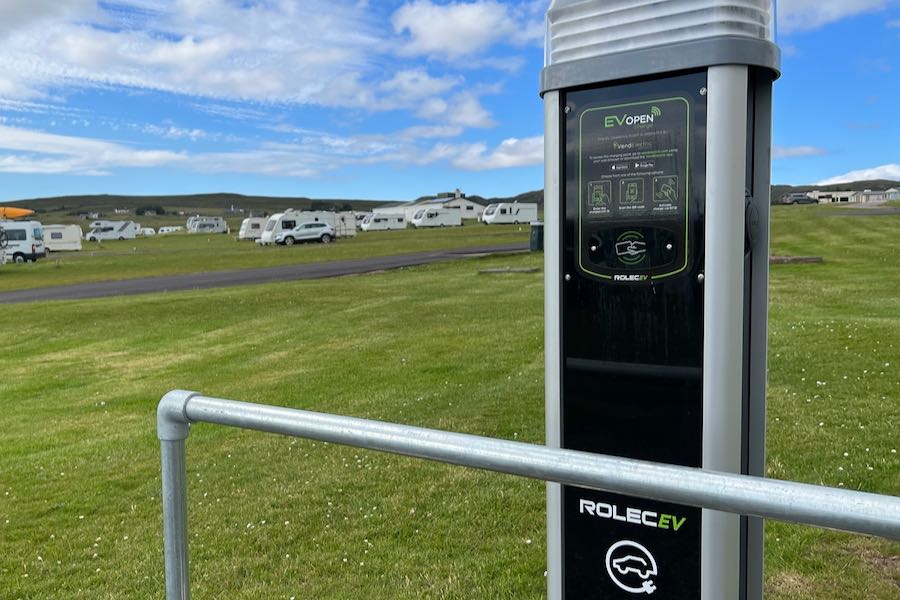
User Reviews
Select a car to read the user reviews
Influence of payload on stability
Weight distribution and noseweight are vital in obtaining a stable caravan. Distribute the payload in the caravan and the car and then find out the stability rating of your loading configuration.
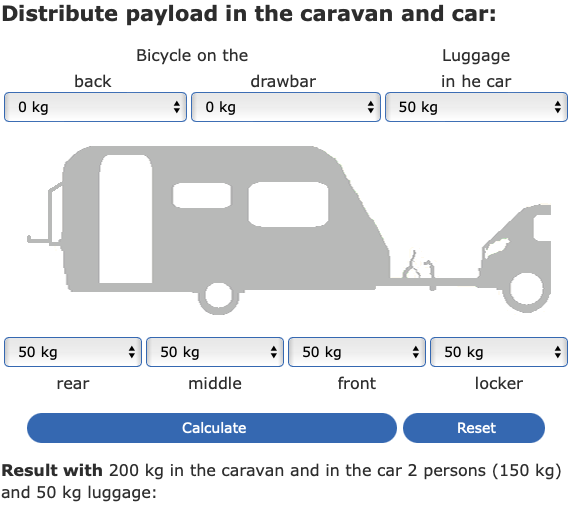
Towing limits
The towing limits of all cars and the advice on what weight you can safely tow.
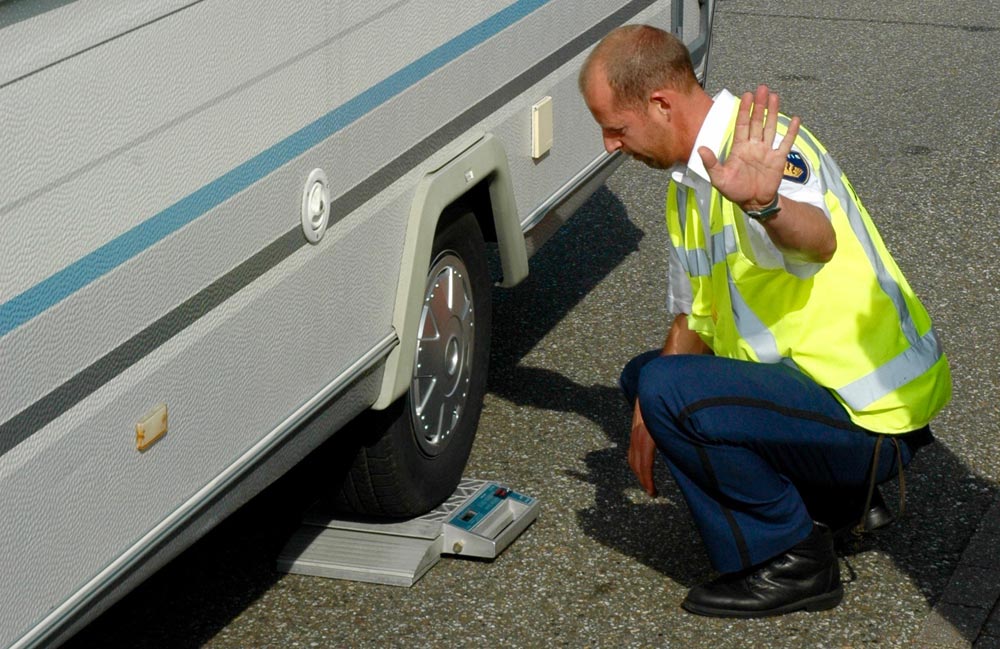
This website can only exist with your support.

California RV Route: Where to Stay and What to Do
Even though we spent 6 weeks in California, it wasn’t nearly enough time for this incredibly beautiful state. You will notice we missed some of the most popular destinations that California has to offer, such as Yosemite National Park, Lake Tahoe, Sequoia National Park, the Sierra Nevadas, etc. etc. We simply couldn’t do it all so we decided to focus on the coast this time. And now, we have lots of reasons to return next spring!
Our Destinations
We divided up the cities we visted by Southern and Northern. You can click the destination to be taken straight to that section of the post.
Southern California
Northern California
WHERE WE STAYED AND WHAT WE DID
joshua tree national park – twentynine palms, ca.
We found this free BLM boondocking site 15 minutes south of the Cottonwood Campground Visitor Center. We discovered the spot through Campendium . We were visiting Joshua Tree National Park during Coachella, which meant that all the campgrounds inside the park were booked well in advance. We have a suspicion that camping inside the park would be pretty awesome, but we also loved that the BLM spot was free, had lots of privacy and therefore plenty of space to ourselves.
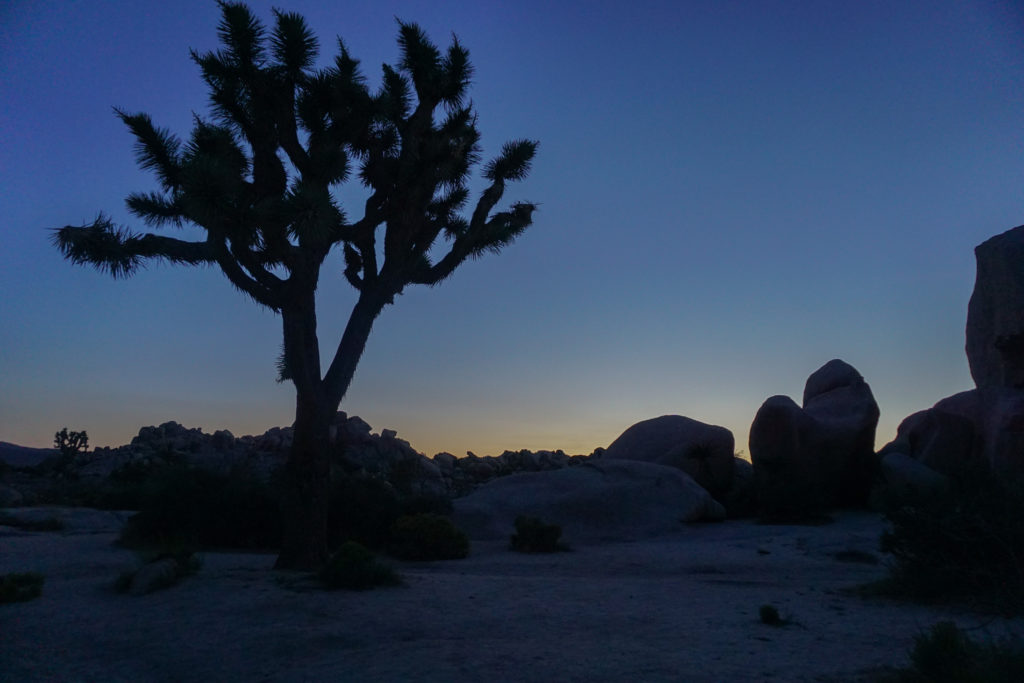
The downfall though, was that it was about an hour drive to get to the most popular parts of the national park, because of the windy roads that slow you down. The drive is beautiful and if you just want to spend one day inside the park, then this boondocking spot is perfect. But if you’re wanting to spend a few days enjoying the various hikes that Joshua Tree N.P. has to offer, you’re probably better off paying to camp inside. Either way, you don’t want to miss the unique beauty of this national park.

Doheny State Beach – Dana Point, CA
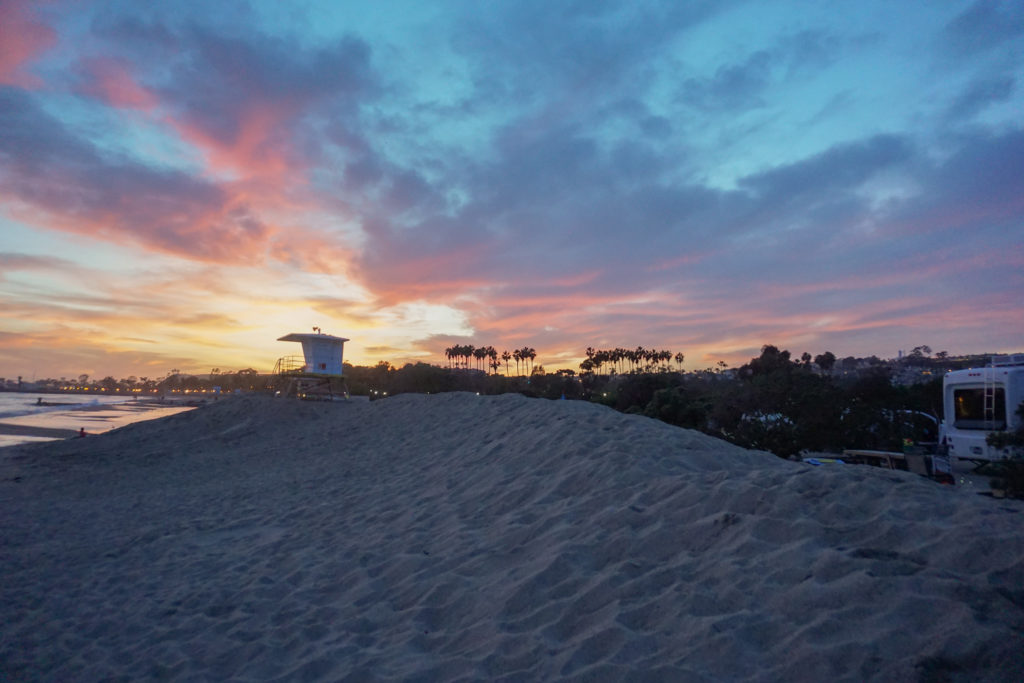
We really enjoyed our stay at Doheny State Beach because of it’s proximity to the beach. We were steps away, but they even have some spots that back right up to the beach. Many of California’s state beaches require reservations about 7 months in advance in order to get a spot on the weekends. Since we are fine staying during weekdays, we were able to get a reservation here with only a few weeks notice.
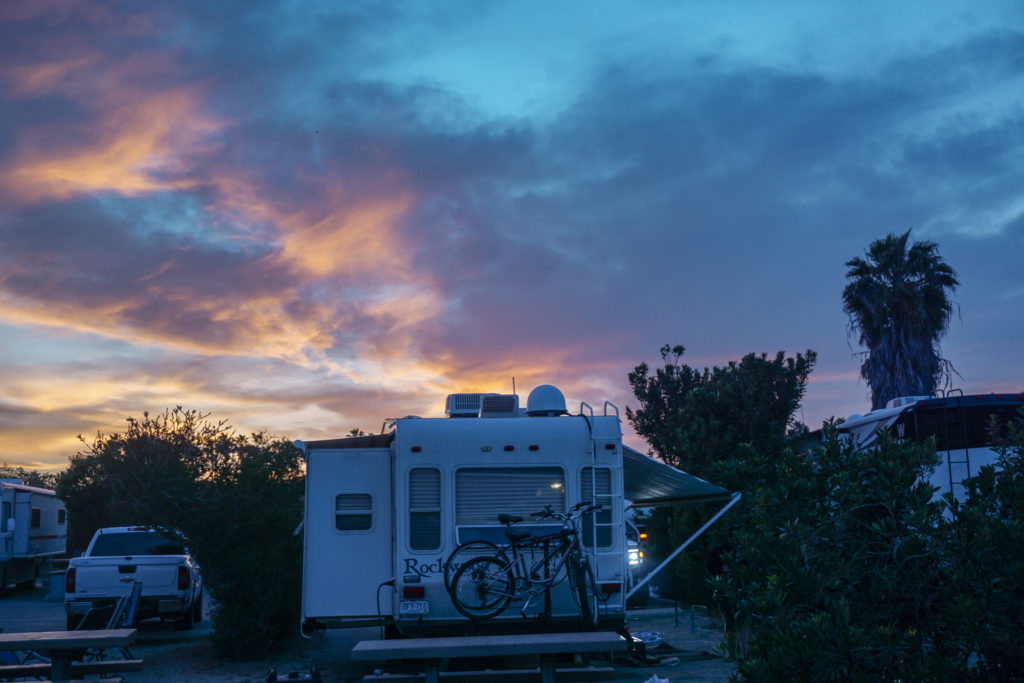
Doheny, unlike many other California state beaches, has no hookups at all. The park is also pretty strict with its generator rules (you can only use them between 10:00 am – 8:00 pm) and the facilities were below average. So this was a bit of a bummer for us. However, we loved the convenient location. We took day trips to both San Diego and Laguna Beach and also loved the Dana Point area. During the summer months, especially, this would be a great spot because of the beach activities and water sports you could enjoy just steps from your campsite.
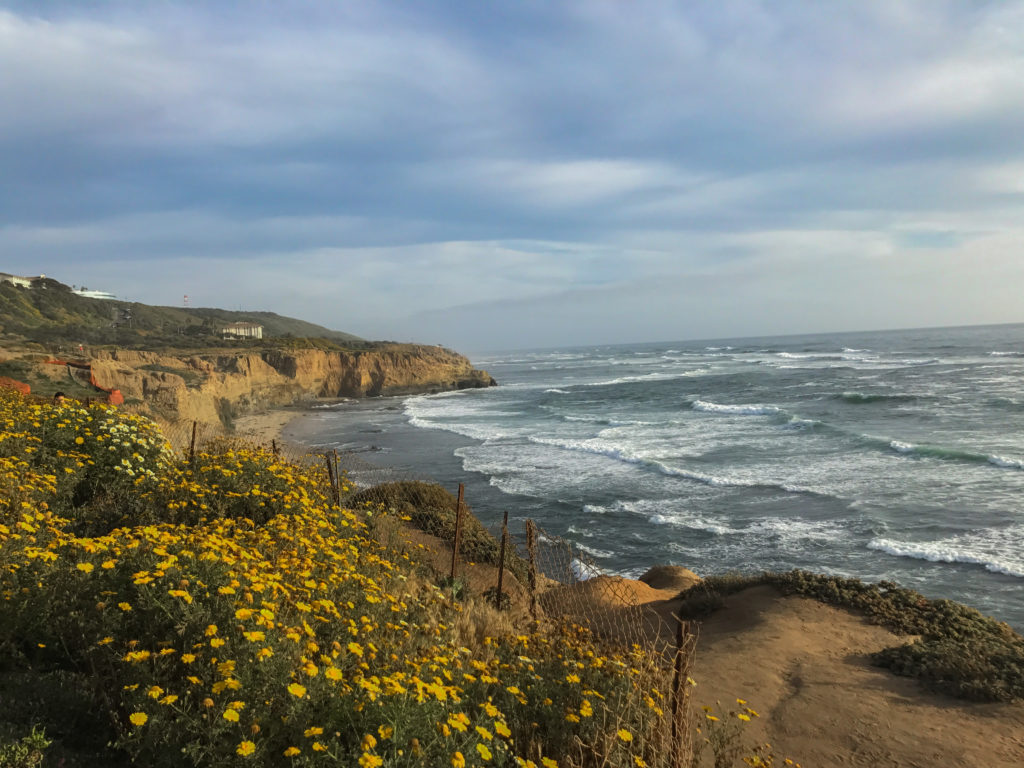
During the summer months, especially, Doheny State Beach would be a great spot because of the beach activities and water sports you could enjoy just steps from your campsite.
Golden Shore RV Park – Long Beach, CA
I t’s location in the heart of a bustling downtown, yet walking distance from the beach made Golden Shore RV park pretty special. We also loved its amenities that were really well maintained and the added safety that the gate offered made us want to stay another week. The park is rather small, but we enjoyed lounging at the pool, walking to the marina during sunset, and the combination of city and beach views that this area had. Rosie’s Dog Beach was another benefit for our family since most beaches aren’t pet-friendly.
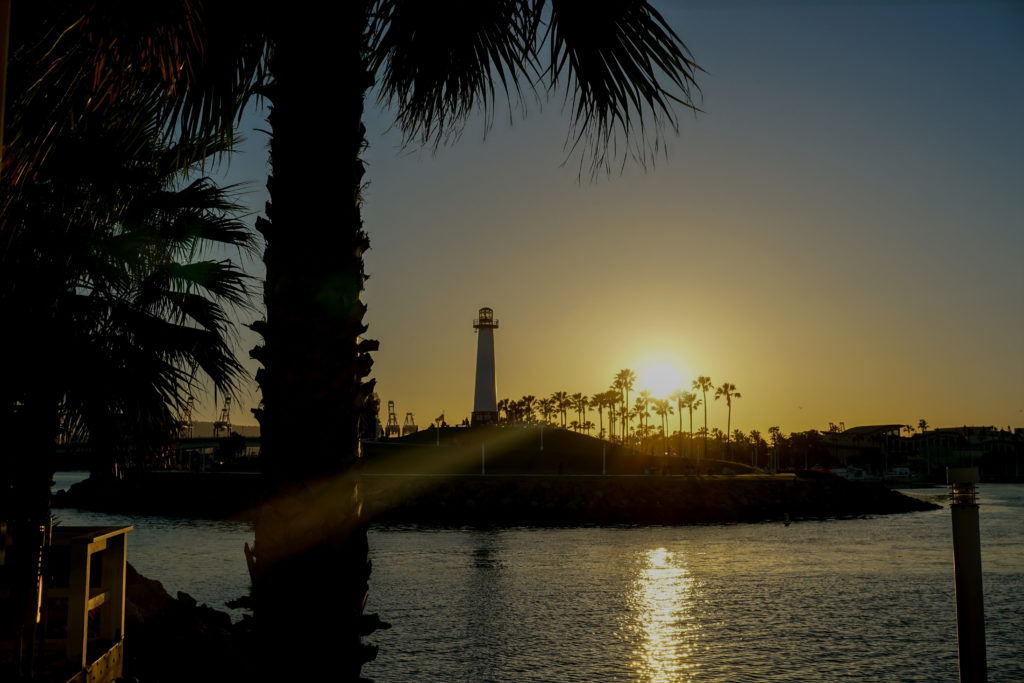
Long Beach is also great because of it’s neighboring beaches. We spent a day at Hermosa Beach, which was only a 30-minute drive, but would have also liked to have driven to nearby Newport Beach and Huntington Beach. Golden Shore is also only 25 miles from Disneyland!! If you’re looking for a beach town that has a little more action – nice restaurants, great shopping, hip bar scene, etc – then Long Beach is a great option. Another fun activity is walking along the Naples canals while checking out the beautiful homes and boats.
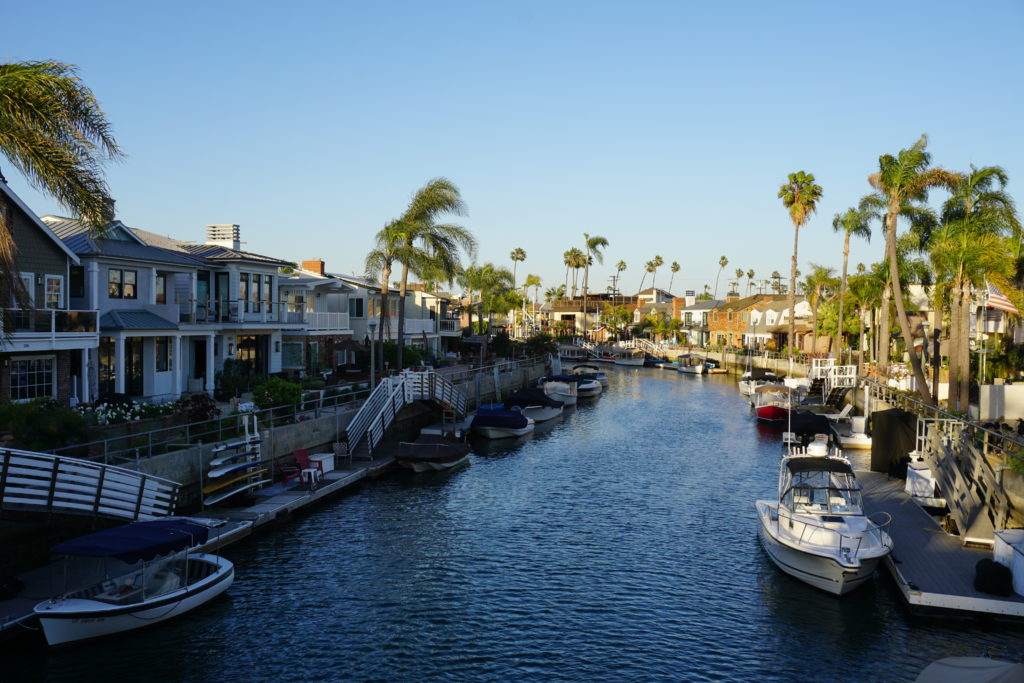
Dockweiler RV Park – Playa Del Rey, CA
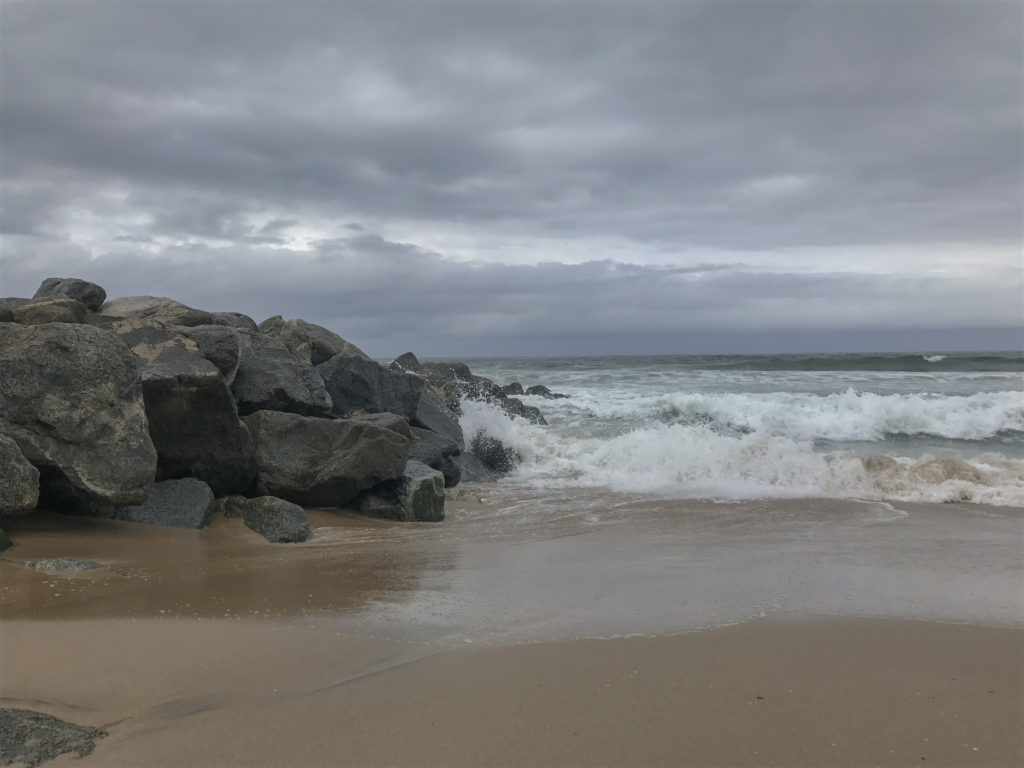
If you’re looking for places to park your RV close to Los Angeles, you’ll notice there’s not a lot of options. Dockweiler is basically just a parking lot on L.A.’s least desirable (but bonfire-friendly!) beach. It’s minutes from LAX, which is both convenient and very loud since planes fly over every few minutes. However, you ARE steps from the beach and less than 10 miles away from L.A.s best beaches (Manhatten, Hermosa, Venice, and Santa Monica). Plus, you can enjoy all that L.A. itself has to offer – Hollywood, Beverly Hills, world-class dining, shopping, etc.! This could also be a great place to stay while visiting Disneyland and Universal Studios since both are less than an hour drive away (depending on traffic, of course!). We think Dockweiler would be a great group camping location. It would be an awesome place to enjoy partying with friends at the beach all day while having the convenience of full hook-ups and tons of nearby activities!
Malibu Beach RV Park – Malibu, CA
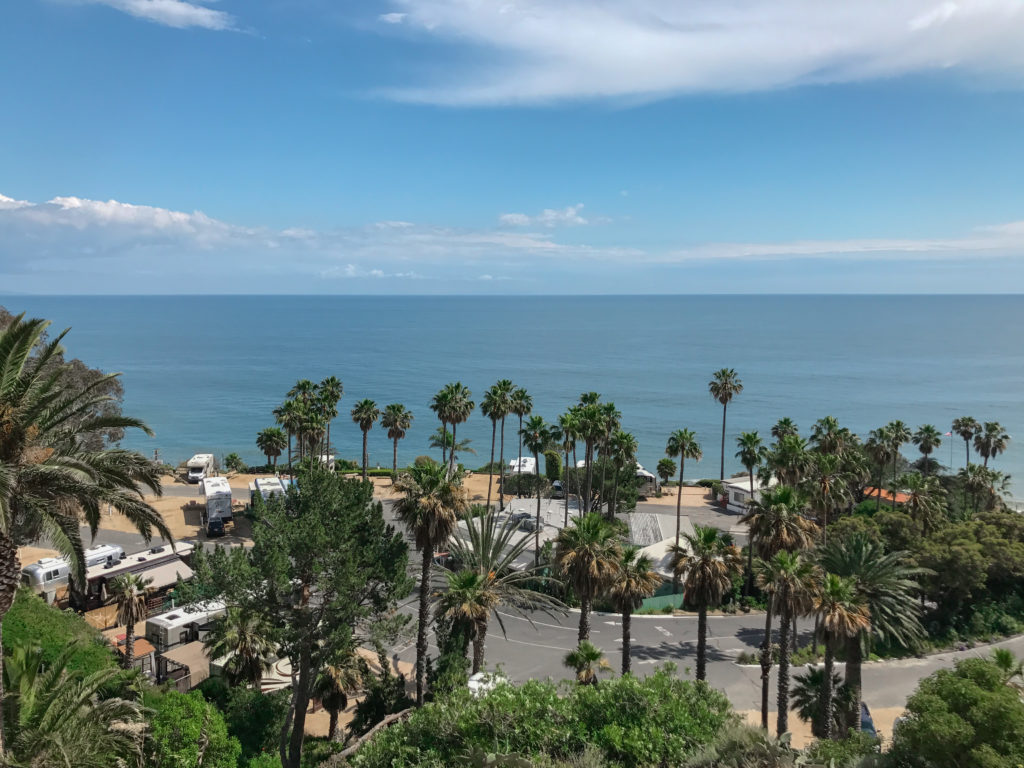
If yo u like both ocean and mountain views from your RV window, awesome nearby hiking, great restaurants, very nice bathrooms, and an overall peaceful atmosphere then you’ll love Malibu Beach RV Park as much as we did. After a few weeks in busy, crowded beach towns and therefore navigating crazy California roads, Malibu as a whole was a wonderful place for us to slow down and relax for a week.
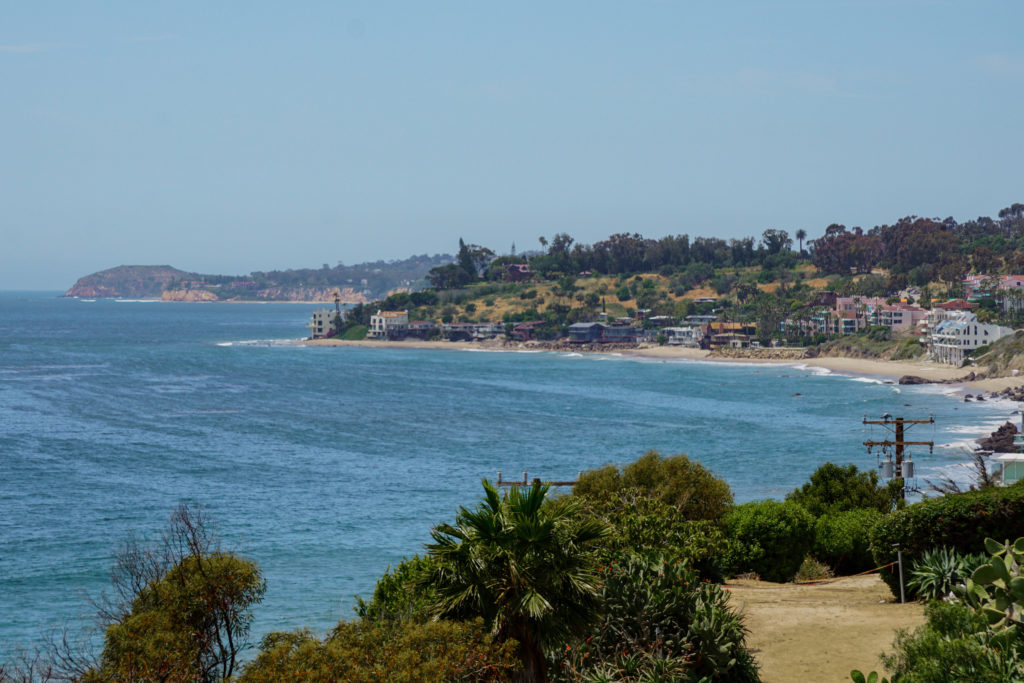
Nearly every site at Malibu Beach RV Park has a view of the ocean, but we would highly recommend paying the extra money for the best ocean view spots. In an effort to lower costs, we opted for a mountain view spot with only partial hookups. However, we lucked out with a spot that was only 1 row back from the best ocean views, for most of our stay had no RV in front of us to block the view, and were right next to the lovely bathrooms which made our stay absolutely perfect despite only having partial hookups. It also didn’t hurt that our neighbors were friendly and we spent most nights by the campfire (propane fires are all that’s allowed, by the way) with them.
We honestly would’ve been completely content just staying at the RV park all day. There were a few spots in the park with picnic tables near the edge of the cliff that the park sits on. These spots were surrounded by beautiful plants and flowers and offered 180-degree views of the ocean on one side and lush green mountains on the other. We spent our mornings, afternoons, and evenings at these spots while enjoying coffee, sunset dinners, and just quiet moments of meditation. A couple days we even saw whales and dolphins in the water! There was even plenty of spaces for the dogs to roam while we soaked up the beauty.
During our time at Malibu Beach RV Park, we were pleasantly surprised by how many FREE activities we found! Read about them in this post: 5 Free Things to do in Malibu, California.
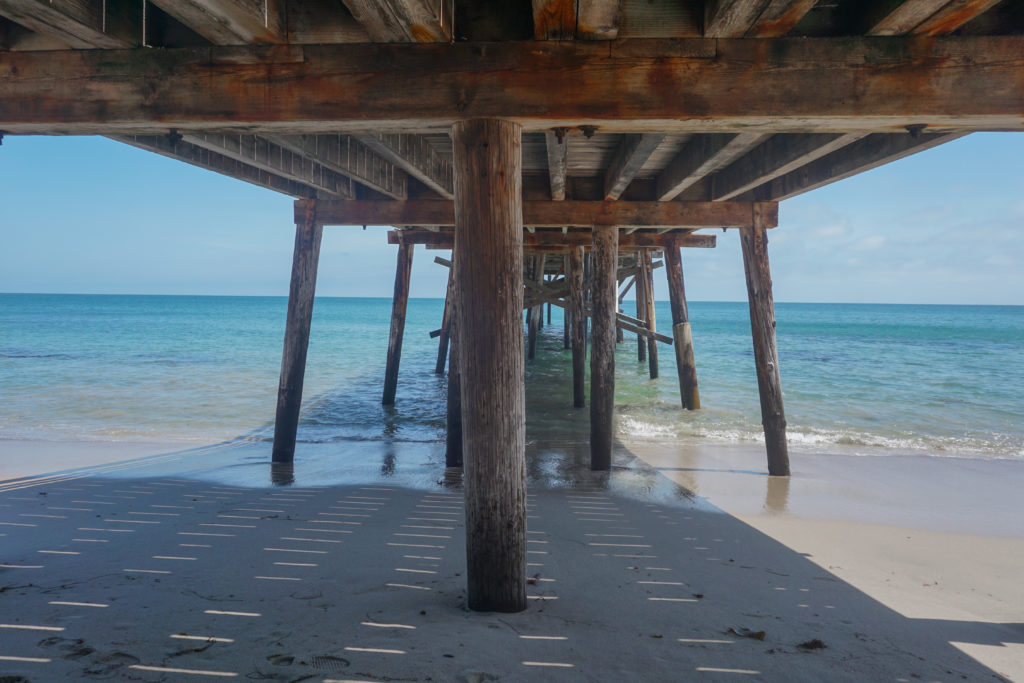
We also made sure to never miss a sunset and even though they can be enjoyed right from the RV park, we al so enjoyed viewing them from Point Dume, Leo Carrillo beach, and the Malibu pier. One night we even drove into Santa Monica to experience its famous pier and have dinner with friends who live there.
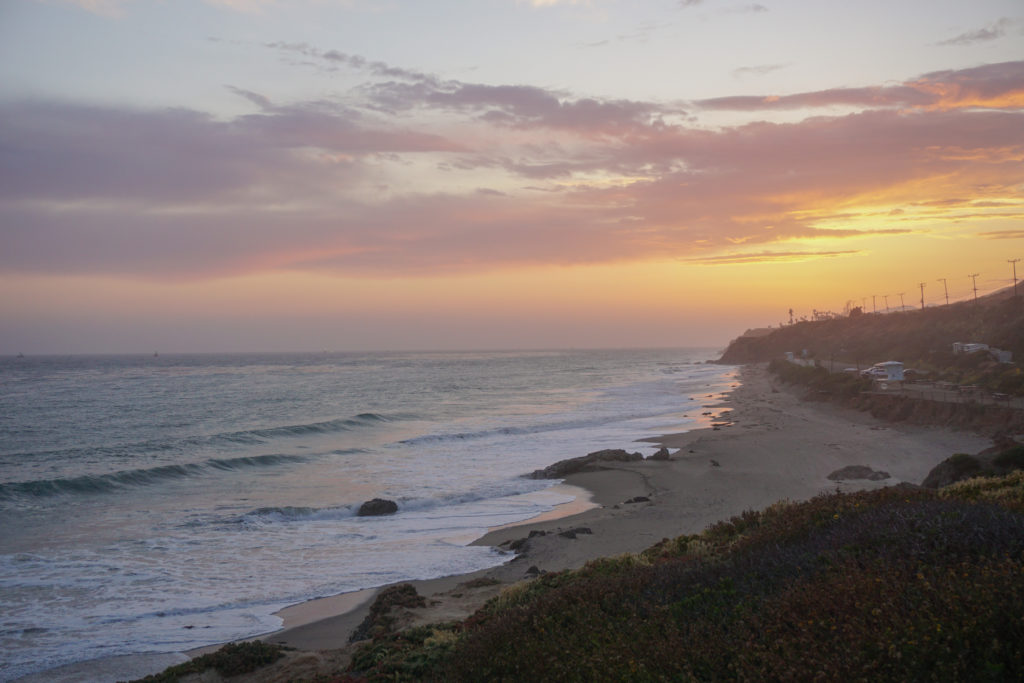
Flying Flags RV Park – Buellton, CA

We loved the modern and trendy twist that Flying Flags has put on their RV park. The fun starts immediately upon checking in. Attached to the registration office is a delicious cafe with a fun patio featuring a huge fire pit and cozy environment. Around the corner are its luxury pool and spa with lots of lounging areas and beautifully renovated bathrooms with showers. Aside from these great amenities, (and there’s even more – music stage, yard games, dog park, etc) Flying Flags has spacious RV spots but also cute cottages and even Airstreams for rent.
The best part about Flying Flags though is its beautiful location in Buellton, California. We had never even heard of this area but some friends recommended it to us and we are so glad they did!
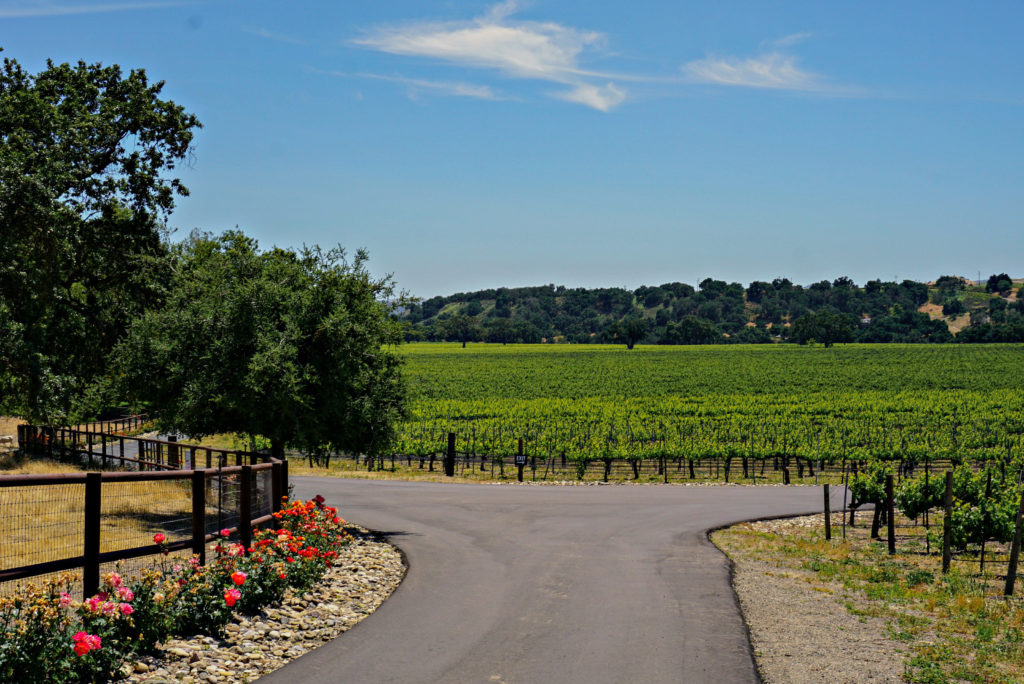
If you need convincing, read this post we wrote called 3 reasons to visit Buellton RIGHT NOW ! There are tons of wineries spread throughout the Santa Ynez Valley with breathtaking vineyard views. Solvang, a charming Danish village, is also nearby and a fun place to do more wine tasting, eat pastries, or just stroll the streets and enjoy the beautiful flowers and authentic Danish culture.
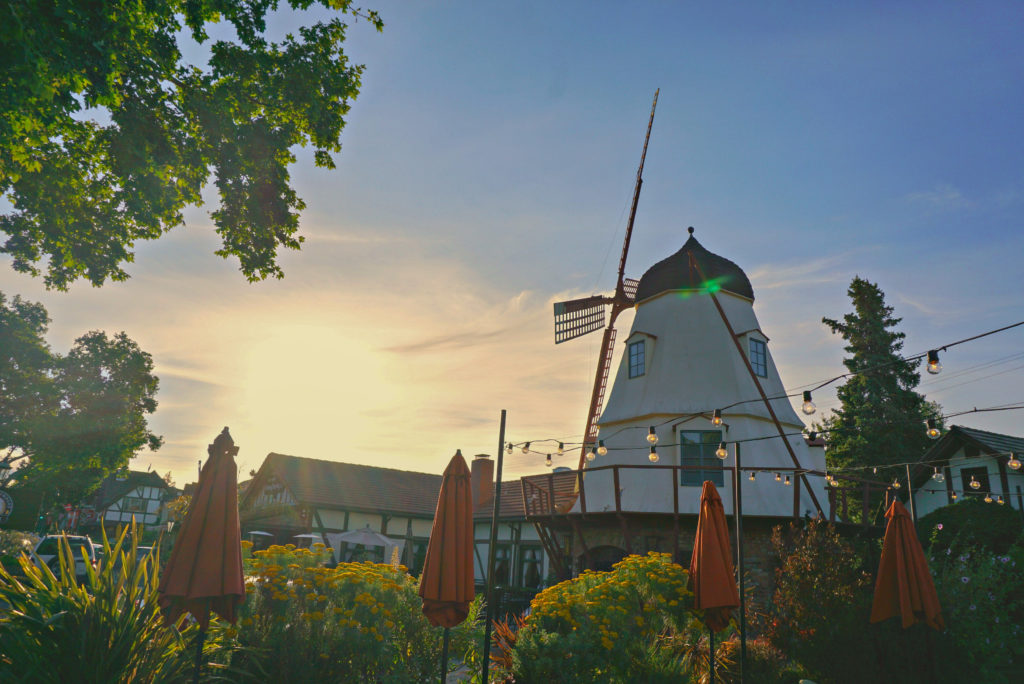
Buellton is also close enough to take a day trip to Santa Barbara. The beautiful drive was worth the trip alone. We loved the fact that you don’t have to do much in Santa Barbara to have a great time. We simply walked along State Street and checked out all the cute restaurants and shops along the way, stopping for a margarita (of course) at a cute Mexican restaurant with a patio. We continued on and walked along Stearn’s Wharf and watched the fisherman in their boats below. The view of the beach lined with palm trees and backed by mountains is really a sight to see!

We finished the day strolling through the property of the County Courthouse. This may sound strange but it is actually one of the top tourist things to do in SB because it’s a Spanish Colonial Revival style building surrounded by pristine landscaping. There’s SO much more to enjoy in Santa Barbara but we were just grateful to have gotten a glimpse of it!

Oceano Dunes State Vehicular Recreation Area – Pismo Beach, CA

Parking right on the beach just steps from the ocean for $10 a night was a no-brainer for us! While there are other campgrounds in the area, if you truly want to experience Pismo Beach and its sand dunes, we would highly recommend boondocking in this spot !

When we arrived on Friday afternoon, we had plenty of options for parking where we could have ocean views from our doorstep. We enjoyed a quiet evening and a beautiful sunset.
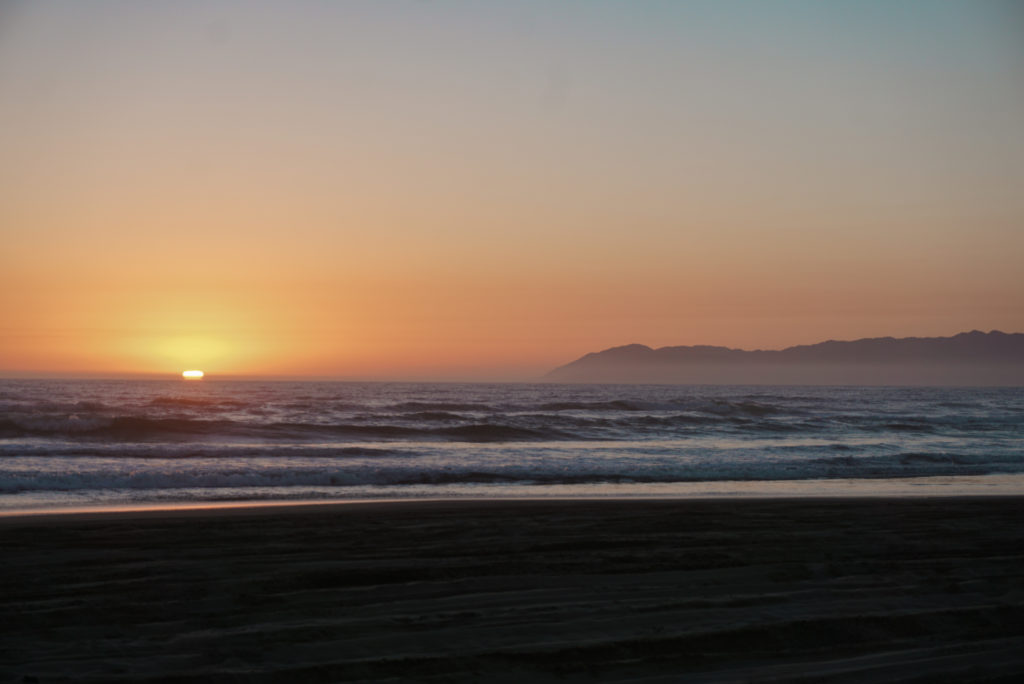
Well, that changed dramatically when we woke up Saturday morning. All the locals piled in wherever they could squeeze their campers and tents, blocking our view and nearly trapping us in. It seemed like everyone had multiple ATV’s and dirtbikes. So all day long, starting super early and ending way past dark, we listened to the humming sounds of them flying past our spot. When walking around the beach, you’d have to be careful not to get in their way. While we missed the peacefulness of Friday, we embraced the craziness and accepted that this was part of the experience. Being that Pismo is the only beach in California that allows this, we understood the craziness. We rented ATVs right on the beach and joined in on the fun!
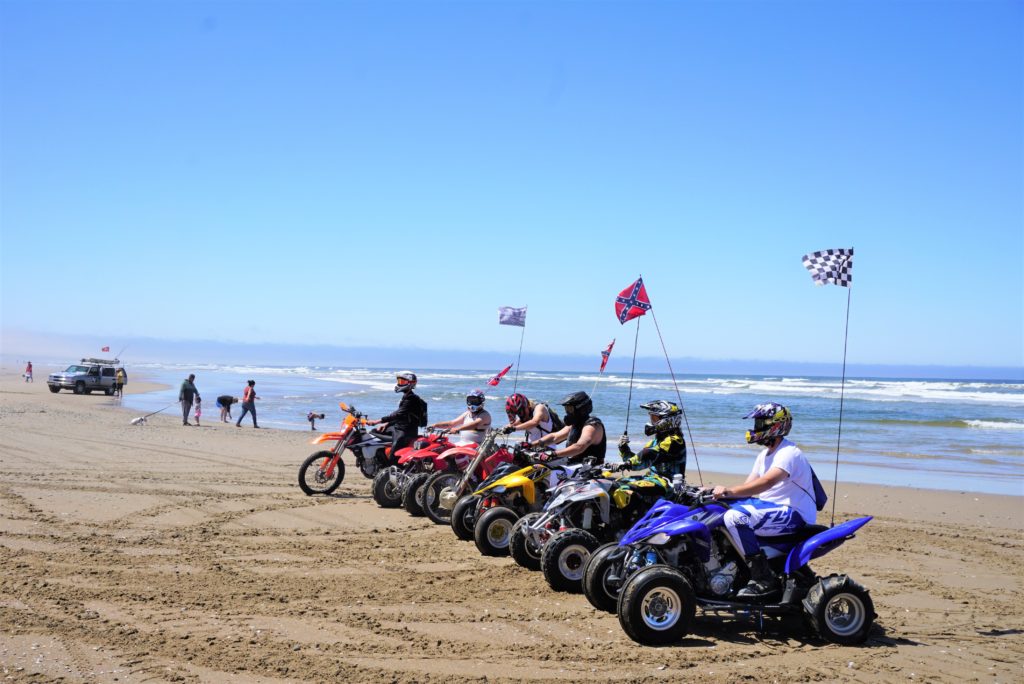
One of the tricky parts about RVing here is that in order to drive on the sand, you’ll need to air down your tires quite a bit (we took every tire on the truck and fifth wheel down to 20 psi). While this takes some time to do, we had no problem at all getting through the sand. We saw tons of people who didn’t air down (even large 4WD vehicles) get stuck, so don’t chance it. This also meant that once we parked, we stayed. We didn’t drive into town and explore because we didn’t want to keep airing up and down. But we were only there for the weekend so it was no problem.
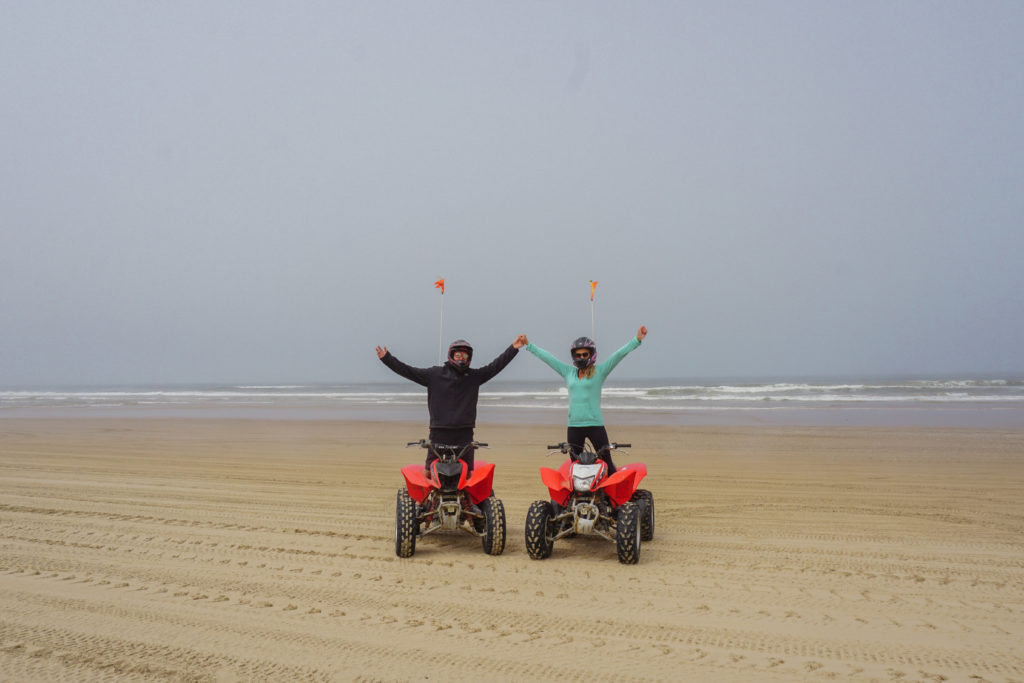
Wine Country RV Park – Paso Robles, CA
Paso Robles was another city we had never heard of in California. We were given the recommendation to go and were so glad we adjusted our route to make it possible. The Wine Country RV Park was the perfect spot to stay and many of the spots back up to the vineyards of EOS Winery, which is where we spent a few nights watching the sunset.
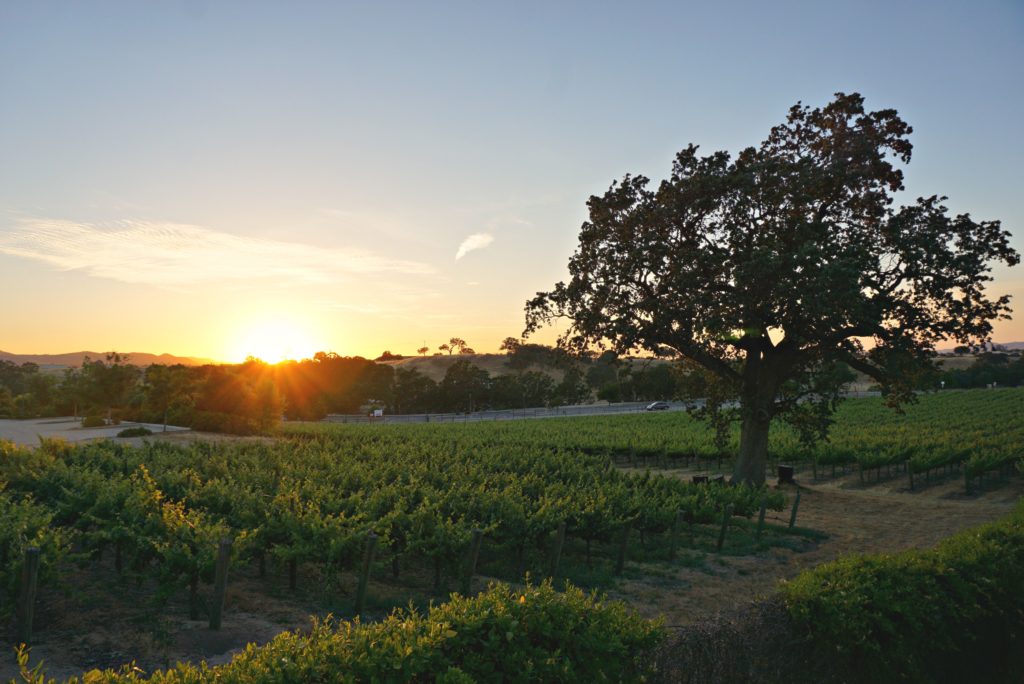
The park also has cottages to stay in and incredible amenities, like a pool, 2 spas (one with a firepit and waterfall feature!), an arcade, and an event room. Wine Country RV Park was also in the perfect location for exploring some of the 200 plus wineries that Paso Robles has.
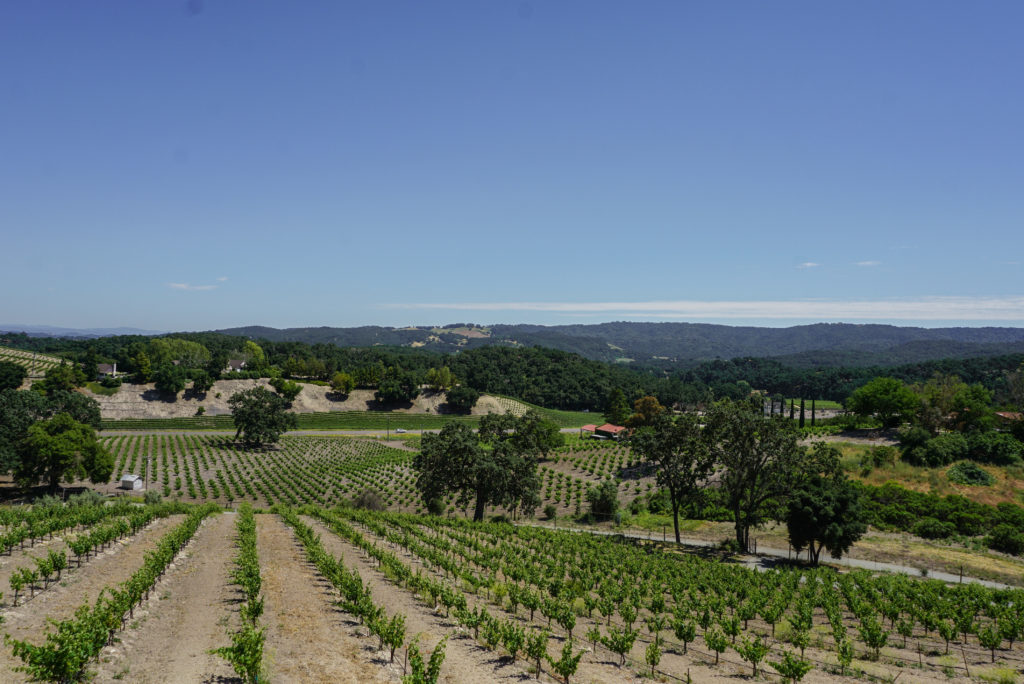
That being said, you won’t be surprised to hear that wine touring and tasting is the number one activity to do here. Read more about the activities we did and suggest in this post, Paso Robles: The Perfect Weekend Getaway . In the article , we give suggestions for wineries to visit, a winery tour that drives you around, a hot springs spa, and other great local activity suggestions.
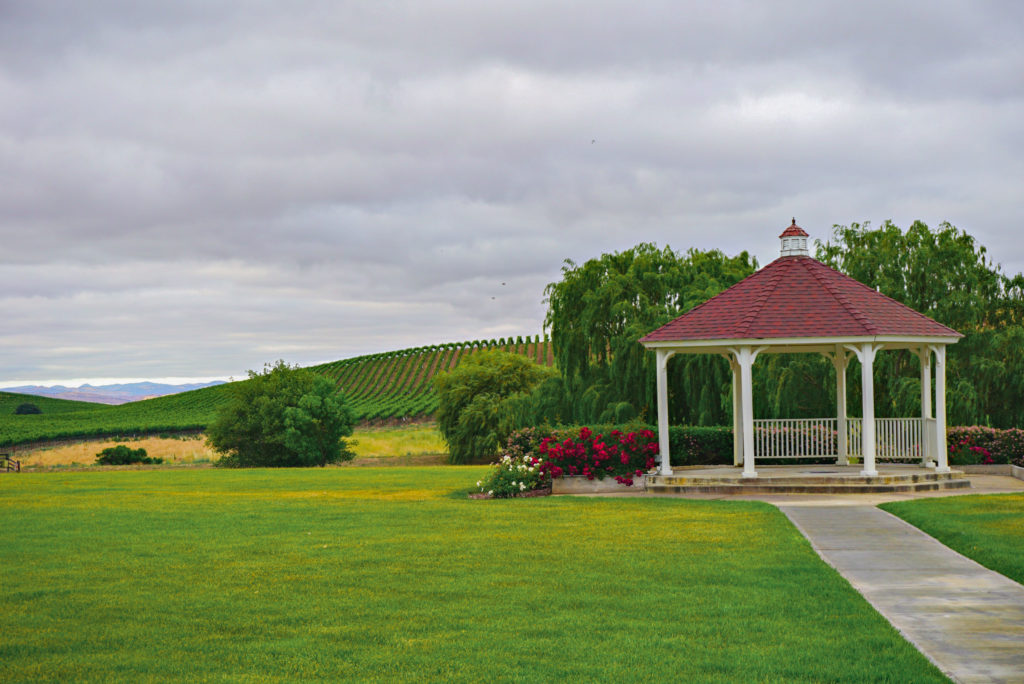
Monterey & Carmel by the Sea, CA

We can’t give suggestions on where to stay because we actually got lucky and parked our RV in front of Dan’s friend’s parents house in Carmel by the Sea. There is an RV park called Carmel by the River RV Park , but it was Memorial Day weekend so everything was booked well in advance, and we were happier to stay with friends anyhow.
As for the area, we were just there for the weekend but explored as much as we could. We started in downtown Monterey, checked out Fishermans Wharf. and continued on through Cannery Row all the way to Lover’s Point. We wished we could have sat in the park or at the beach in Lover’s Point all day. You can eat at the cafe, have a picnic in the grass, climb out along the rocks to watch the seals and various boats, lay on the beach, etc. It’s such a lovely little area!
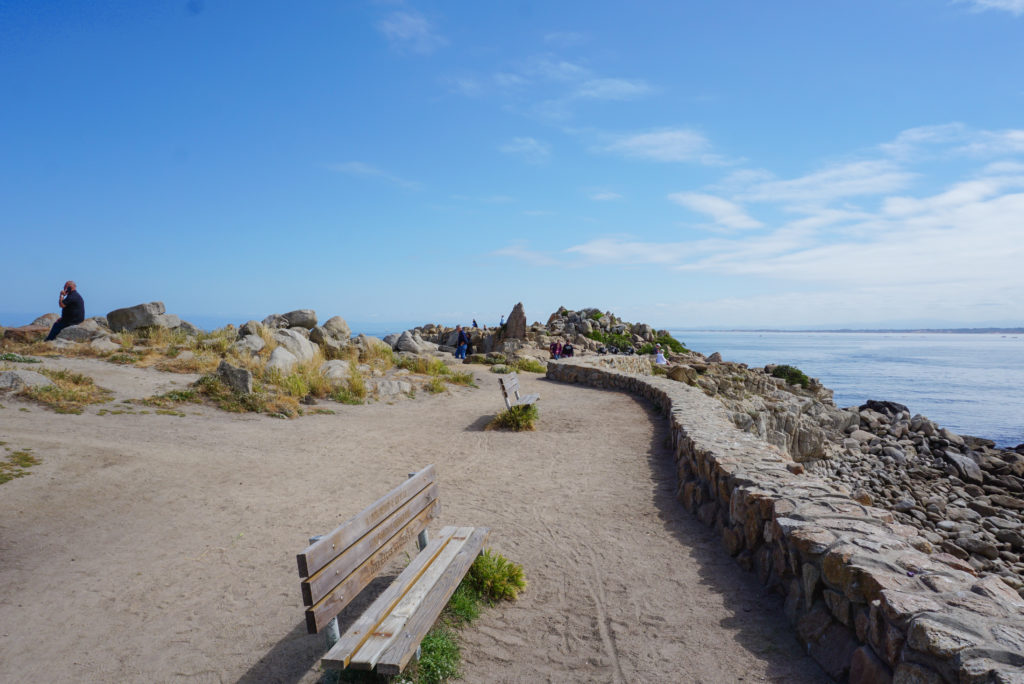
We then drove south on the Pacific Coast Highway all the way down to Big Sur. Since the massive landslide had just recently occurred, we considered playing it safe and avoiding the area but are glad we didn’t. There is still SO much beauty along the coast north of Big Sur to enjoy! The Bixby Bridge was even more beautiful in real life and provided one of the most incredible views we’ve ever seen. The drive along that portion of the PCH had been a dream of ours and it exceeded our expectations.
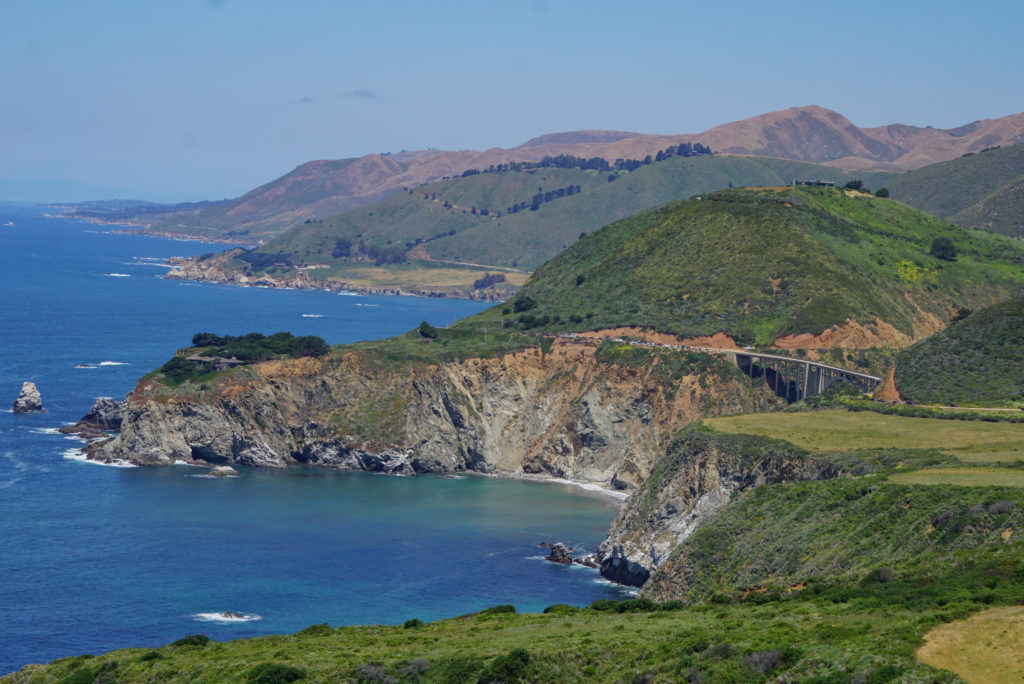
We ended the day at the Big Sur River Inn Restaurant , which we thought would be a quick “pit stop” to stretch and use the restrooms. Turns out the restaurant sits along the river and has an adorable patio. The restaurant also has a taco and beer stand for people like us who like to sit in the grass under the tree with our dogs while enjoying a quick bite, cold beer, and river views.
Park Delta Bay – Isleton, CA
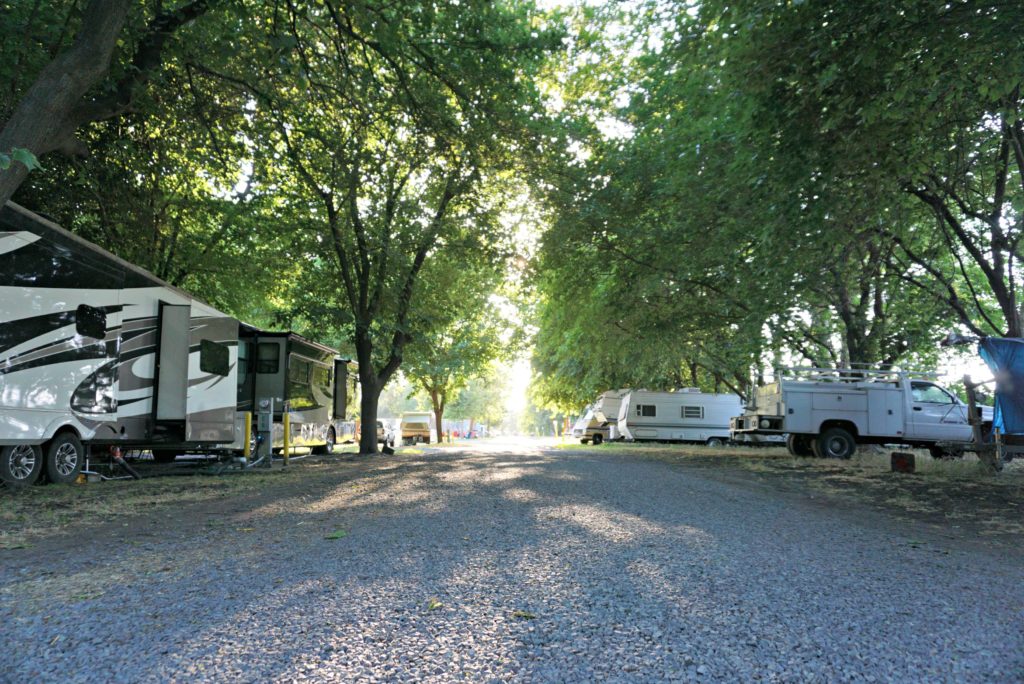
We were personally invited by the park to come for a stay, so we gladly accepted. While this area wasn’t originally on our radar, it was a nice place to unwind from our 5 weeks of continuous fast pace travel throughout Southern California. Park Delta Bay also turned out to be a perfect home base for exploring the bay area. We were nervous about driving our fifth wheel through the crazy city traffic in order to explore San Francisco, so taking a day trip was much more pleasant for us.

During our stay at Park Delta Bay, we had time to catch our breath, connect a little more with the community, and enjoy peaceful mornings under the shady trees and sunset walks along the water. The park has great amenities, is well-kept, continuously improving, and would be a great spot for family camping trips. The spots are spacious and incorporate nature much more than other RV parks we’ve stayed at, which we liked. Across the street are a general store and a marina where you can hang out on the dock.
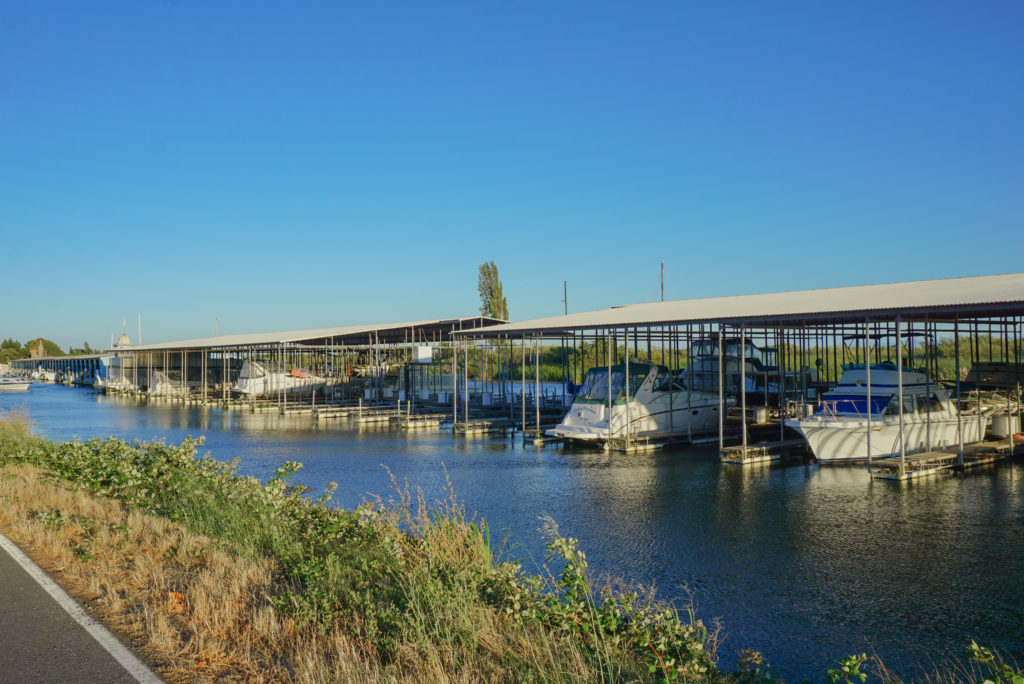
Down the street is a fun locals bar called the Lighthouse where we enjoyed a luau themed karaoke party!
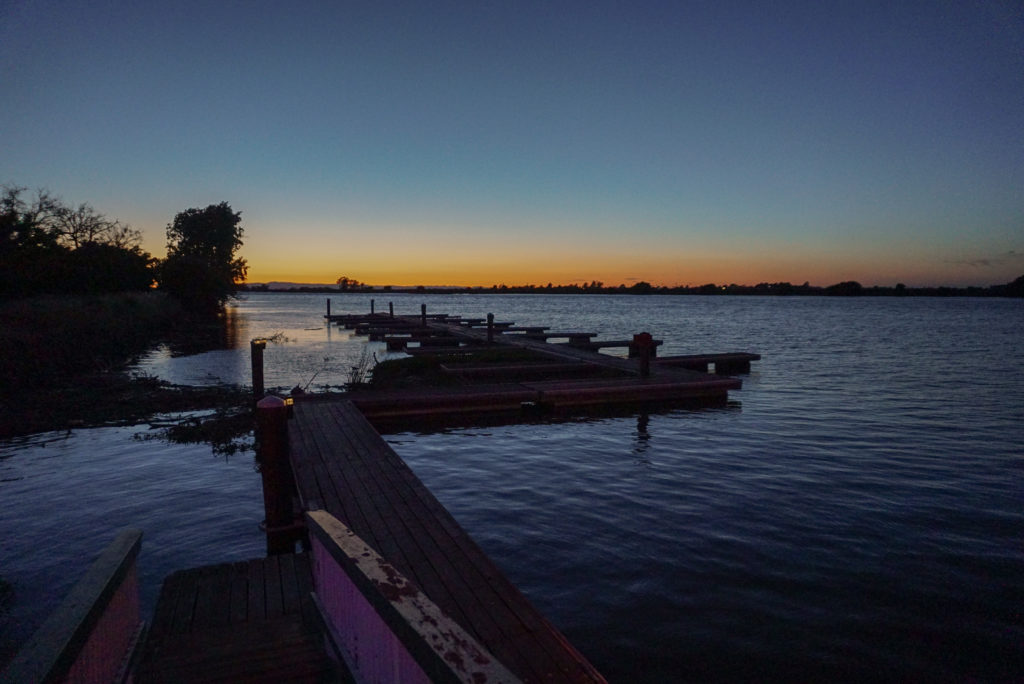
Isleton has a quaint, small-town, old-fashioned feel about it that we genuinely enjoyed. The area is called the California Delta and is formed by the merging of the Sacramento and San Joaquin rivers, which means there is also plenty of water activities to enjoy.
Calistoga RV Park – Calistoga, CA
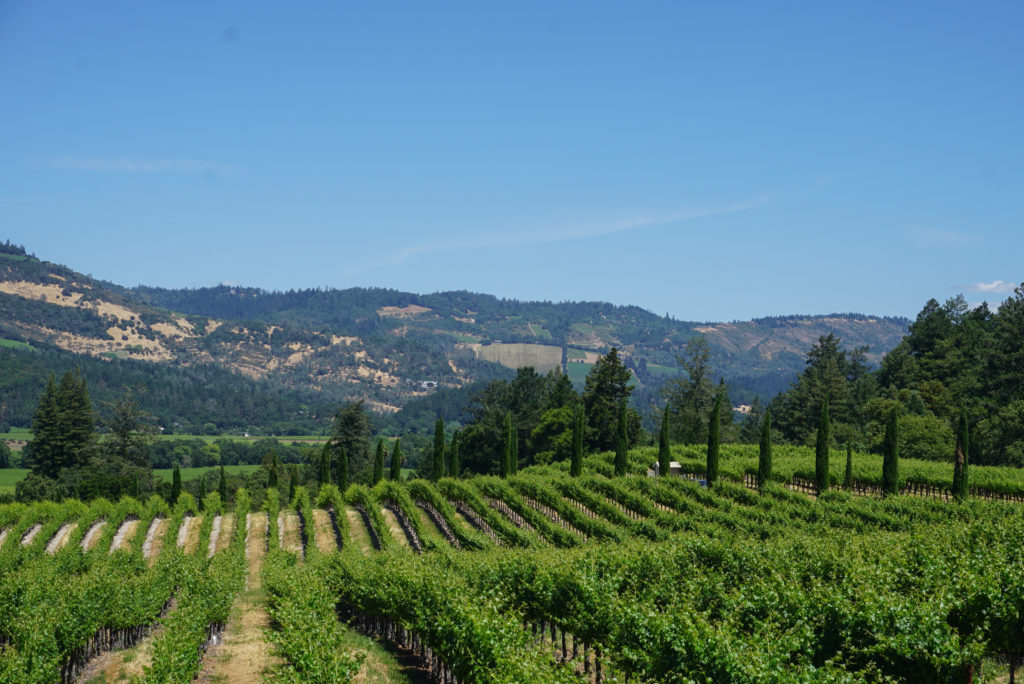
There have been very few stops along our route that we’ve said to ourselves, “we could live here” and Calistoga was one of those places. Everyone has heard about Napa Valley, but we were so surprised that Calistoga has been kept a secret. It’s only a 30-minute drive from Napa but offers all the same beauty and great wine but in a more quaint, charming, laid-back town. We loved having our “home-base” here and riding our bikes 5 minutes to downtown, eating ice cream (the Calistoga Creamery had some of the best ice cream we’ve ever had!), grabbing drinks, and just witnessing the adorable close-knit community. But then we could also hop in the car, enjoy a 30-minute scenic drive and be in the famous, upscale, and world-class city of Napa. It was the best of both worlds.
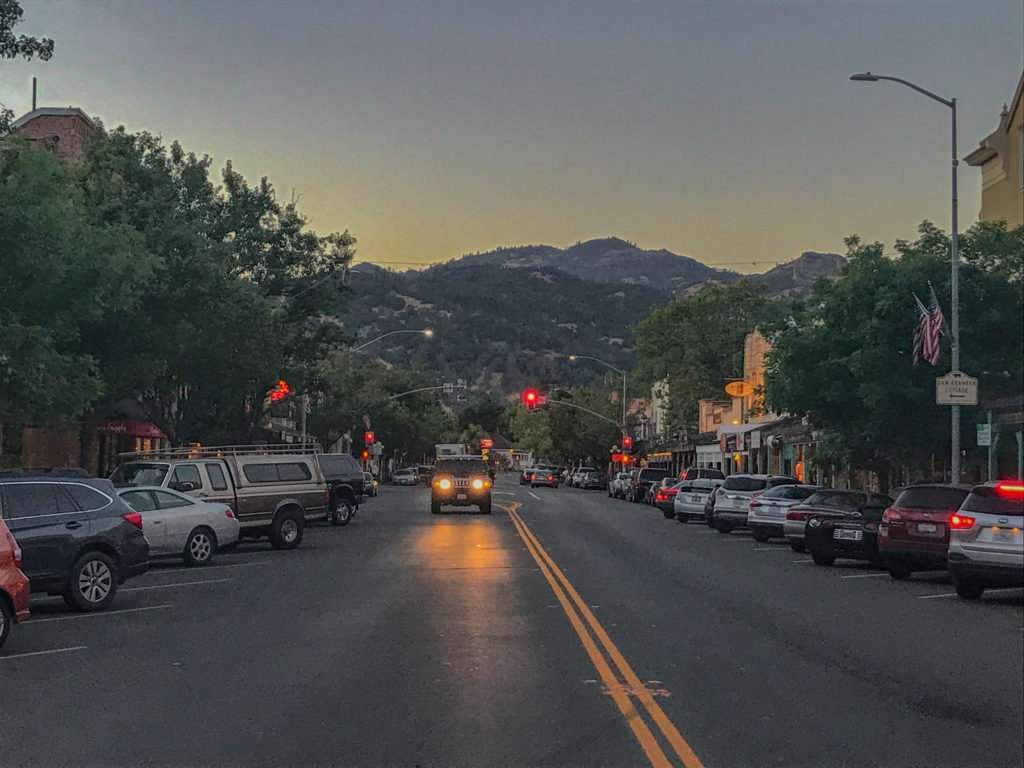
Calistoga RV Park itself isn’t anything too special, but it’s in a perfect location, had a very friendly staff, shaded spots, and all the amenities you need. It feels more like a campground with its gravel road and natural landscape, but it was perfectly fine for our stay and cost-effective since they accept the Passport America discount .
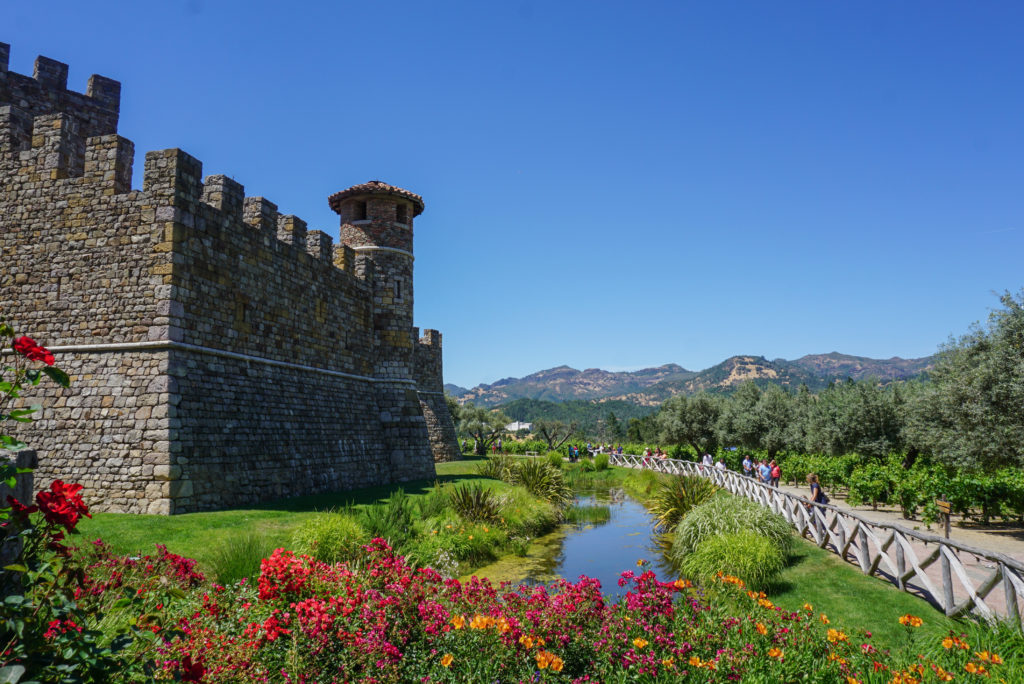
If you’re in Calistoga, do not miss the Castello di Amorosa . It is absolutely stunning in every way, as you can see from the photo! When we said we wanted to live in Calistoga, we really meant we wanted to live in the castle!
Klamath River RV Park – Klamath, CA
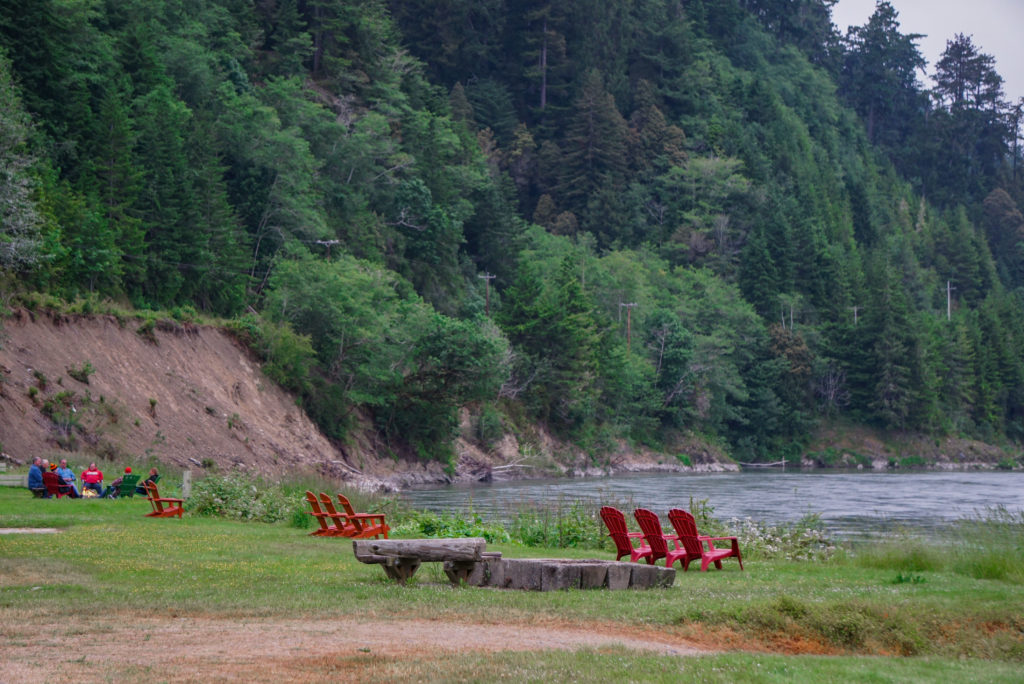
The Klamath River RV Park really is “right on the river” as it advertises. But it’s more than just that! The river view is spectacular and its beauty seems to change based on the time of day.
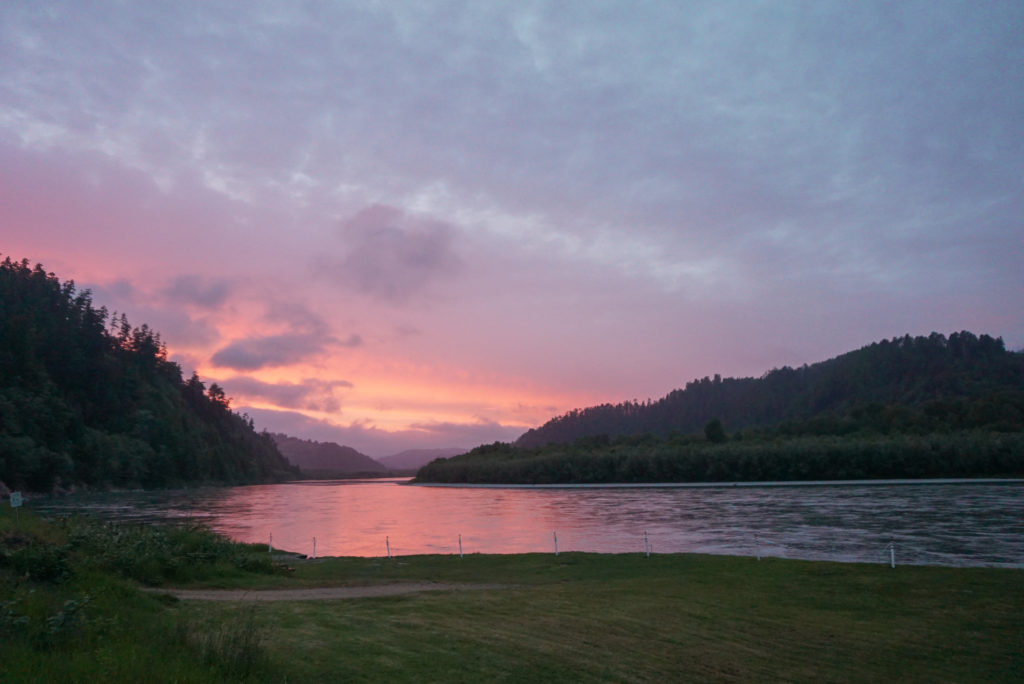
The park is also 9 miles from the Prairie Creek Redwoods State Park Visitor Center and 30 miles to Jedediah Smith Redwoods State Park , two of the best parks for hiking and enjoying the redwood trees! Not the mention, the drive from Klamath to Jedediah Smith was one of the most scenic drives we’ve ever taken because you go from views of the coast one minute to tunnels of towering redwood trees the next.
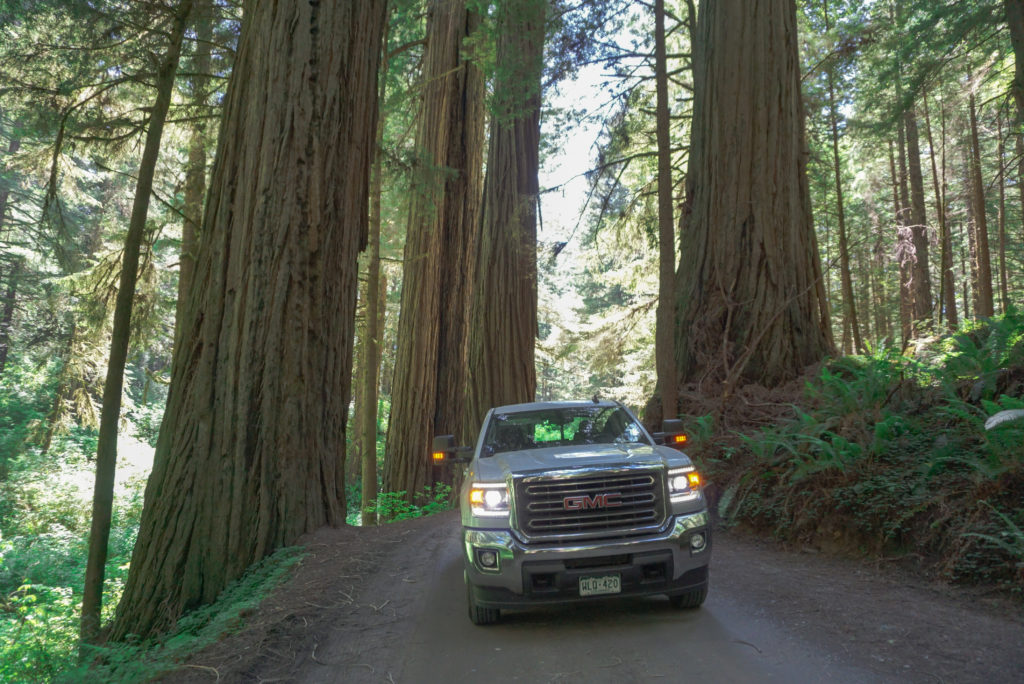
We LOVED hiking Fern Canyon in Prairie Creek! It was one of our all time favorite hikes because of its unique and magical beauty. Along the drive to Fern Canyon, you can also stop to check out Gold Bluffs Beach and you’ll see plenty of elk too!
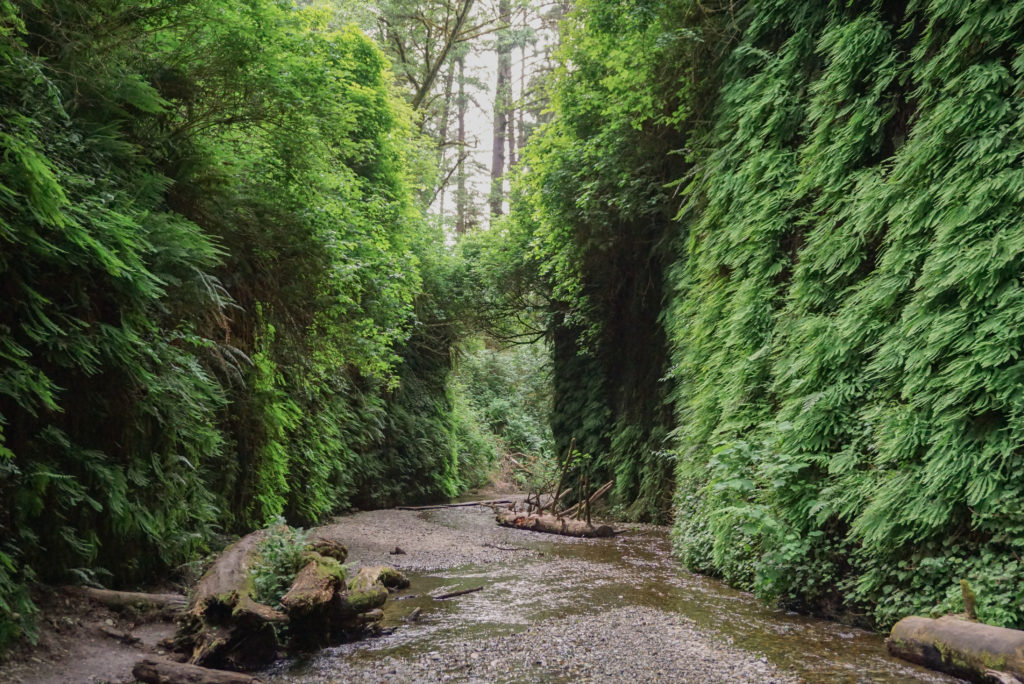
We drove on Howland Hill Road to Stout Grove in Jedediah Smith State Park and enjoyed a short hike through the redwoods. We even got to stand inside a hollowed out redwood tree! Even though it’s a short hike, if you’re anything like us, it will take you much longer because you’ll be stopping to soak in the beauty and take hundreds of photos of these giant wonders!
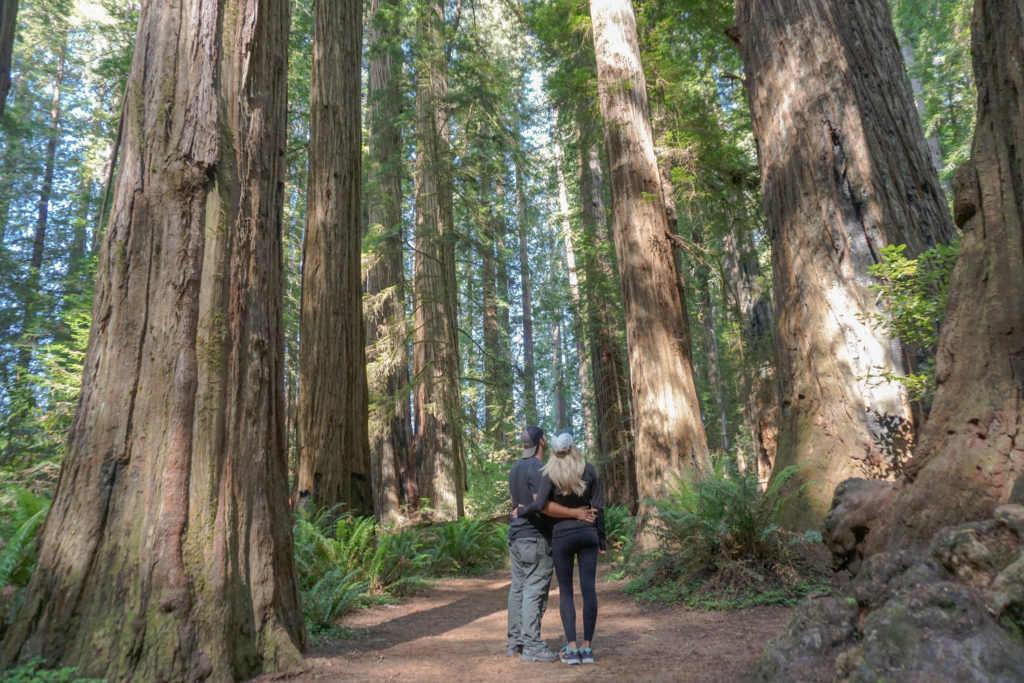
Also nearby are some awesome beaches. Klamath Beach, Wilson Creek Beach, and Crescent Beach were some of the most beautiful beach experiences we’ve ever had. Wilson Creek Beach and Crescent Beach can be a quick stop along Hwy 101 on your way to Jedediah Smith State Park, but you’ll want to stay all day because they are so gorgeous and peaceful. Klamath Beach is best for sunset and very close to the RV park. You can watch the sea lions fishing near the rocks right off the beach, which was one of our favorite moments of our RV travels so far.
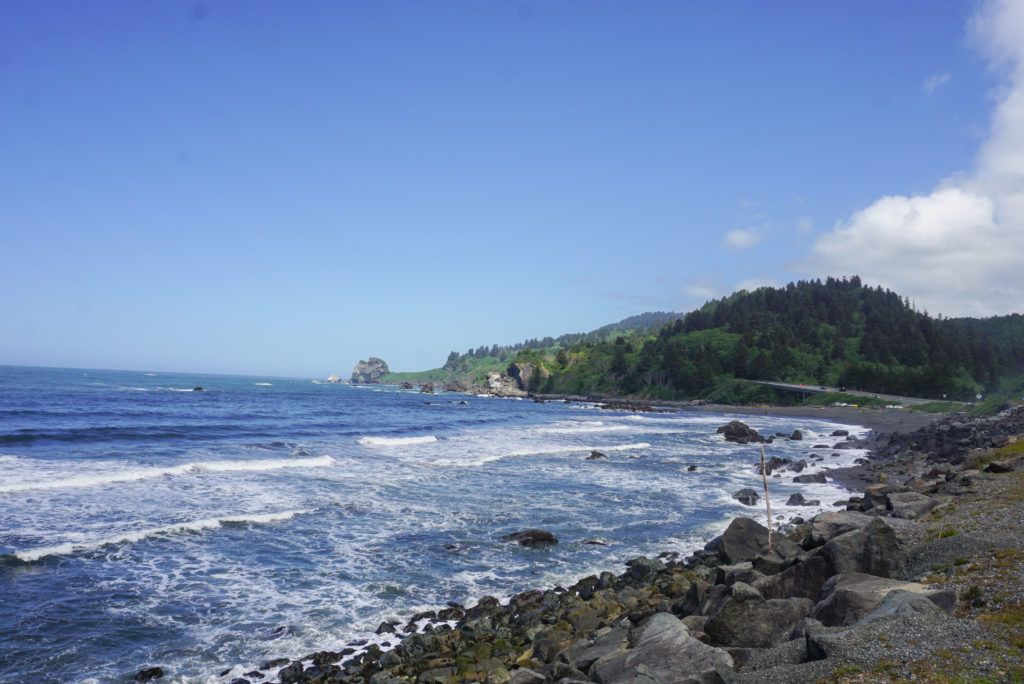
Another great spot in the area is the Klamath Overlook. The scenic drive along Requa Road to get to the overlook is a popular tourist activity as well. From this spot, you’ll be able to see where the Klamath River meets the Pacific Ocean and you may get lucky like us and spot some whales and bald eagles too! Surprisingly enough, this was also one of the best spots to get good cell service in the whole area! We spent an entire day up there working because it was tricky to find good wifi in Klamath.
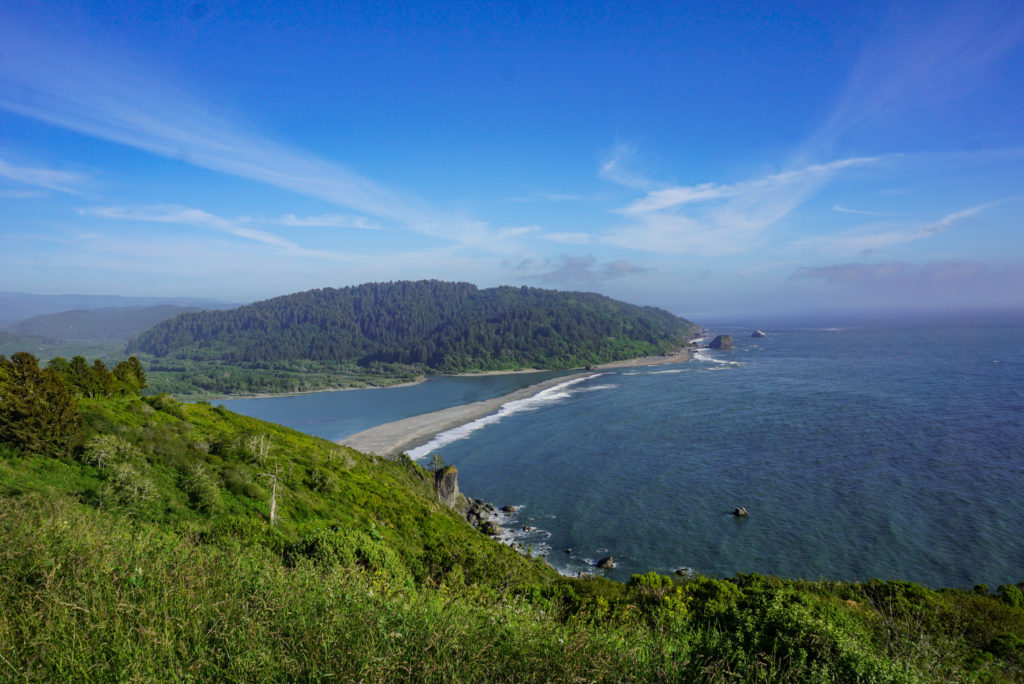
Follow Us on Instagram
Recent Posts
- 6 Amazing Urban RV Camping Experiences
- High Gas Prices Keeping You From RVing? Here are 5 Ways to Help!
- Our Top 5 Unique Fall RV Destinations
- Setting Up Your RV for Your First Camping Trip
- How to Make Extra Money by Renting Out Your Camper: Our Experience + Tips
best of the blog


IMAGES
VIDEO
COMMENTS
Are you wondering how fast you can tow your van? Our guide to caravan speed limits will give you all the information you could need.
David Motton shares his top caravan towing tips to help you stay safe and comfortable when you're on the road.
Towing a caravan offers the freedom to travel and discover at your own pace. However, adherence to regulations and safety guidelines. In this guide, we'll provide you with all the information you need to know before hitting the road.
Understanding the dynamics of towing This article is designed to give you an insight into what's going on when you are towing a caravan. No matter if it is your first time or you are seasoned veterans, I hope that there will be something here that expands your knowledge and helps you understand what's actually happening when towing.
Caravan Towing Course Whereas it isn't mandatory to go on a caravan towing course, taking one will provide you with some useful skills and improve your confidence when towing for the first time.
There's a lot to learn when you first enter the world of touring - we're here to help with our beginner's guide to caravanning.
Use this complete caravan towing checklist to make sure you've ticked off all of the essential tasks before hitting the road!
Here's how to safely tow a caravan or trailer. You mustn't overload the car or caravan. The weight of the loaded caravan/trailer must be within your car's towing ability. The combined weight of the loaded car and loaded caravan/trailer must be below the maximum 'train' weight for your car. The Caravan Club or the Camping & Caravanning Club can ...
Learning to tow your caravan. We believe everyone would benefit from some professional towing tuition; the Club runs a number of one and two-day courses. They will take you through all the basic information you need from hitching up your caravan and car to reversing. We'll add some important advice on safe caravanning too.
The ultimate guide to towing a caravan. Beginners learn to prepare the caravan, hitch and unhitch, drive, manoeuvre, reverse and much more.
All the information you need to know when towing a caravan, from licences to towing weight to width and length rules and handy tips and advice
Whether you're towing a trailer or a caravan, here are some of the basics you need to remember to travel safely on the road.
Before you purchase your caravan you should be looking to learn how to tow a caravan. Hopefully this post and video series will give you that information.
In this ultimate guide to towing series, Robert Pepper discusses how to remember the steps to hooking up your caravan and what to expect when towing a caravan for the first time, including turning, climbing hills, braking, visibility and more.
When towing a caravan or trailer, you will often need to abide by different speed limits to those which apply in normal, everyday driving. And confusingly, the speed limits for cars which are ...
This ultimate guide on how to tow a caravan answers questions such as, can I tow a trailer? And, what weight can I tow? Learn more and travel safely.
Towing a caravan can be hard as you have to keep your speed steady and watch for adverse weather conditions. All these elements can cause your caravan to bounce, snake and even tip. Knowing when it is too windy to tow a caravan can be based solely on the wind speeds. Speeds between 25-30 miles...
RV Trip Planner - AI-powered trip planning for RVers. Powered by AI and what we've learned from 38 million trips, Roadtrippers Autopilot™ plans your trip for you. Premium members enjoy the ability to add more stops, explore alternative routes, and discover hidden gems along the way. Stay ahead of the curve with real-time traffic updates ...
Regardless of whether you're towing a caravan with full water tanks, you still need to make sure your load is evenly distributed for those times when you do travel with them empty.
TowCarCalculator. Use our TowCarCalculator to ensure that your outfit is legal, safe and comfortable to tow. On top of that we will give you insight on the performance of your combination! View and compare the performance of several TowCar and Caravan matches. The TowCar.info online TowCarCalculator provide you with all the information you need.
California RV Route and Trip Information - Follow Your Detour. Even though we spent 6 weeks in California, it wasn't nearly enough time for this incredibly beautiful state. You will notice we missed some of the most popular destinations that California has to offer, such as Yosemite National Park, Lake Tahoe, Sequoia National Park, the Sierra ...
Rent an RV, motorhome, trailer, or campervan from Outdoorsy for your next adventure. Outdoorsy is the #1 most trusted RV rental marketplace in the world
When it comes to living in an RV full-time, perhaps the biggest challenge is finding a suitable place to park the vehicle, and this is where city and county laws and ordinances come into play.